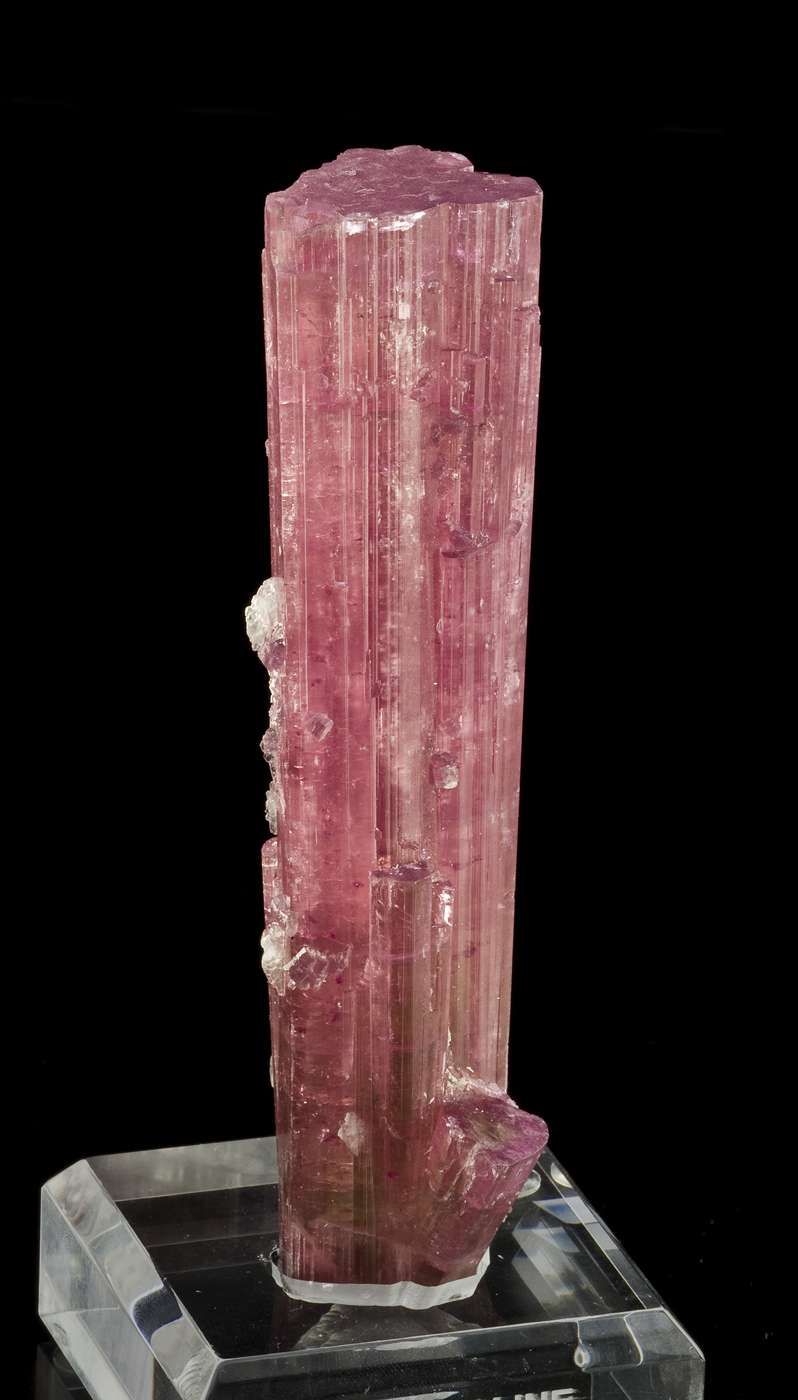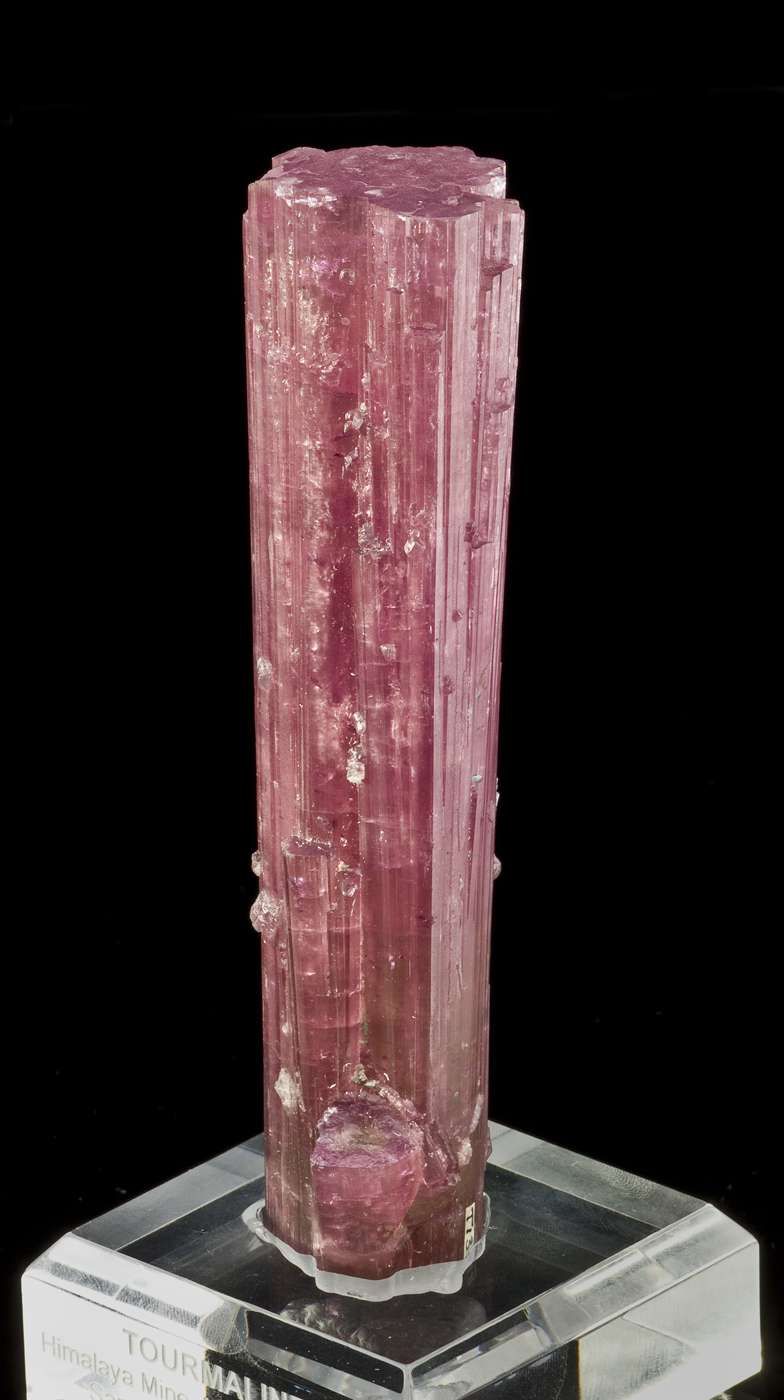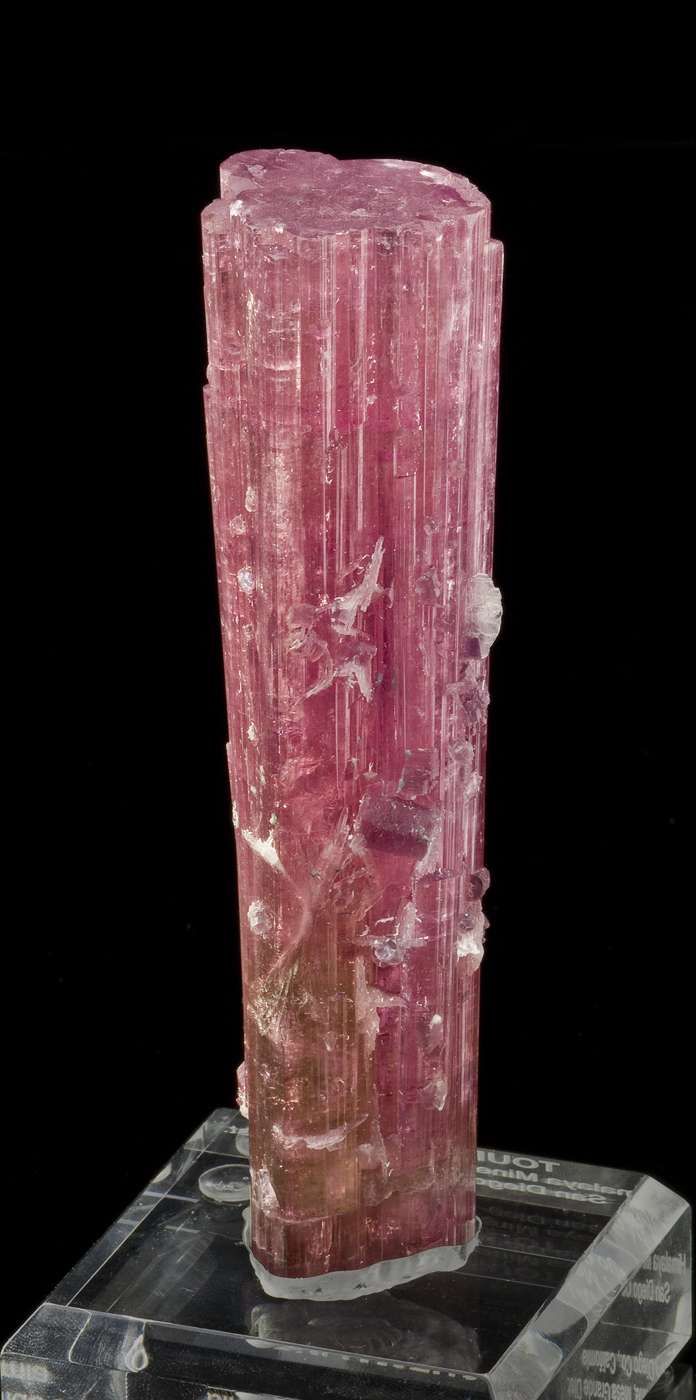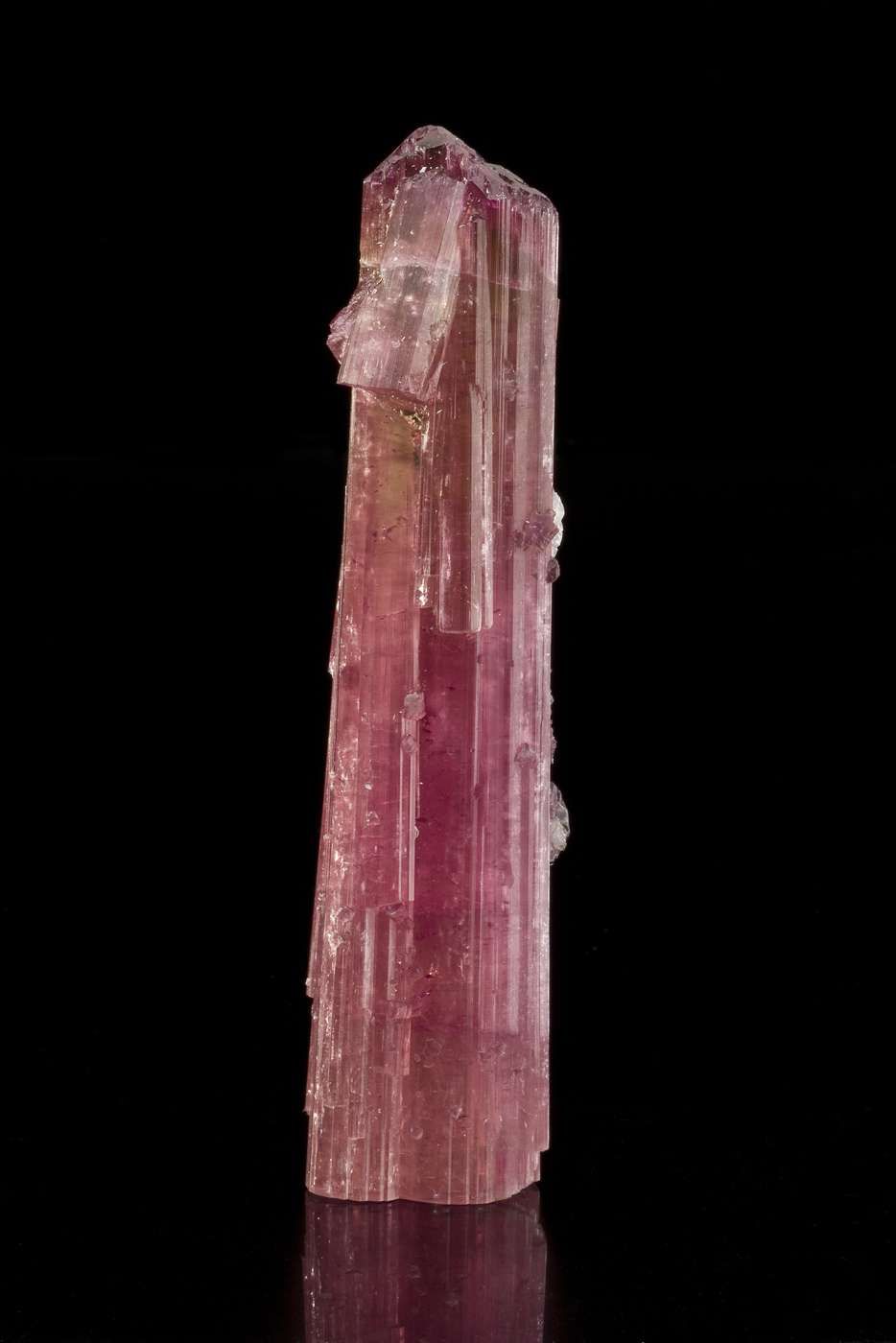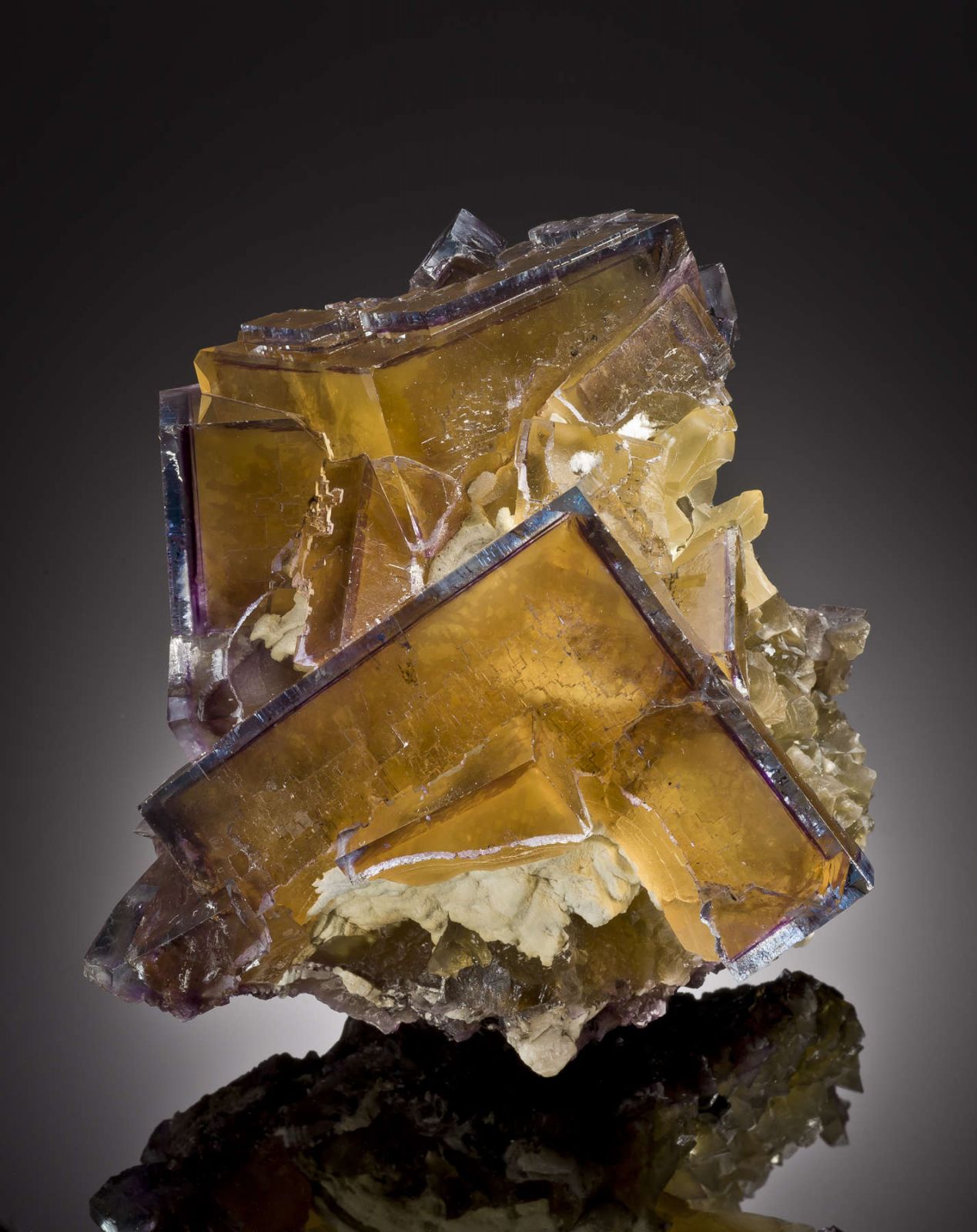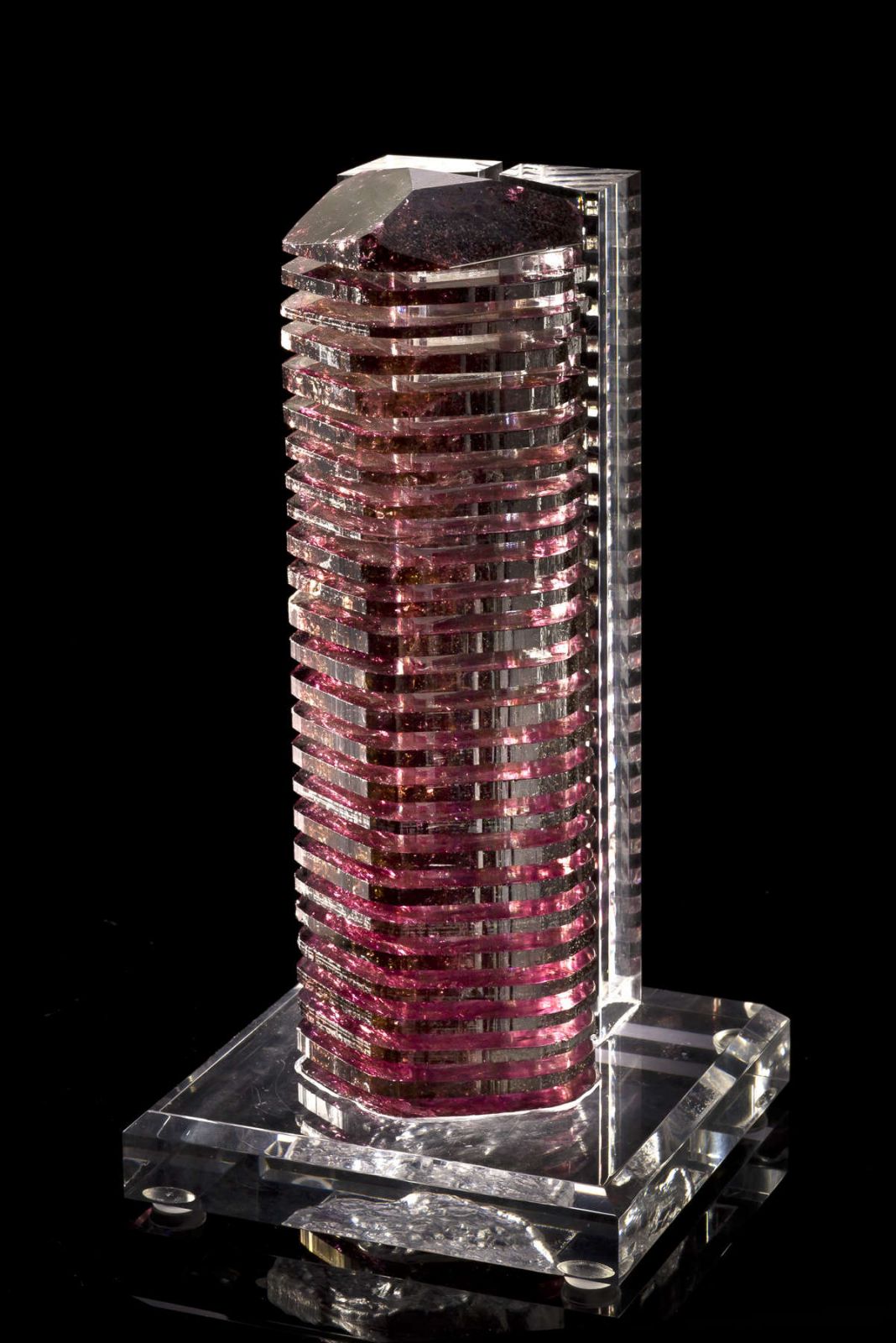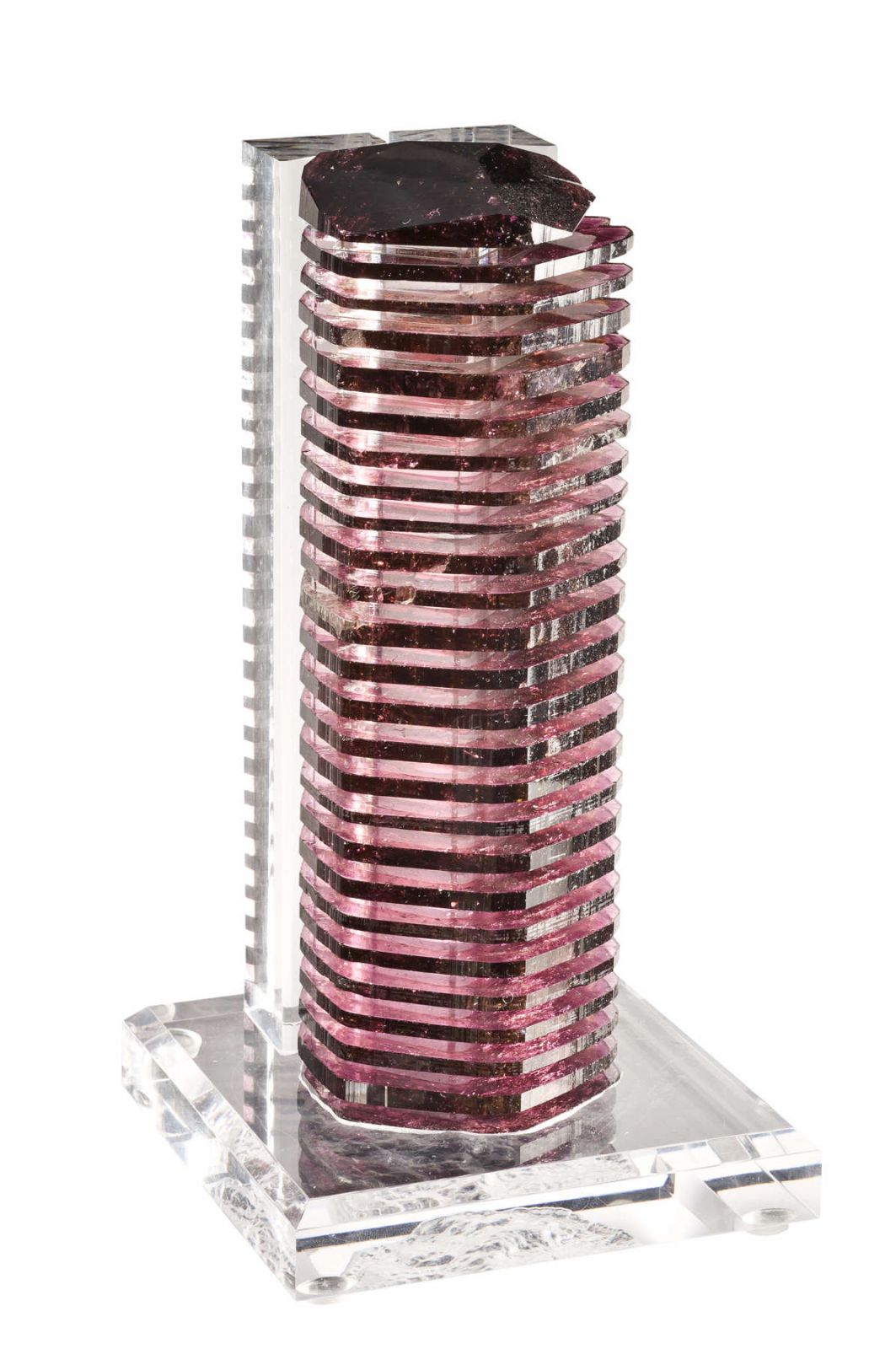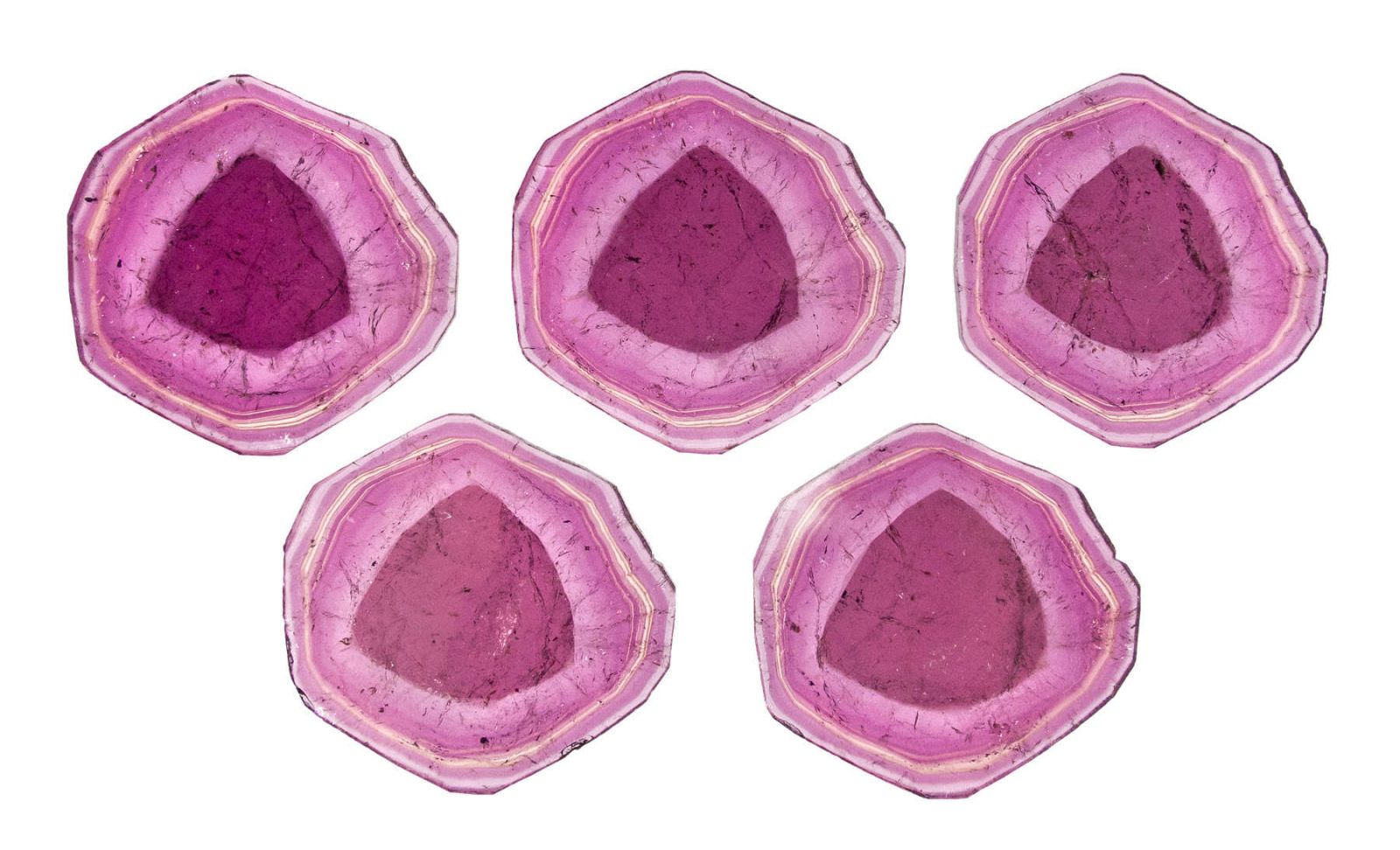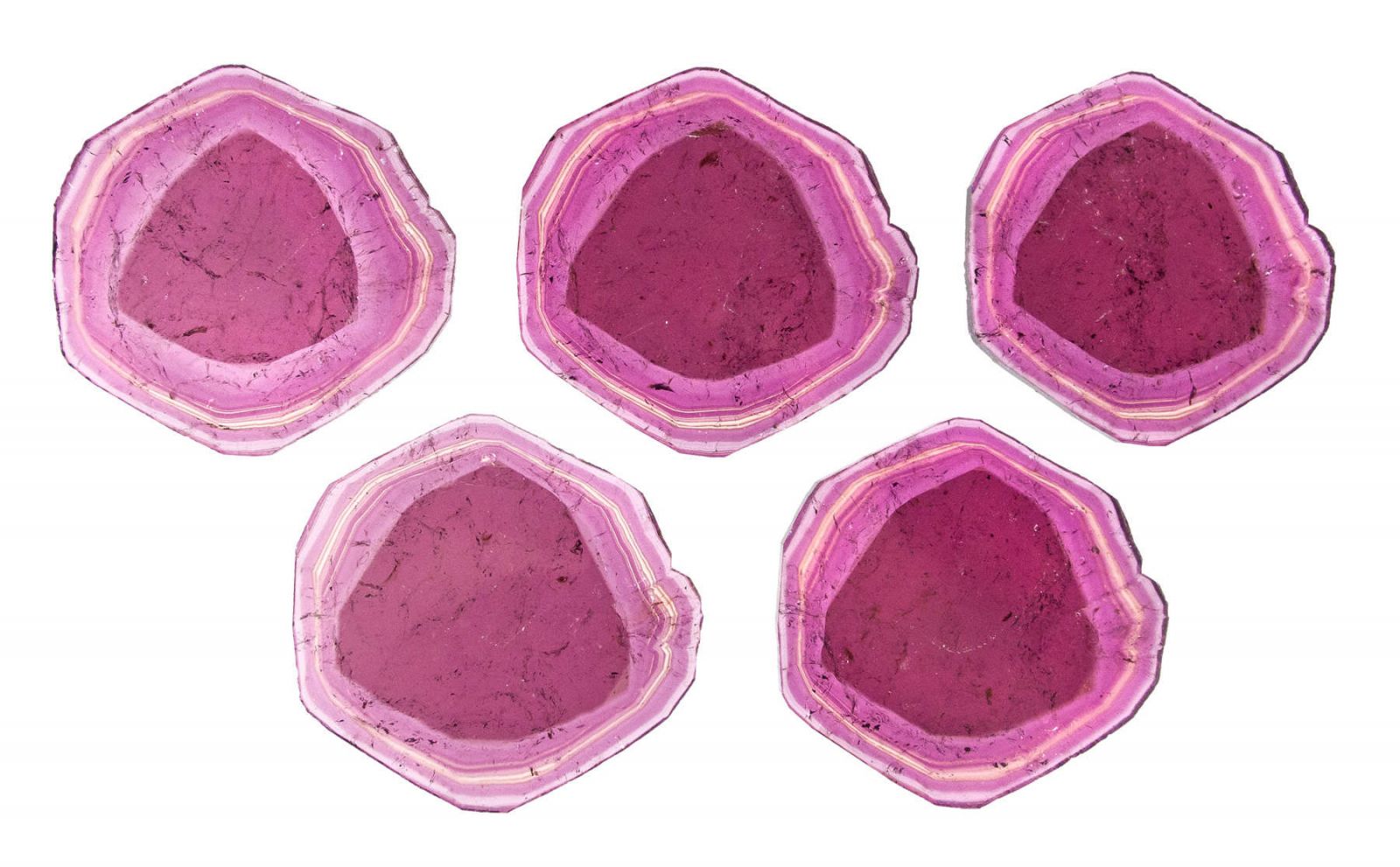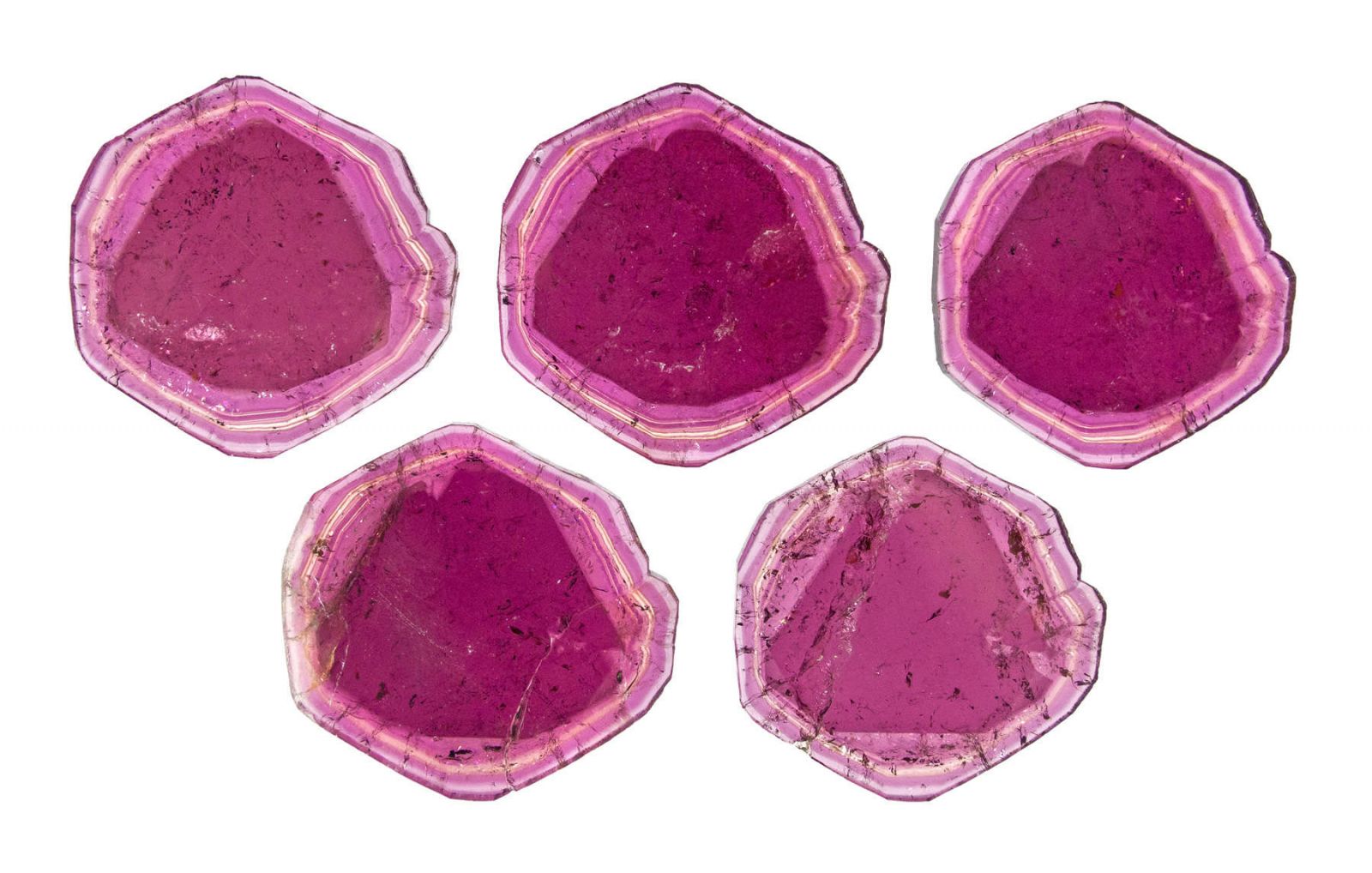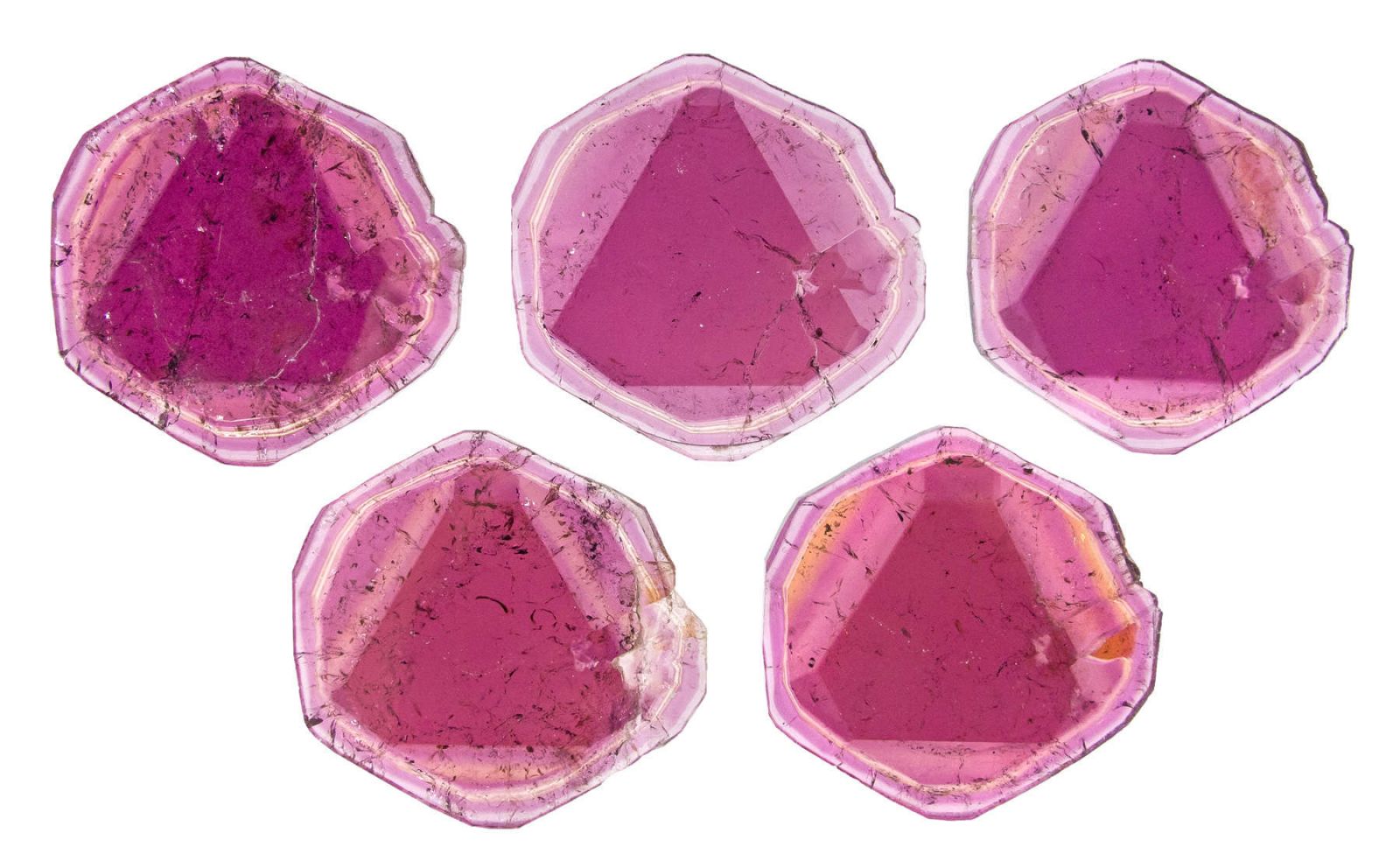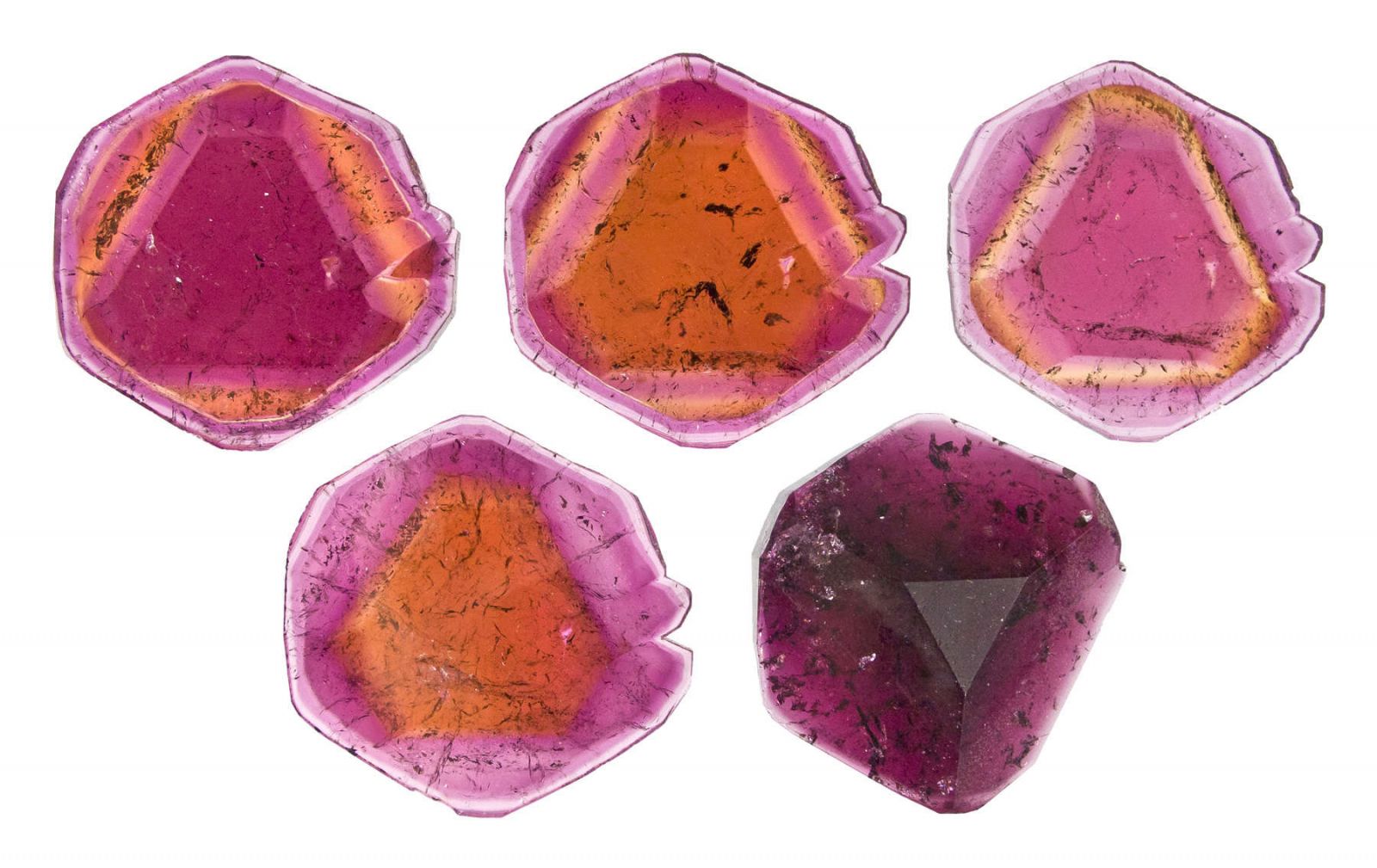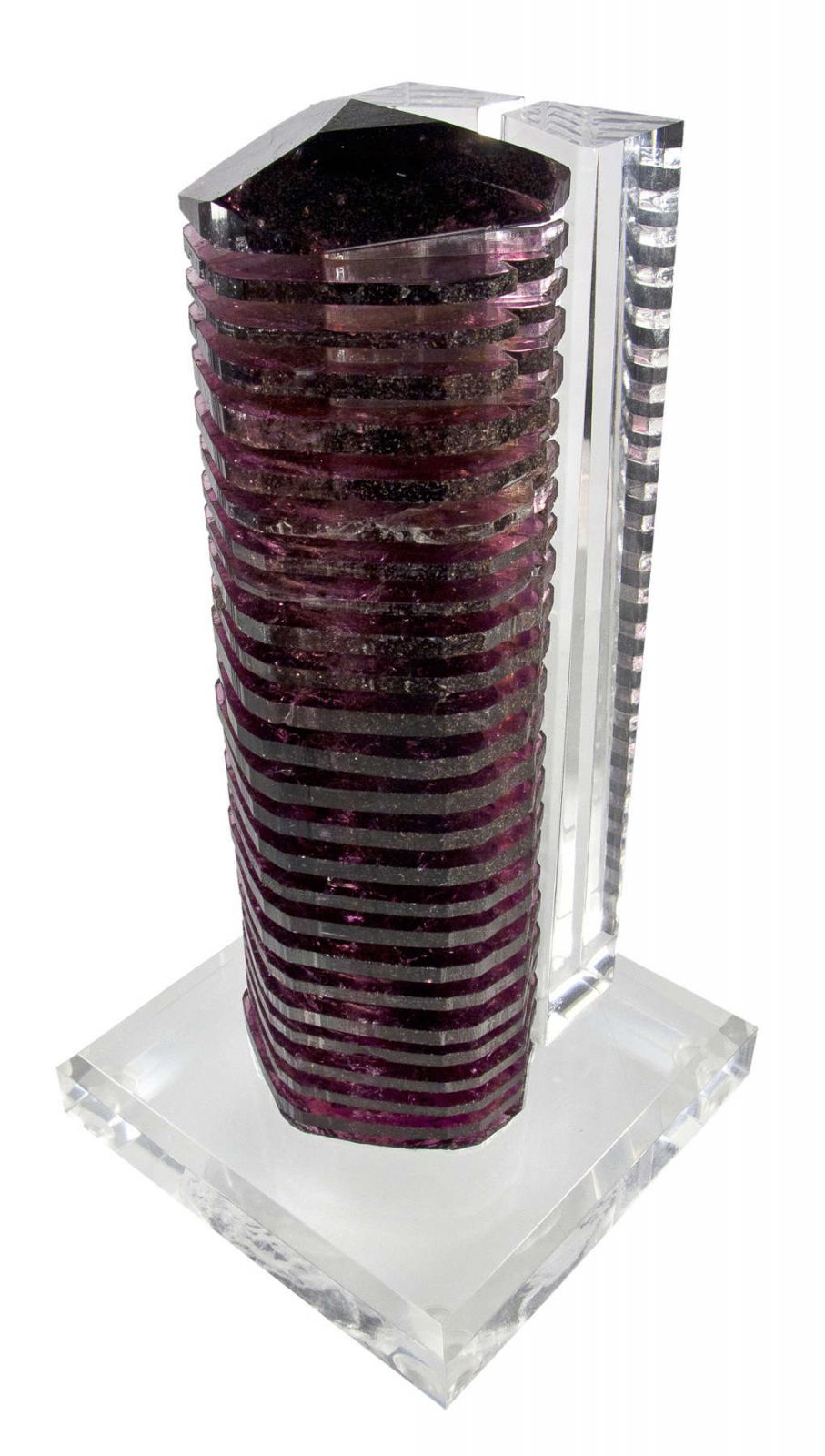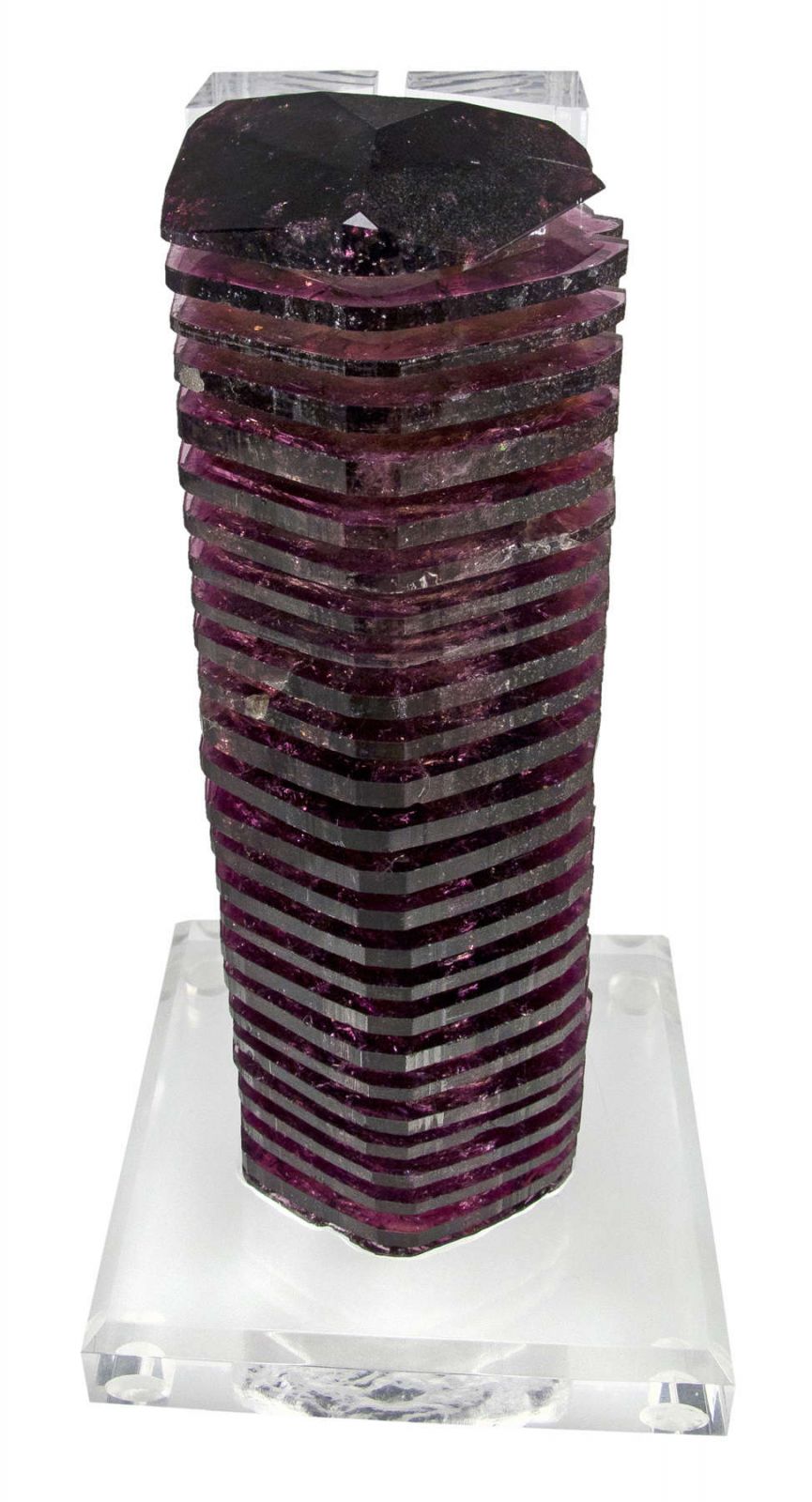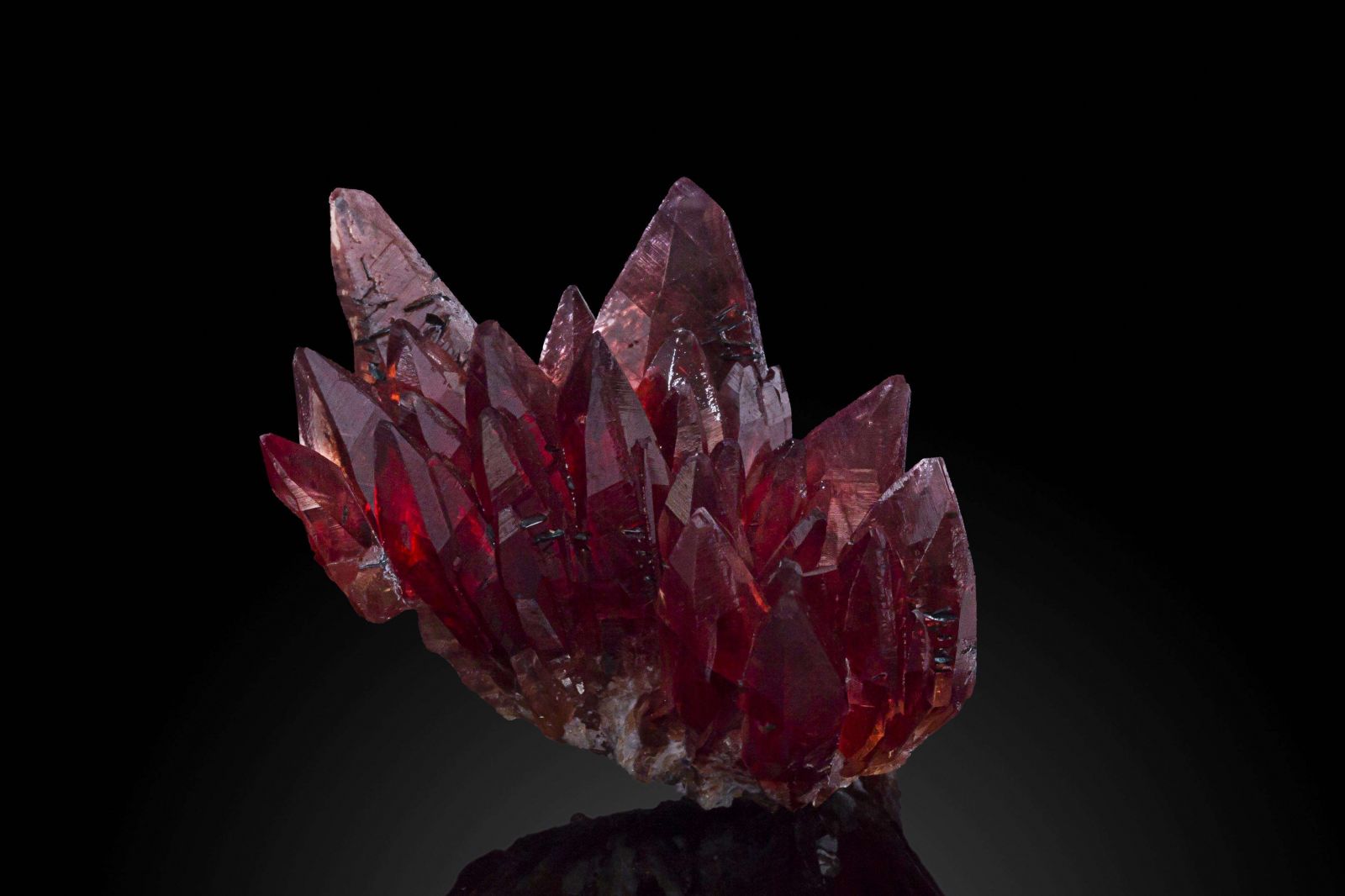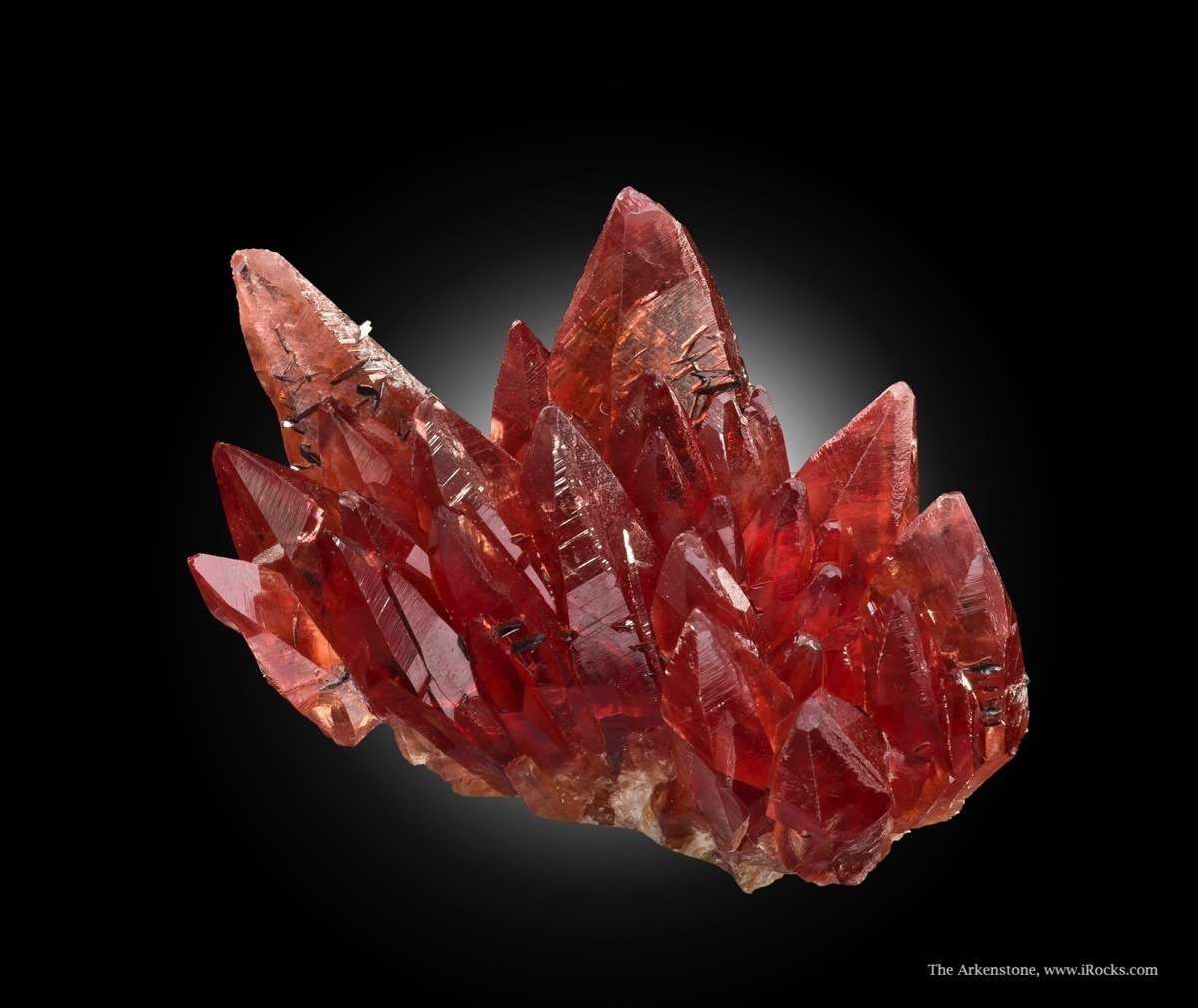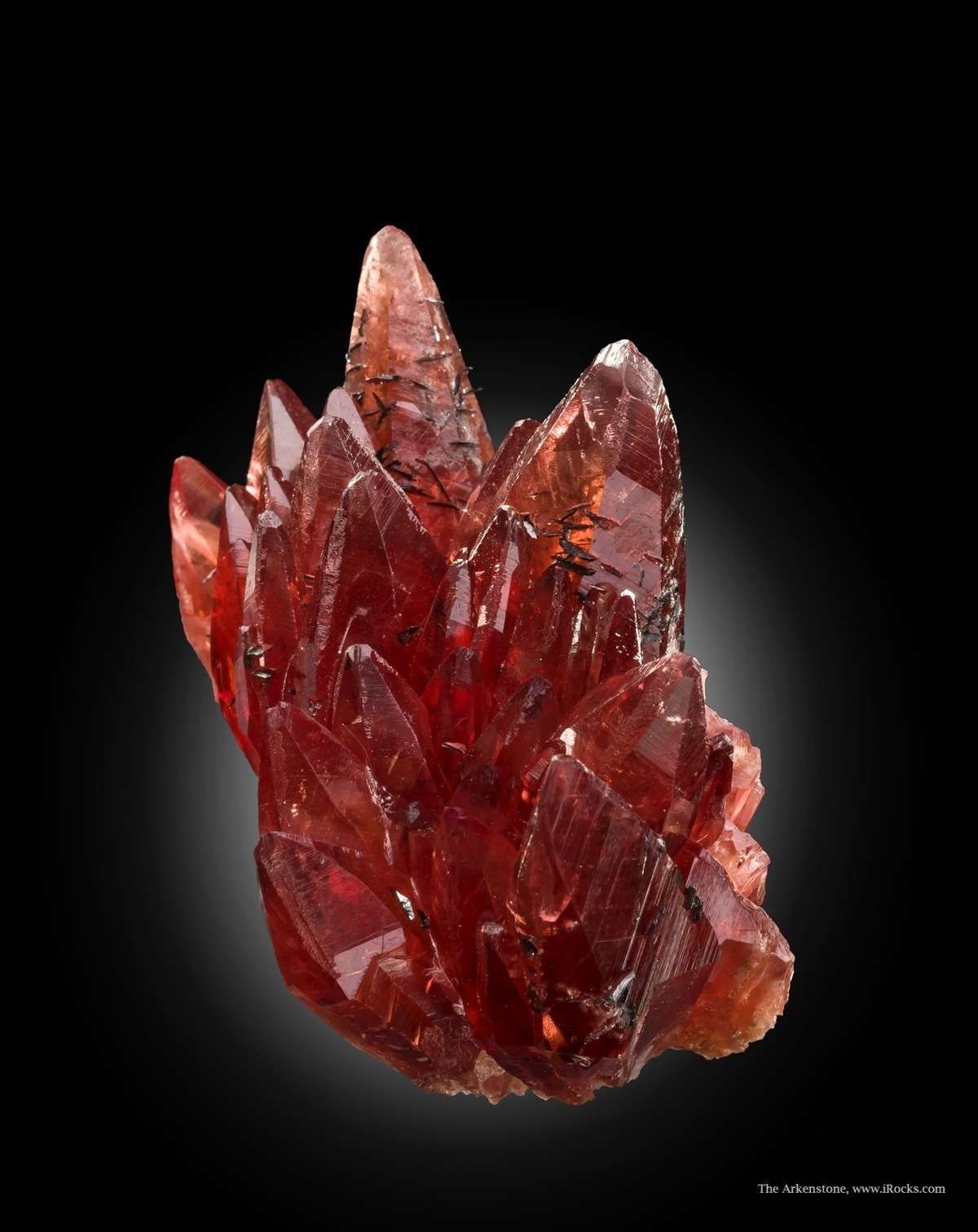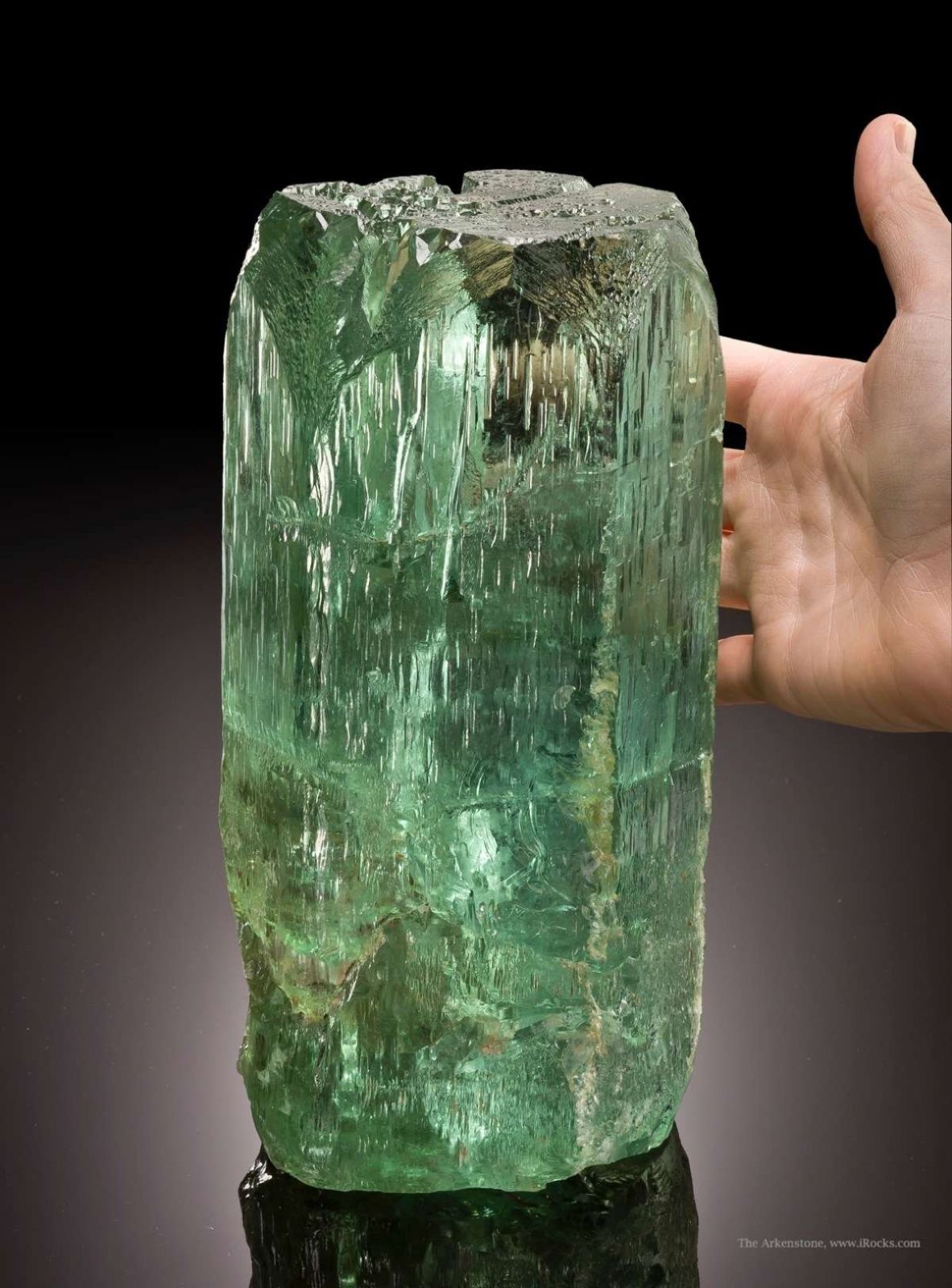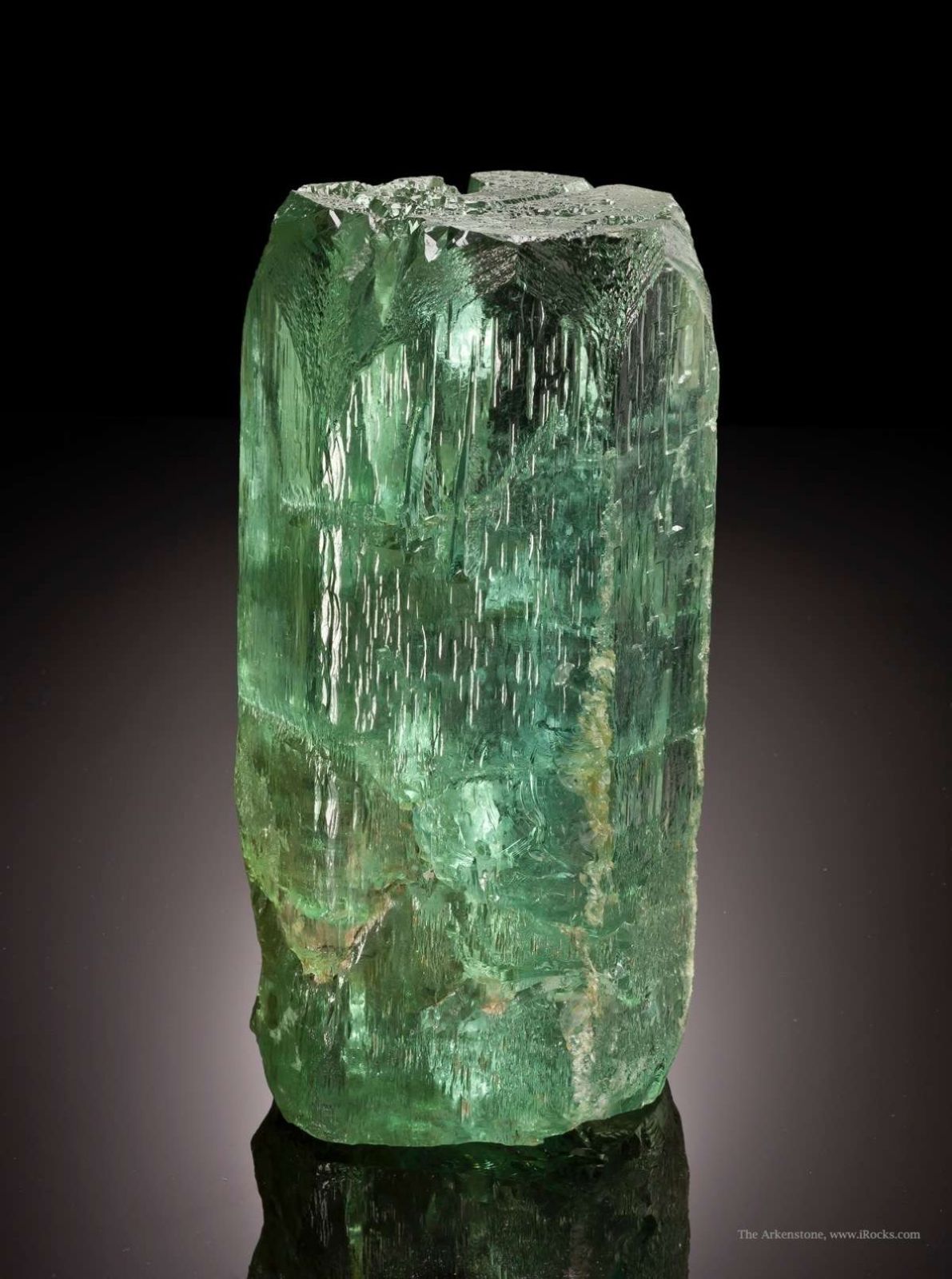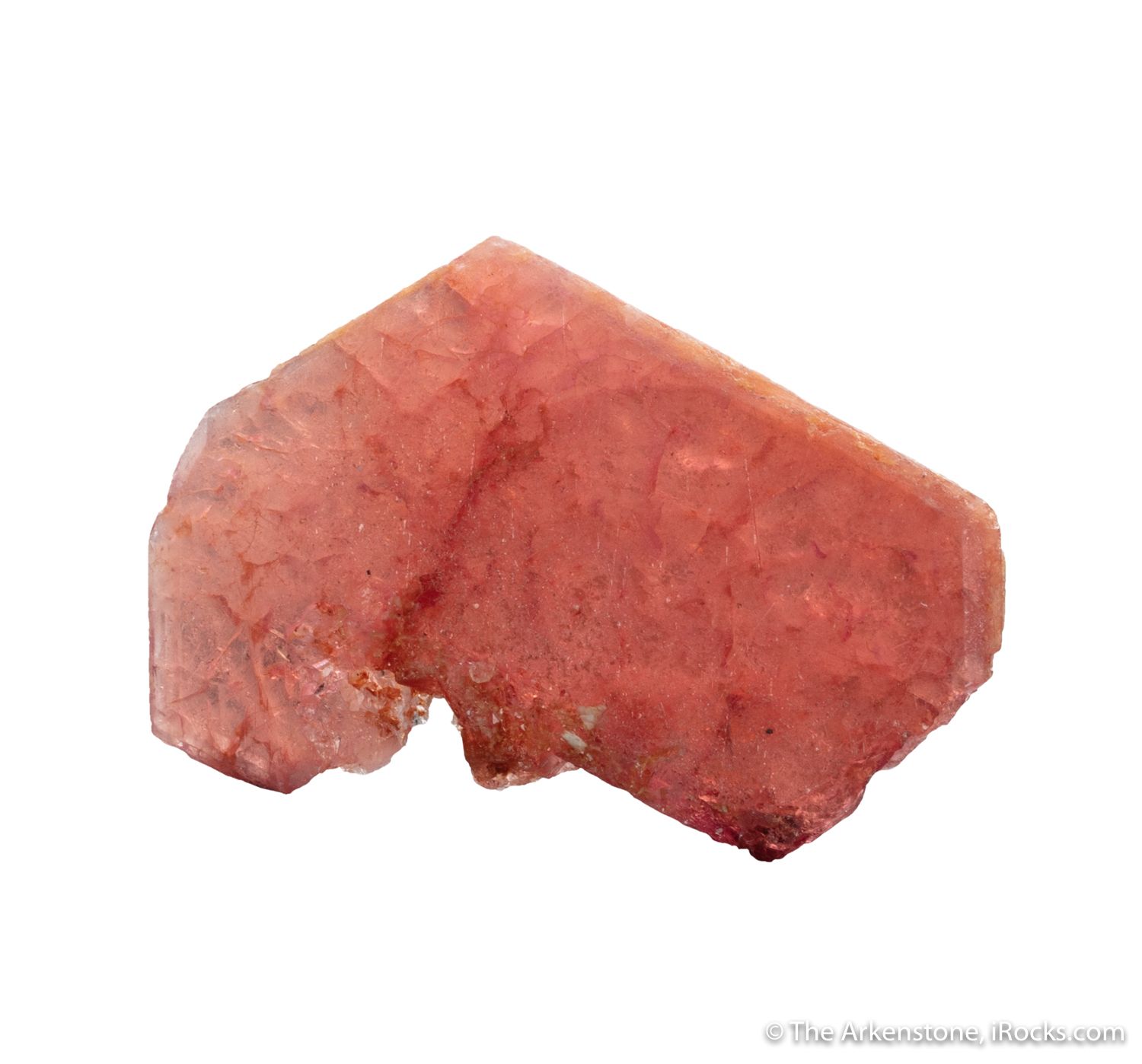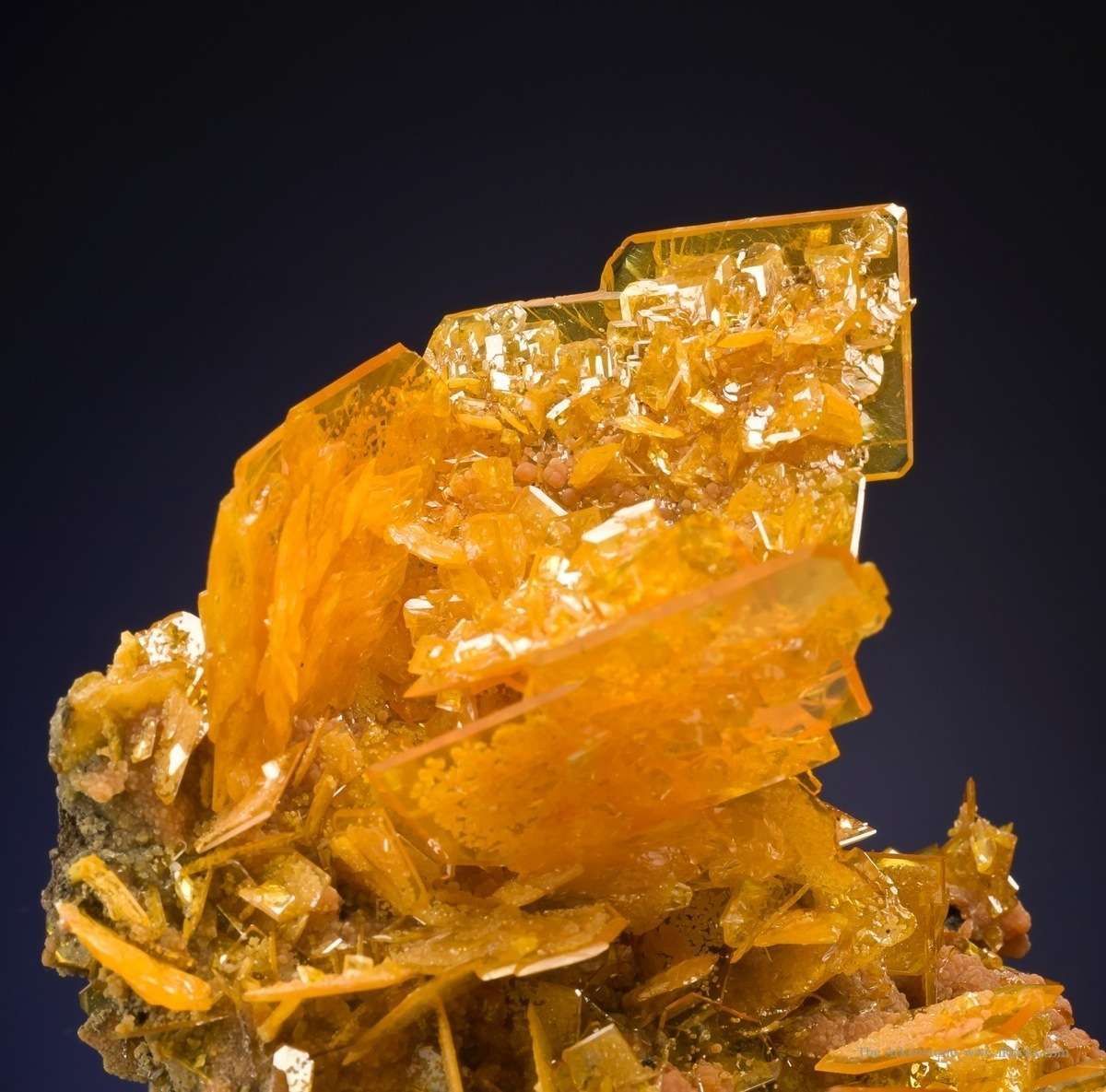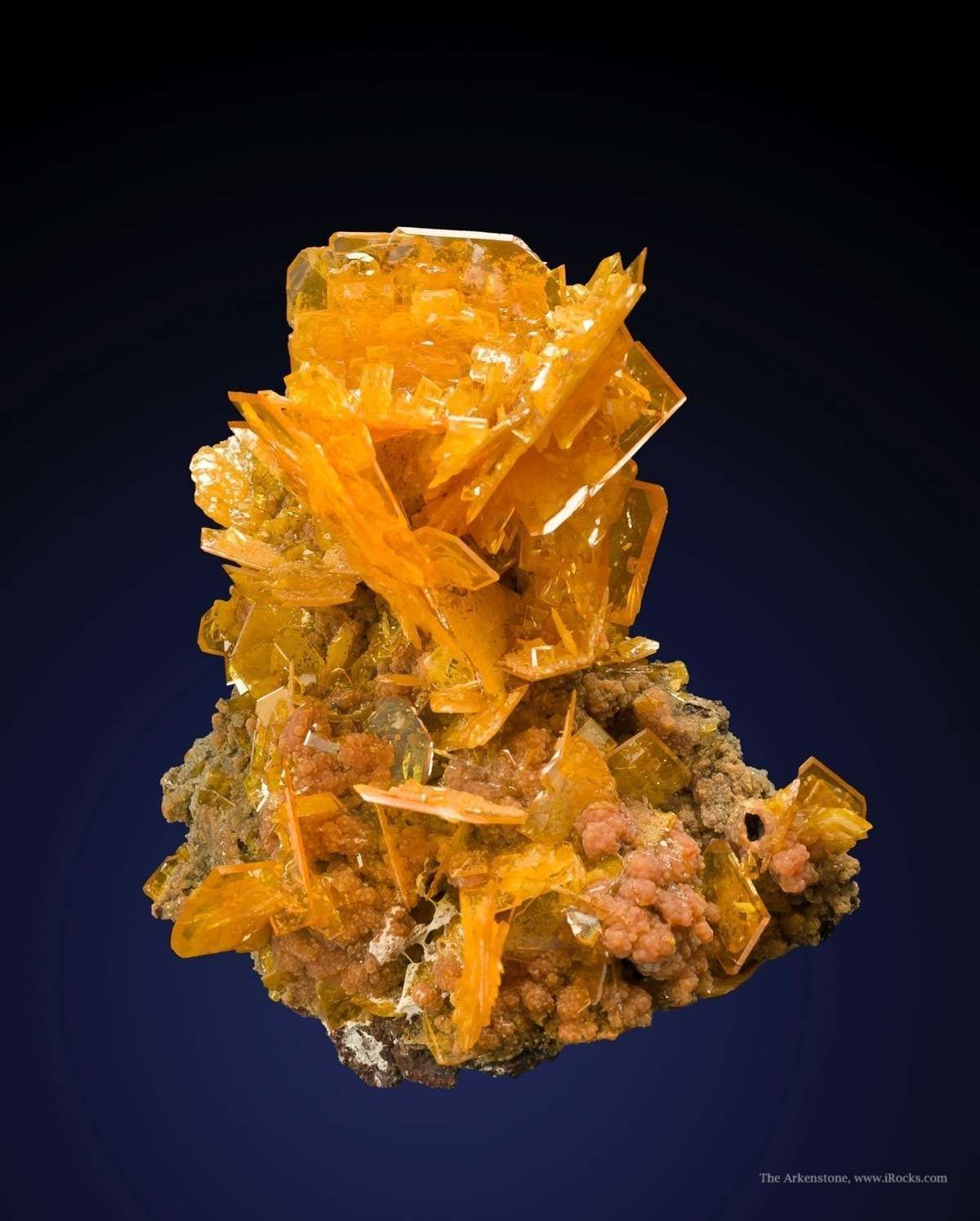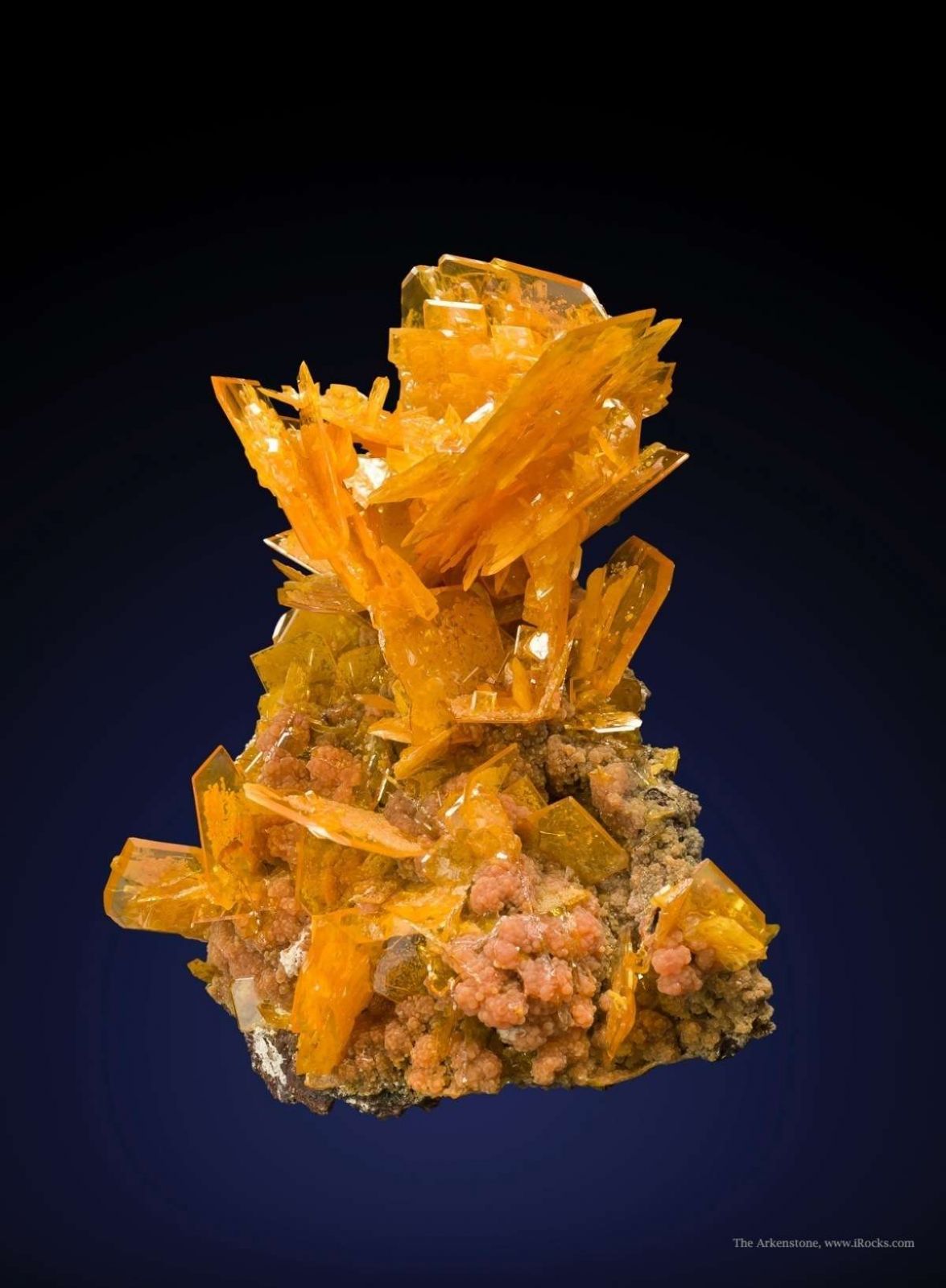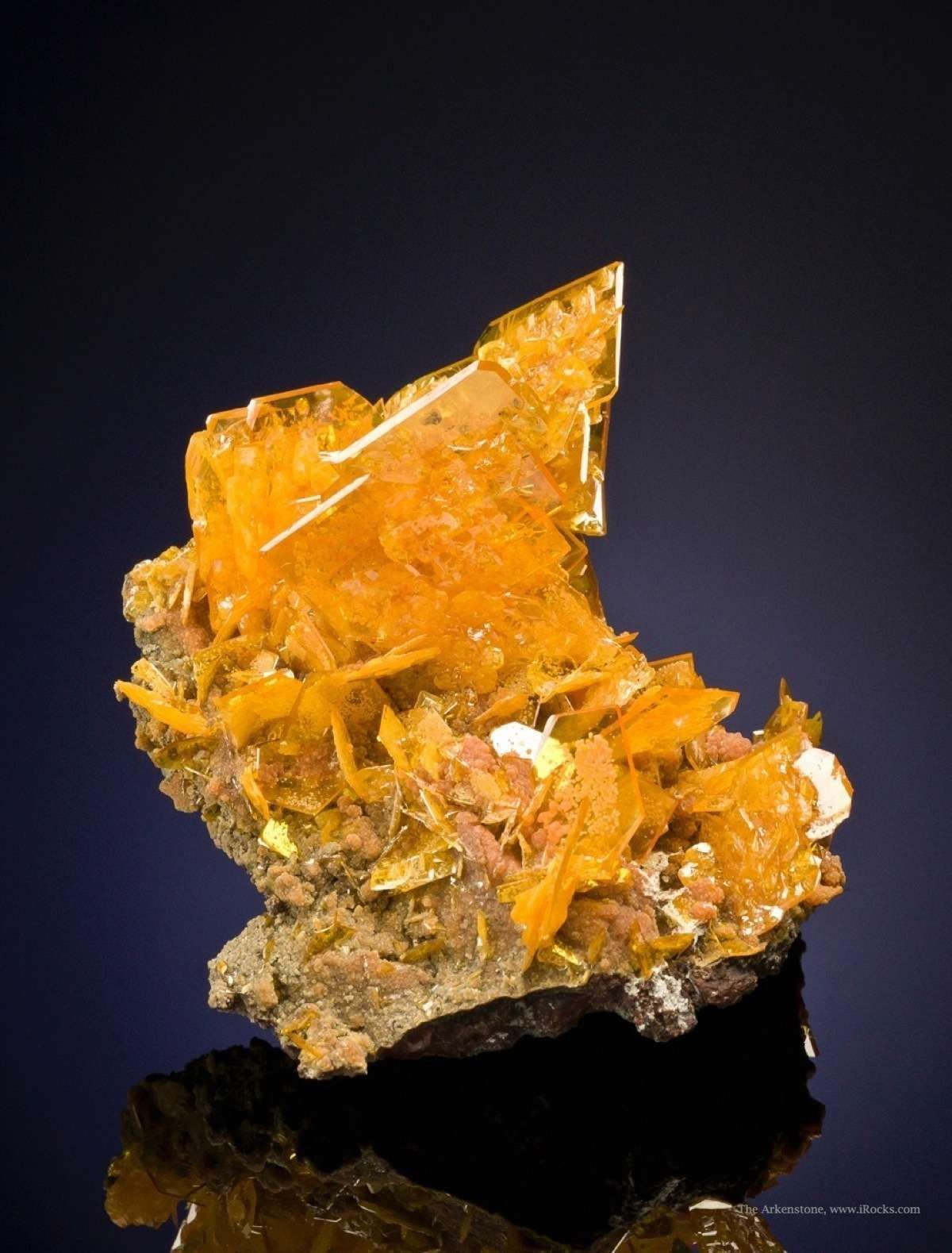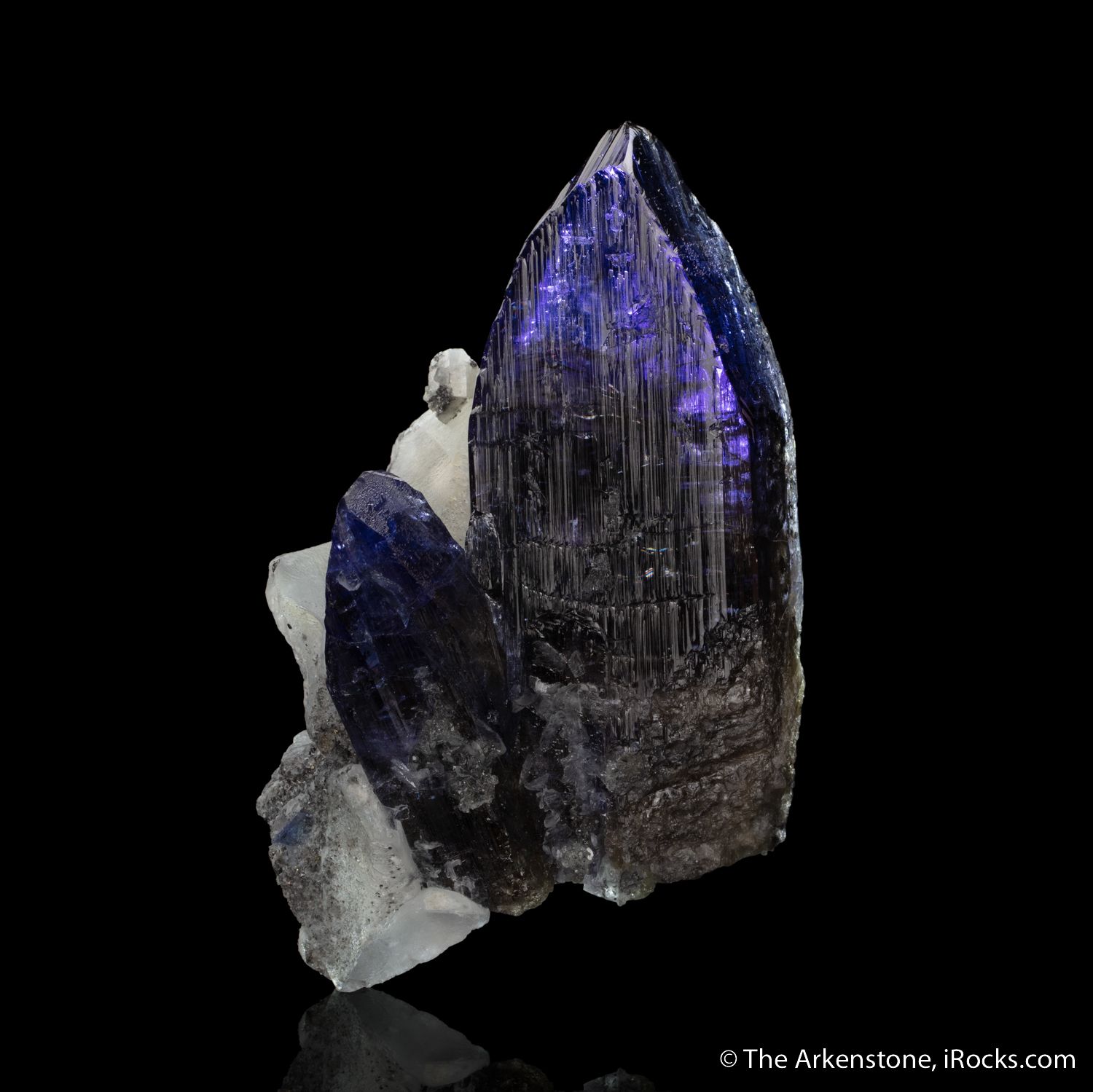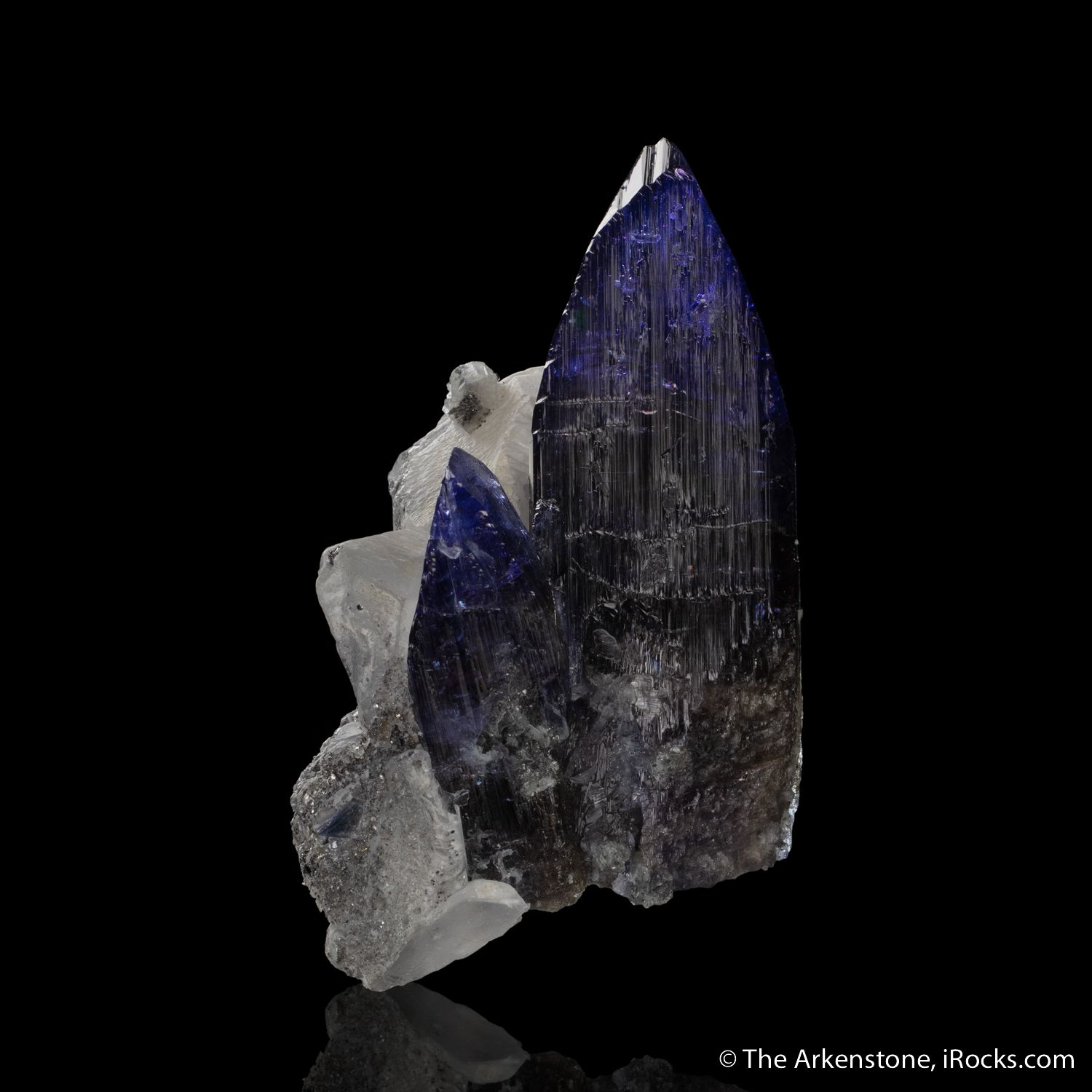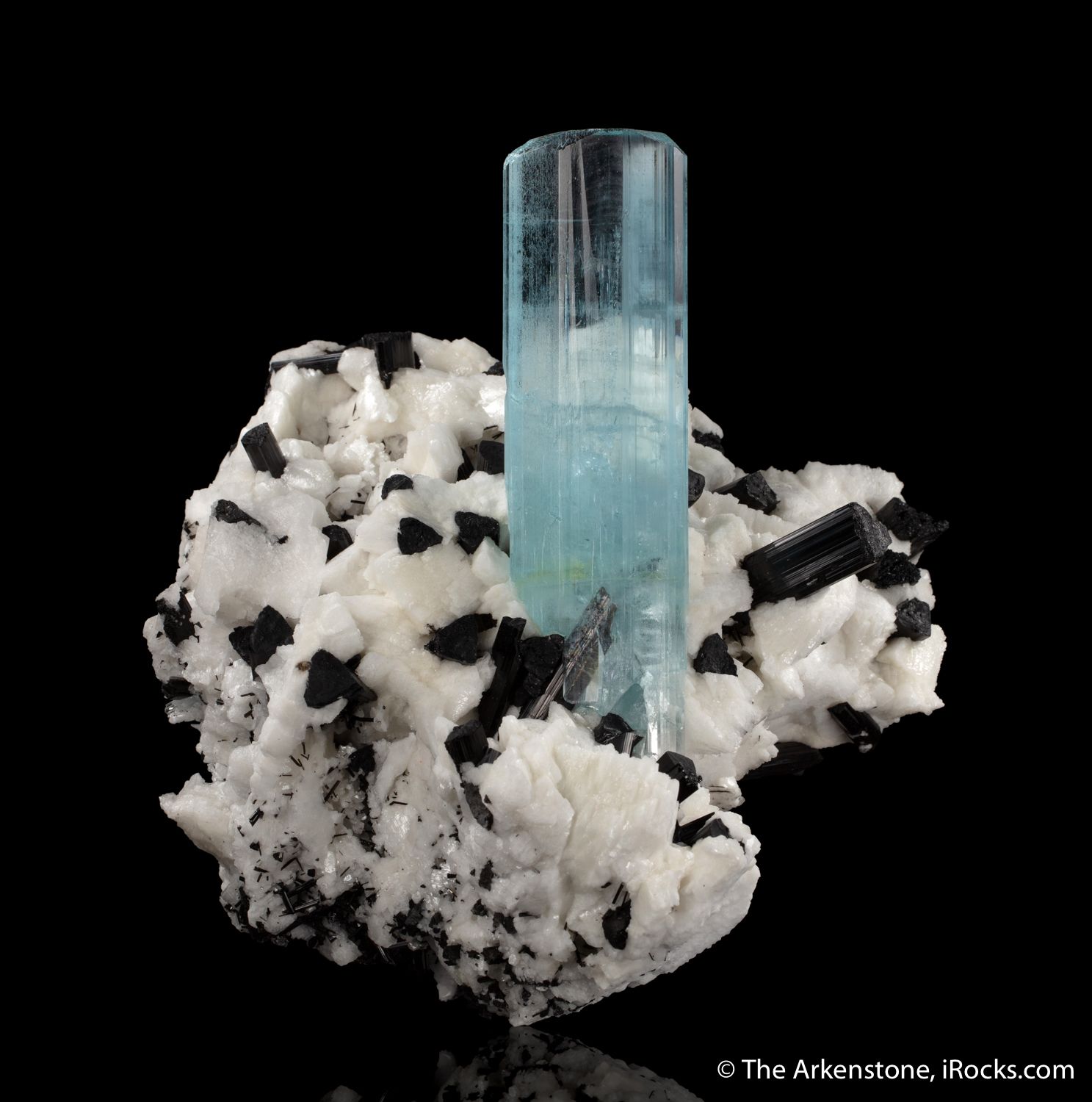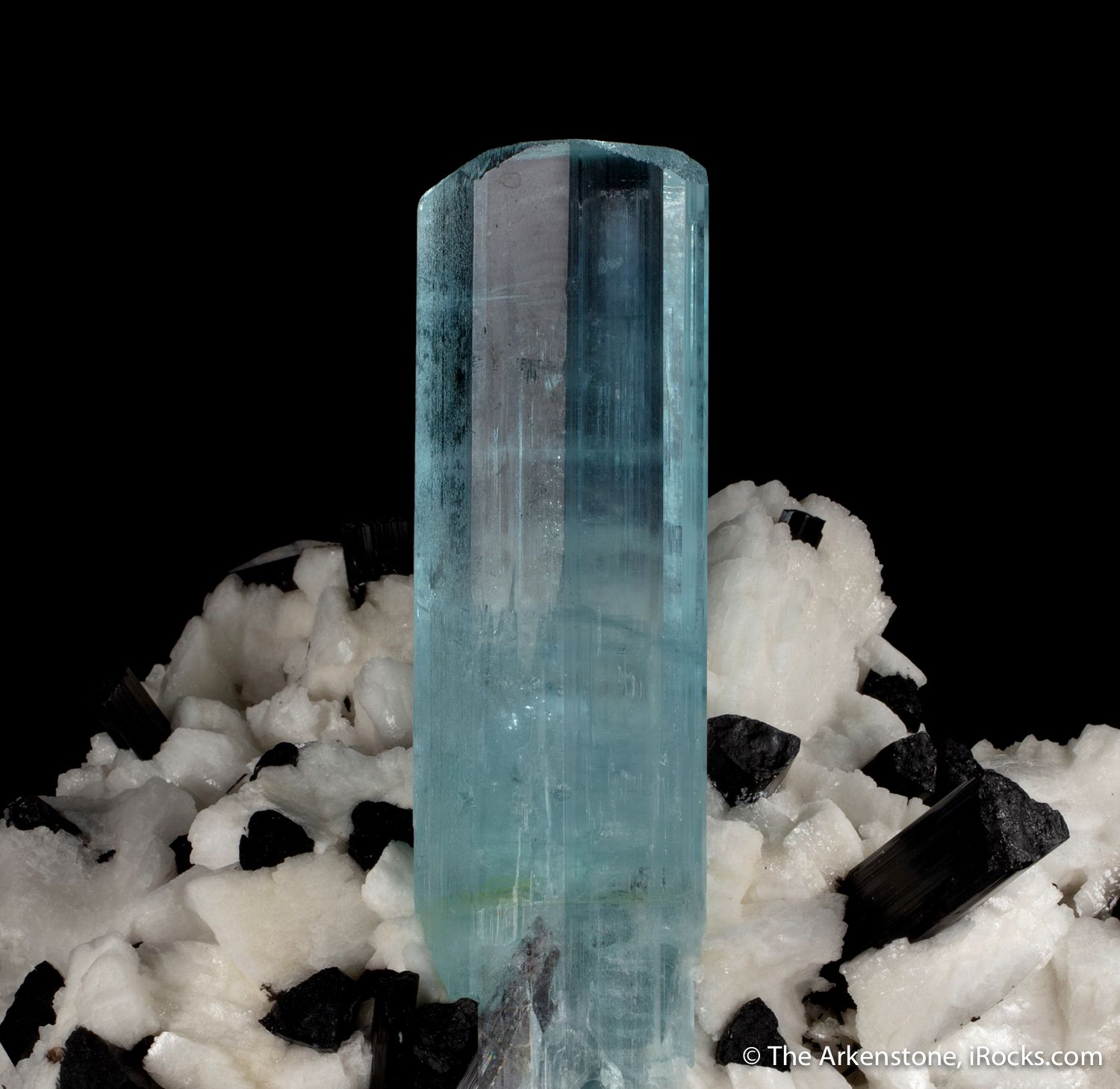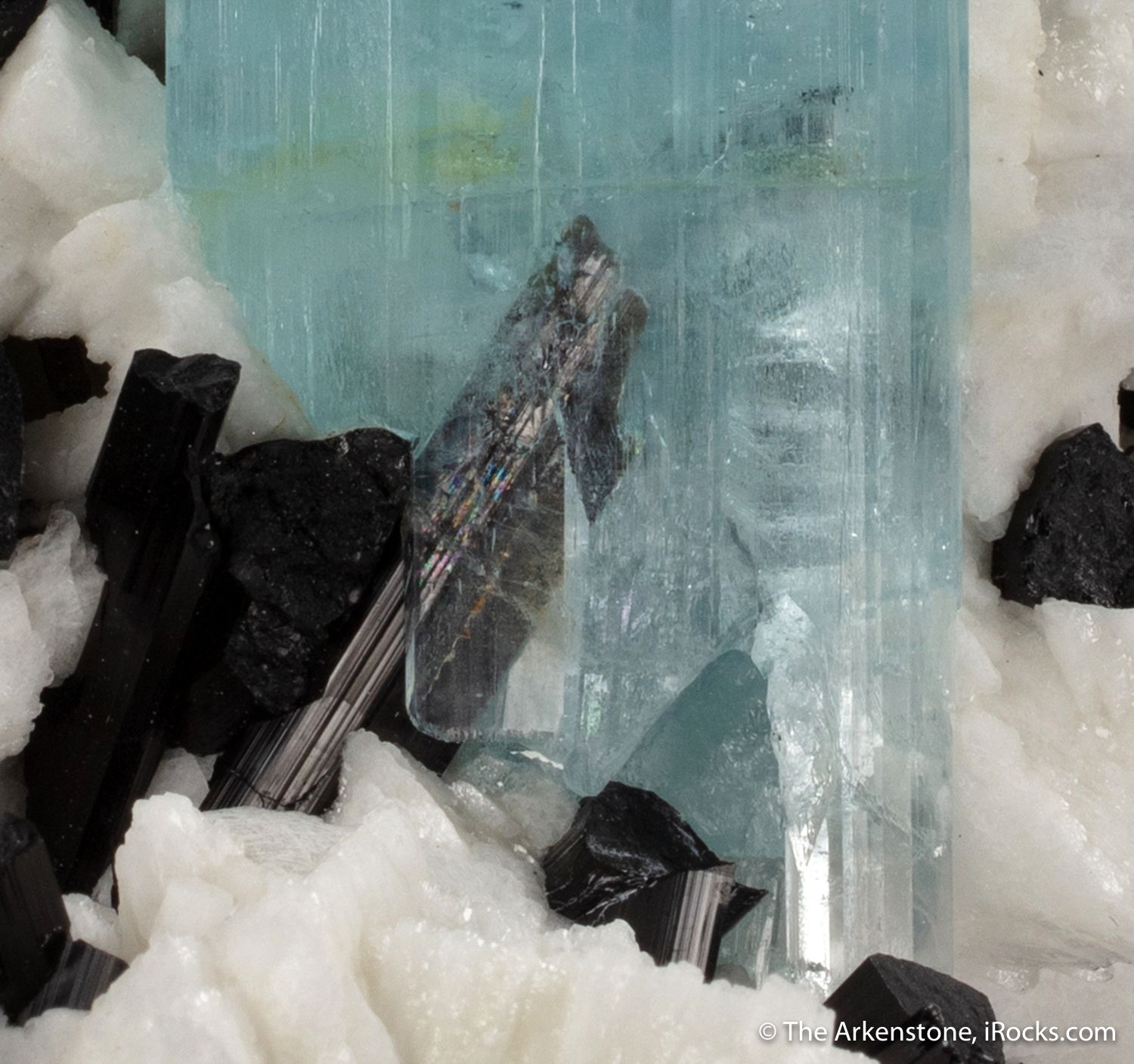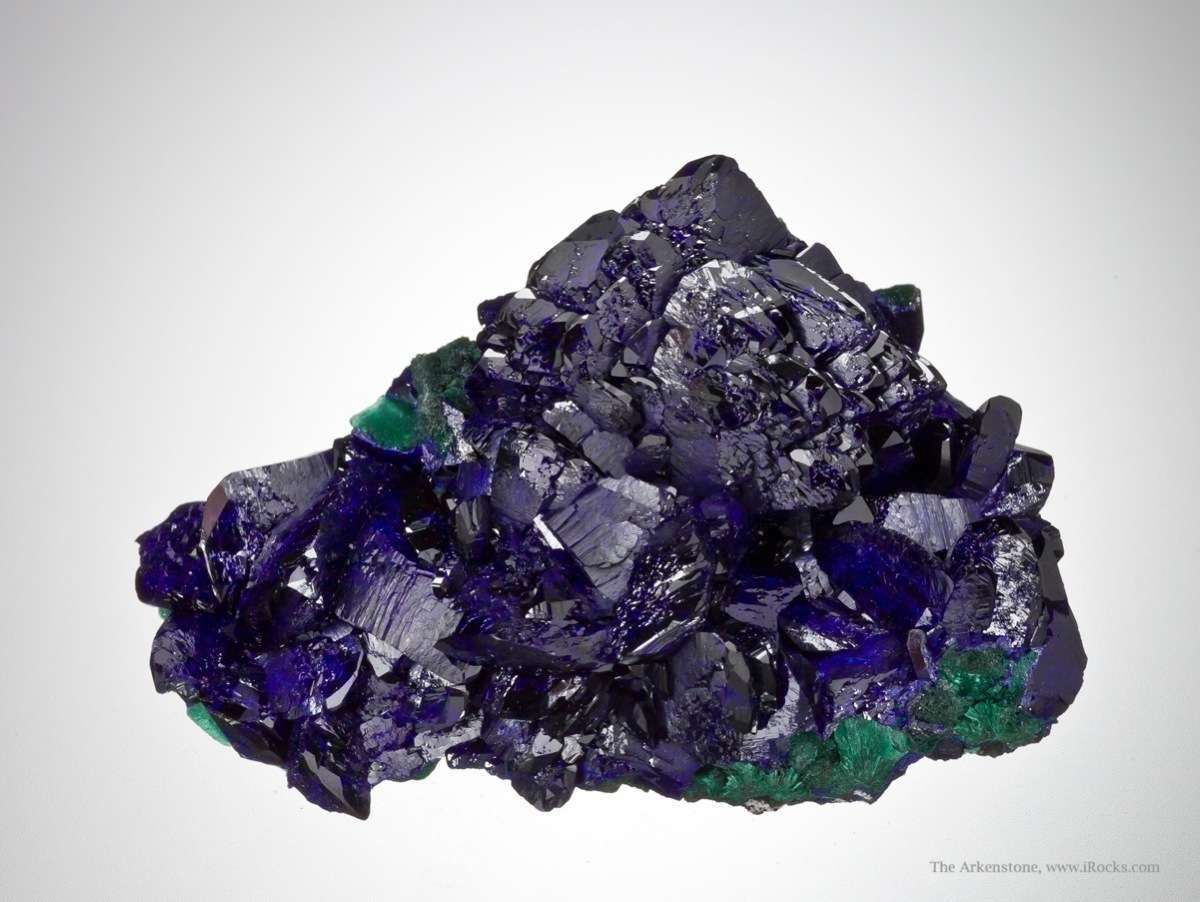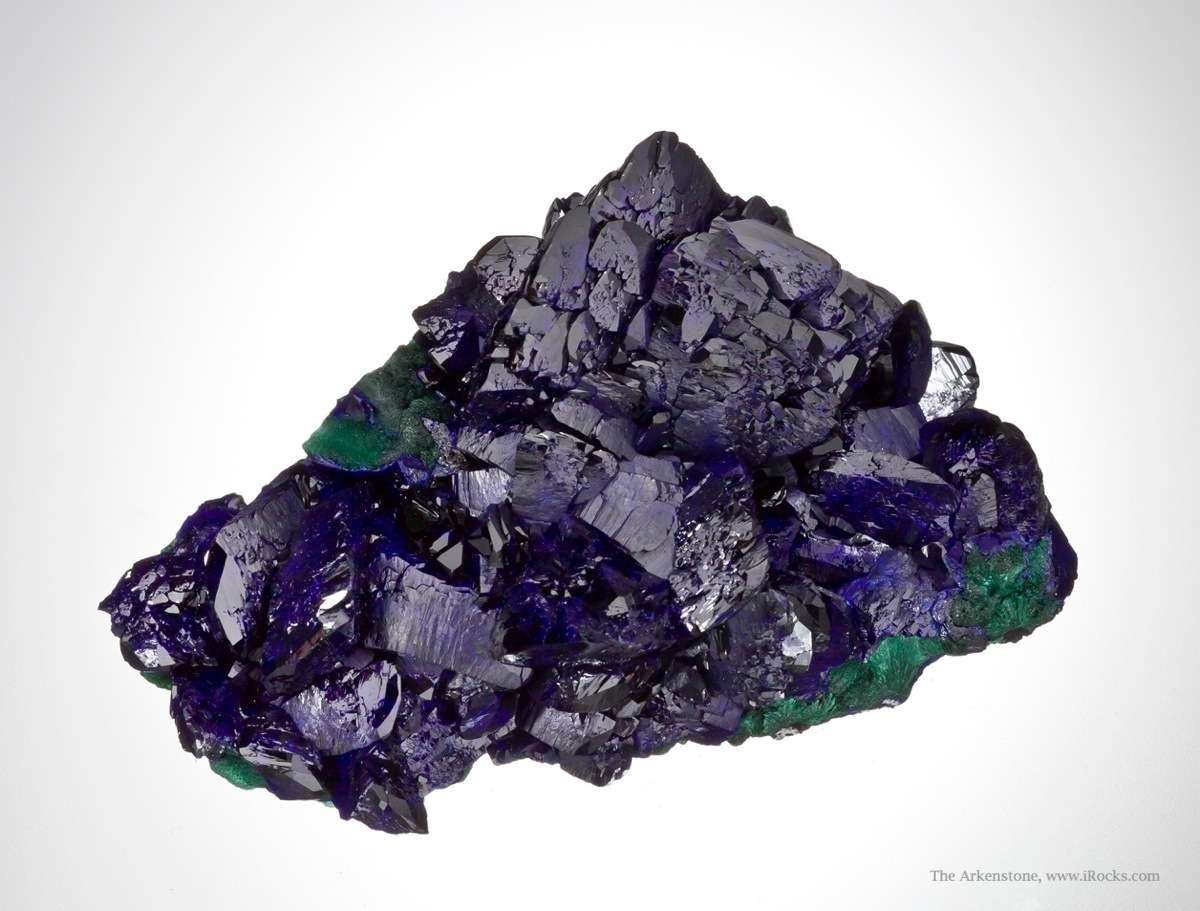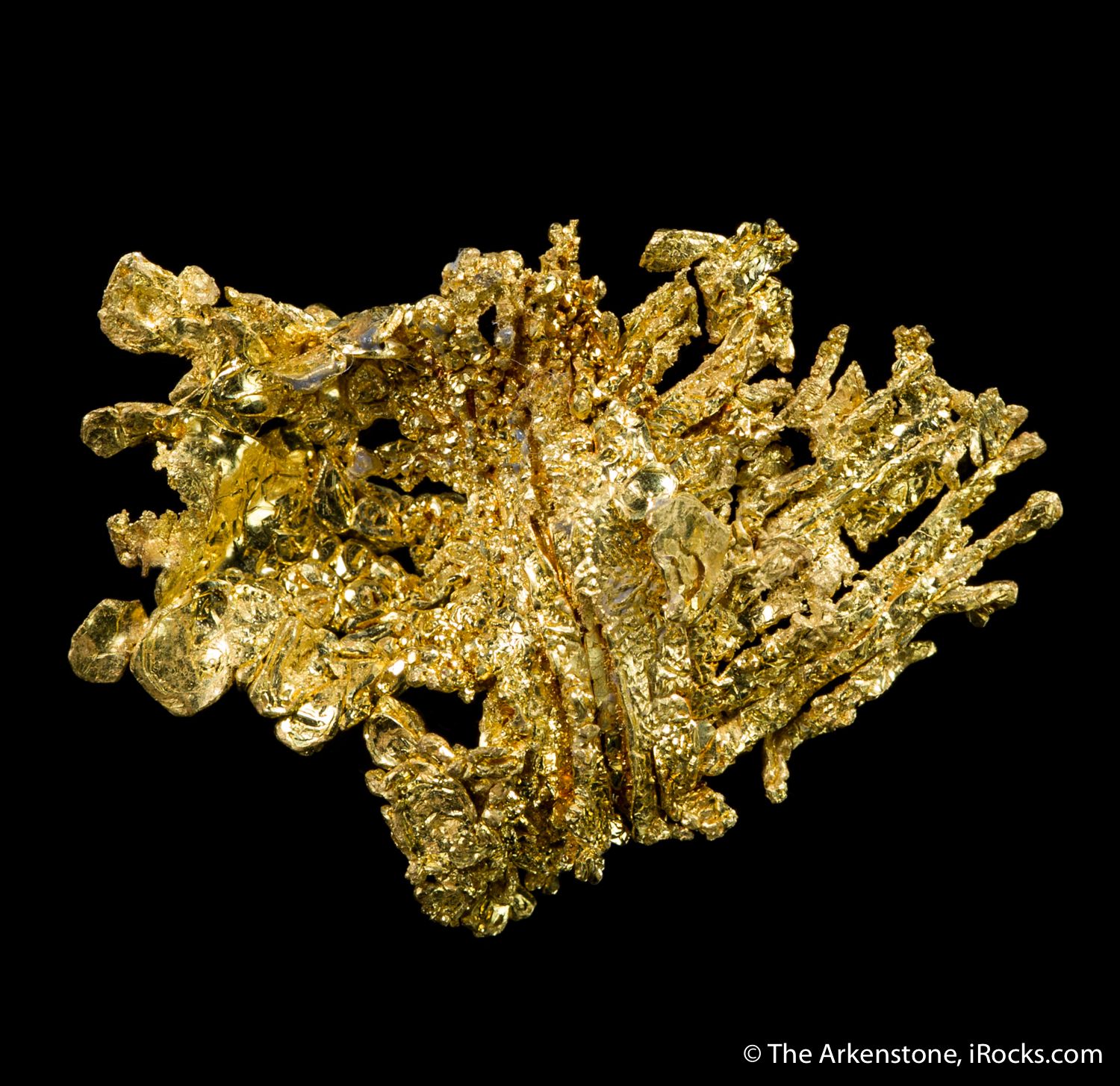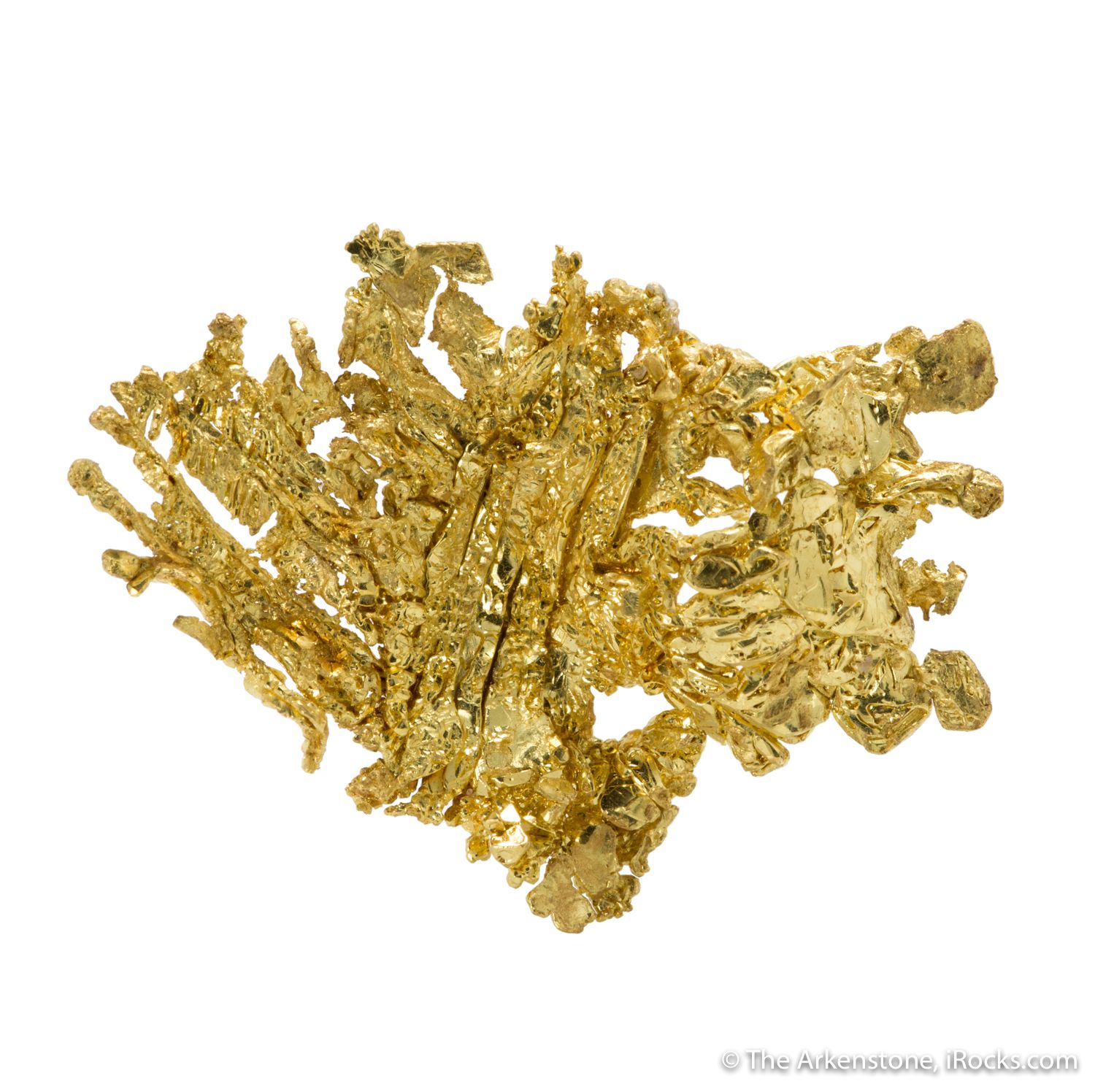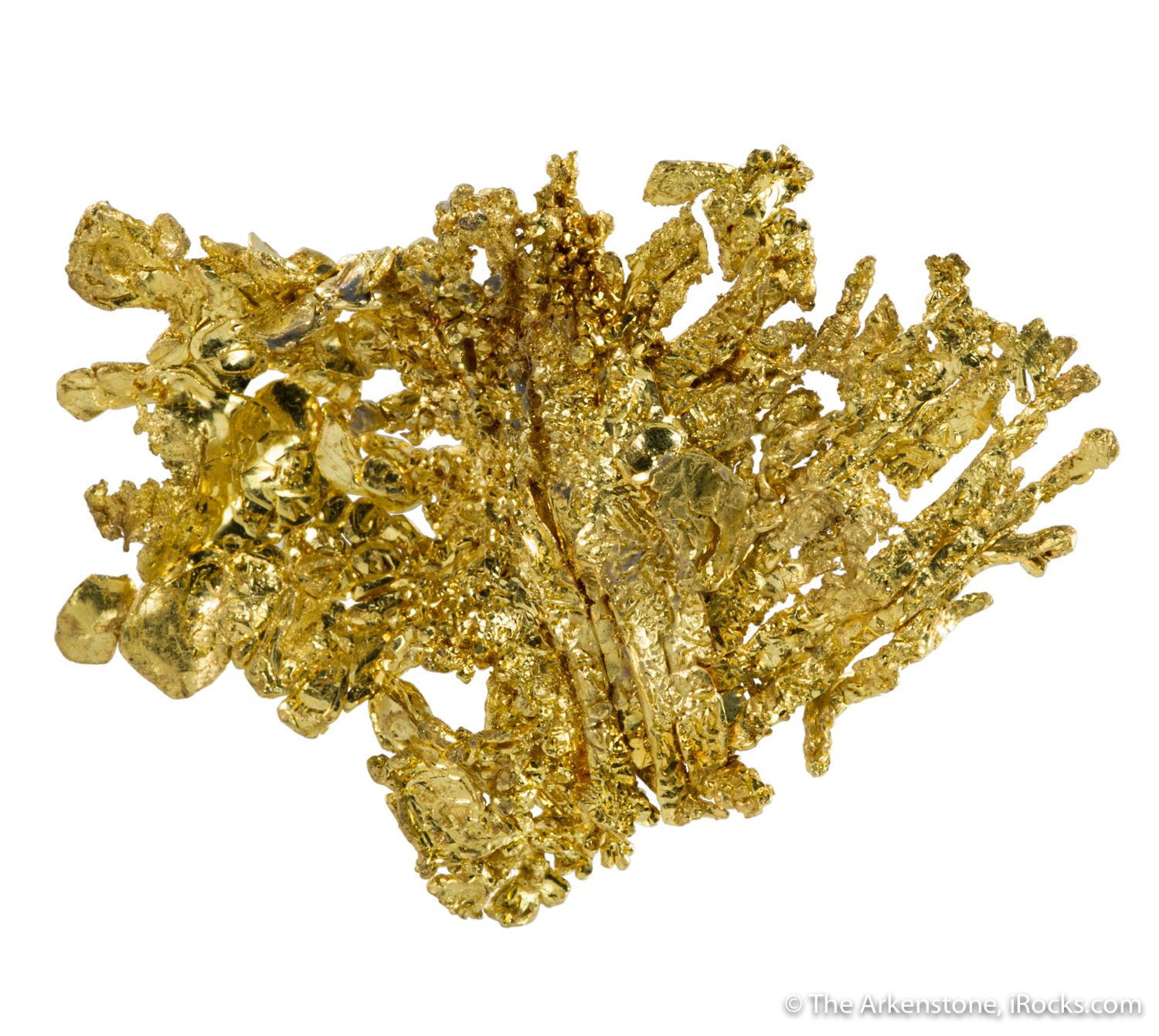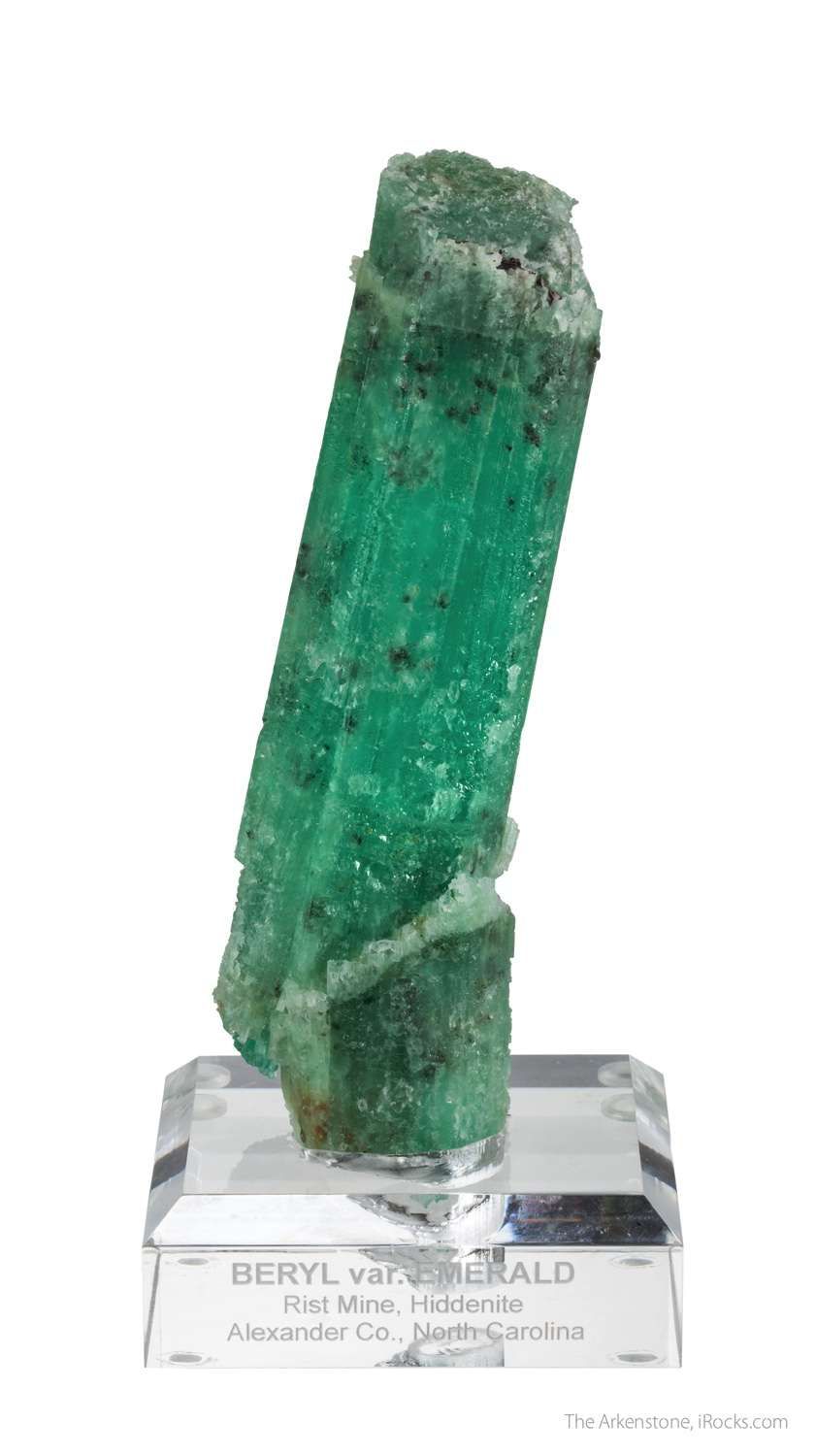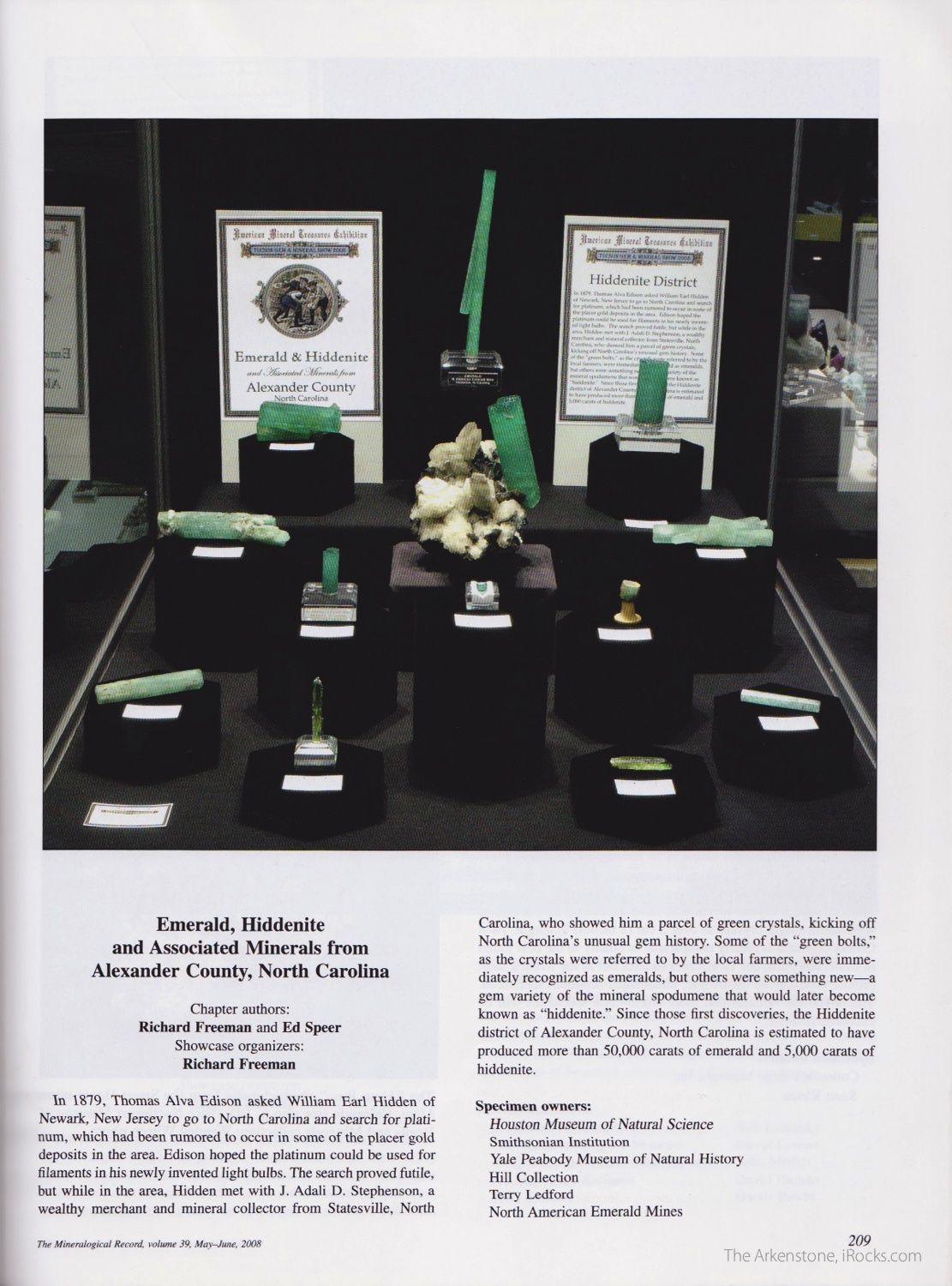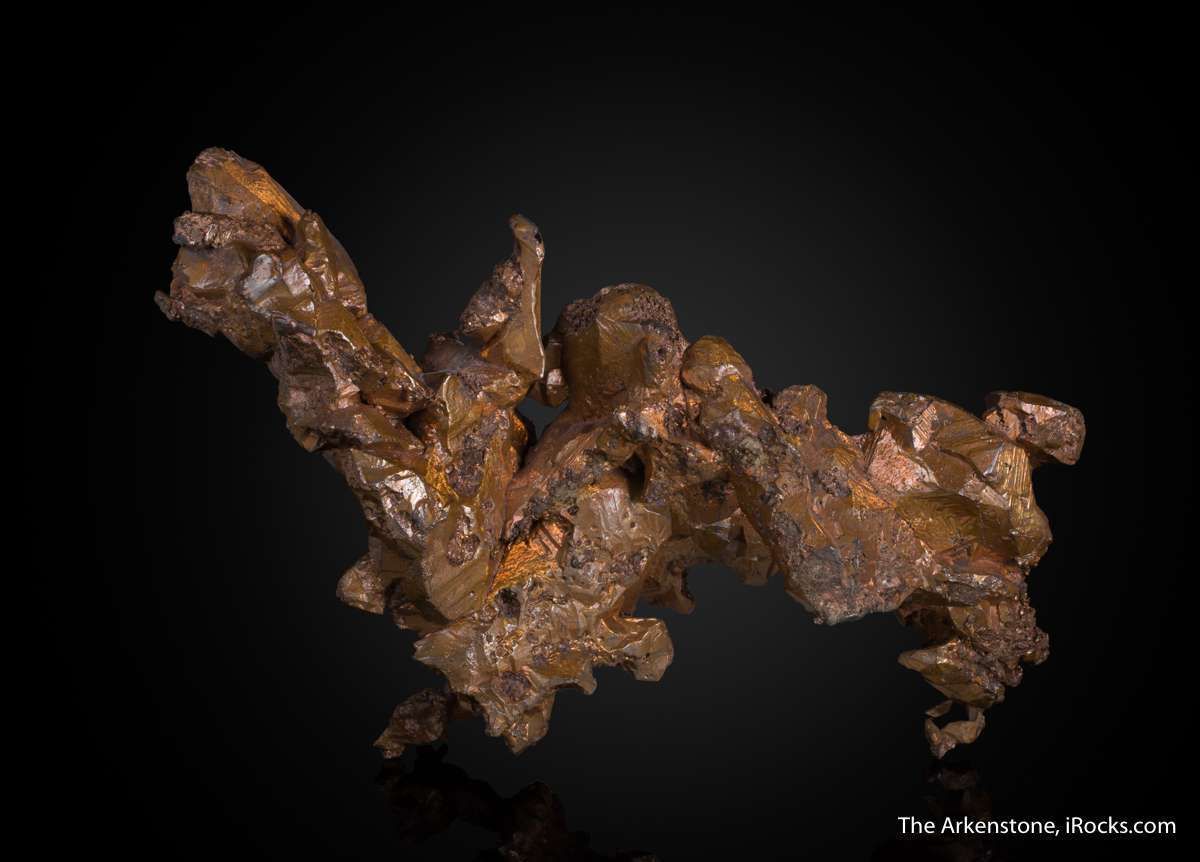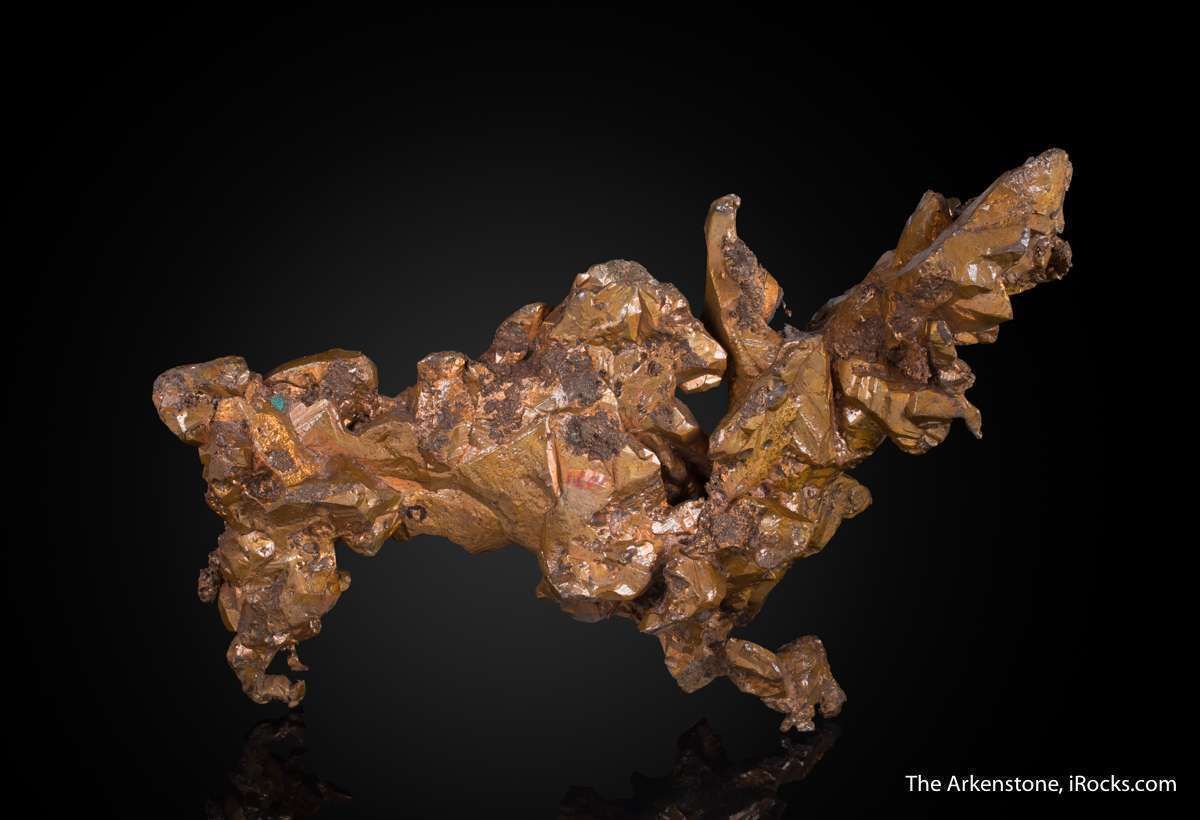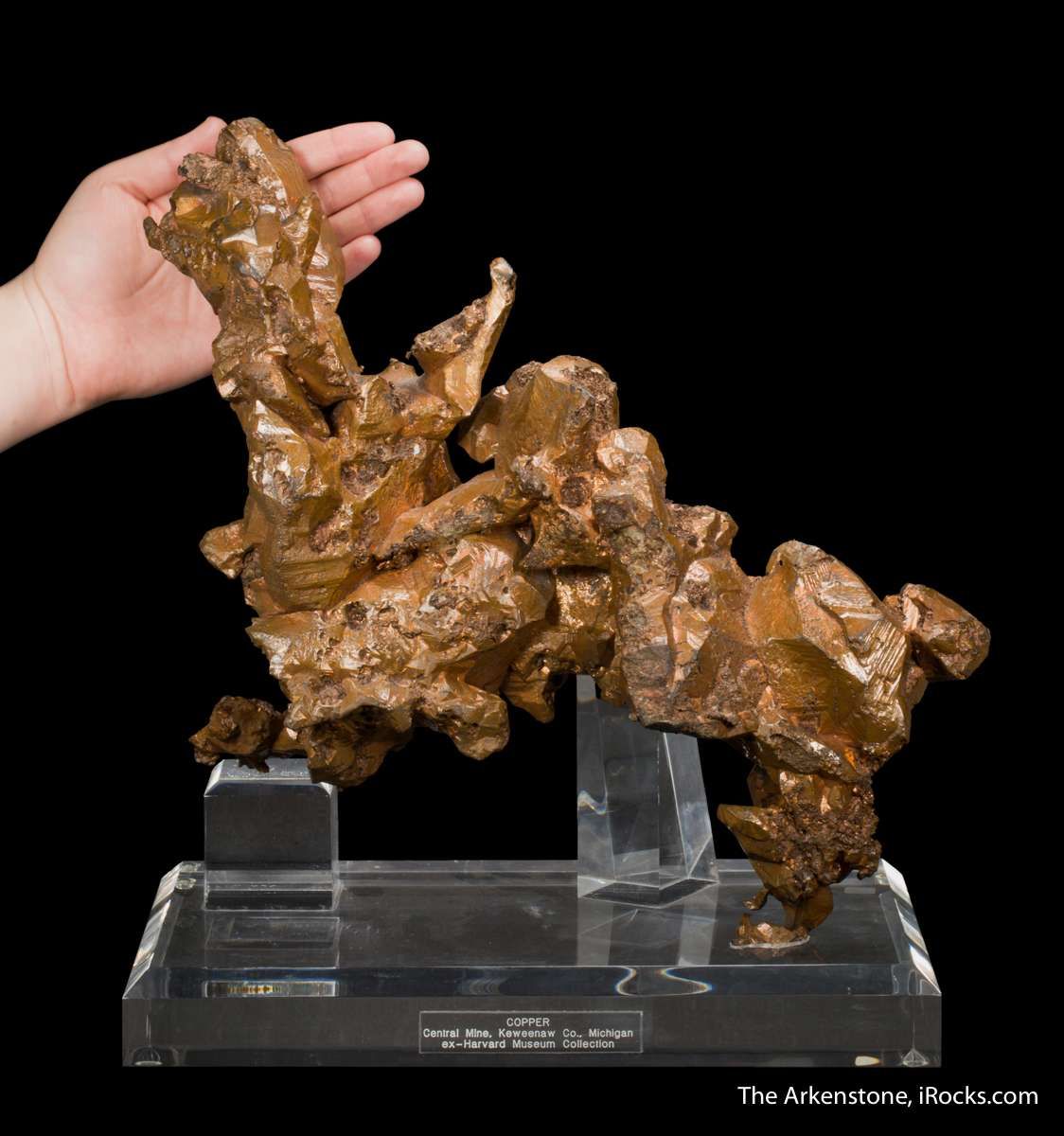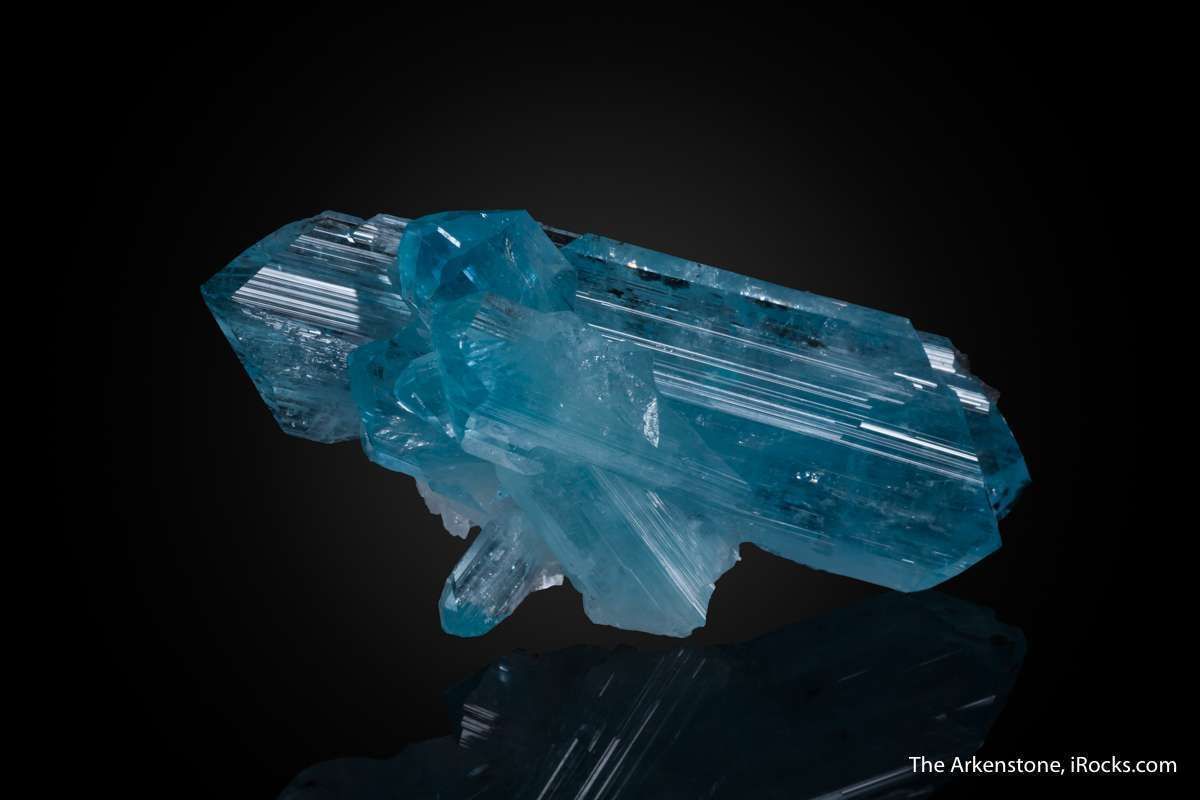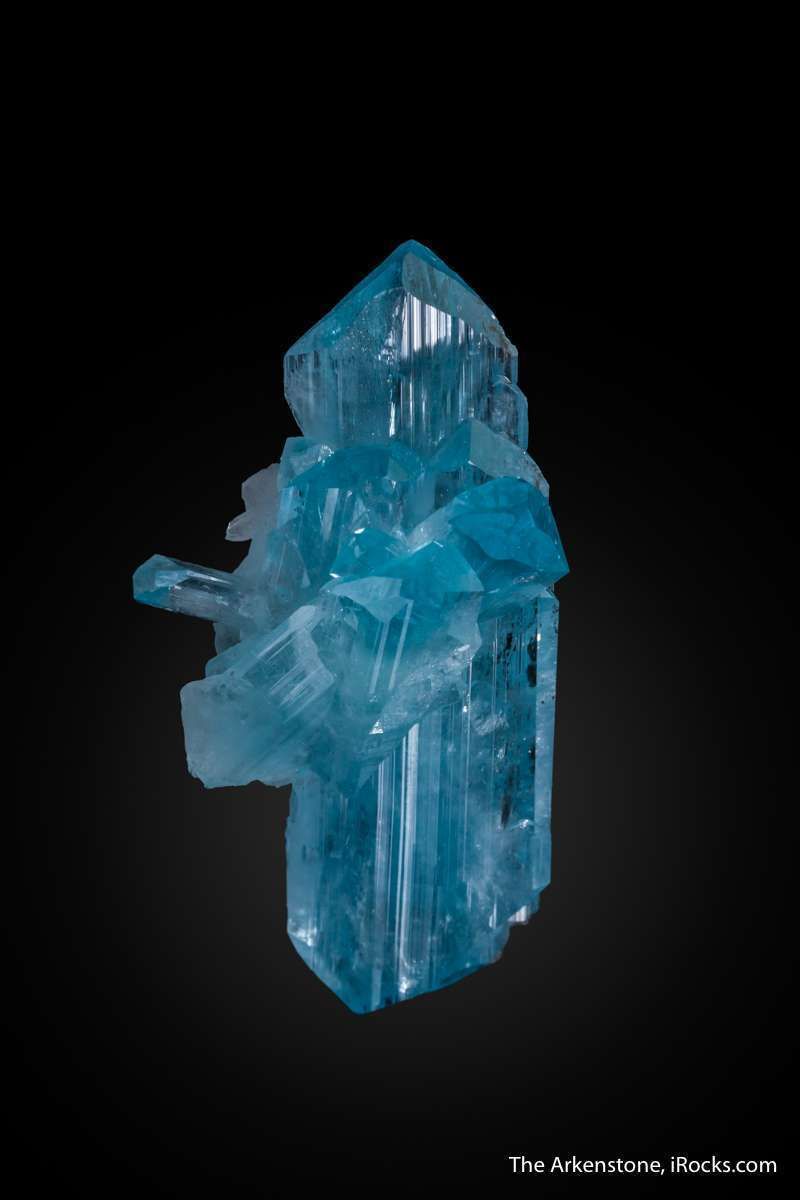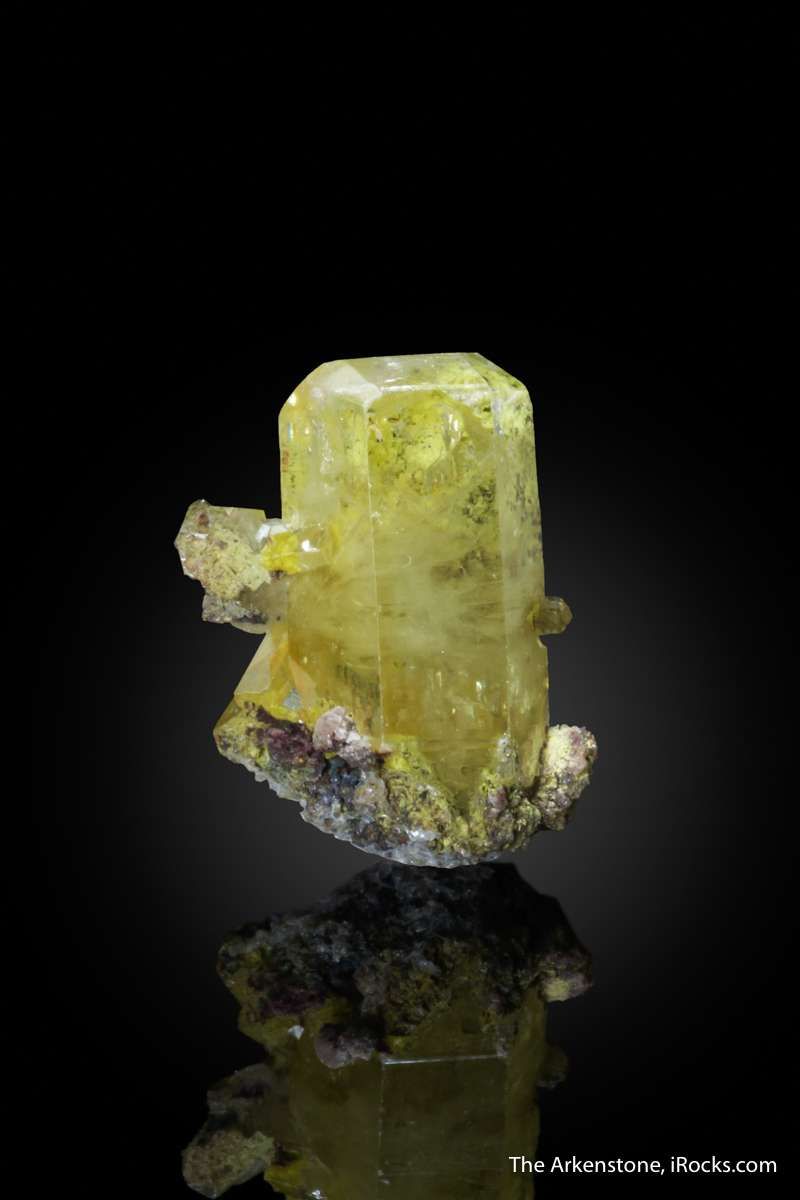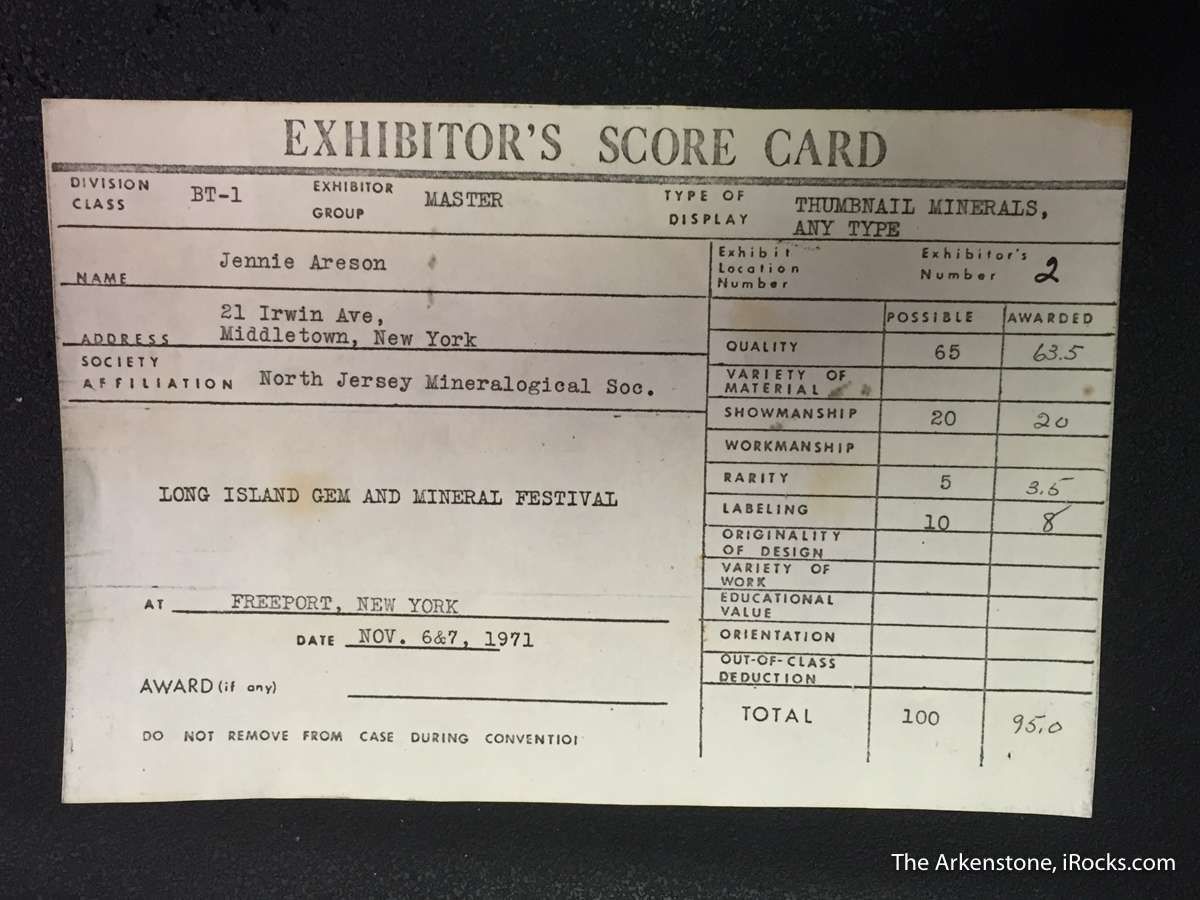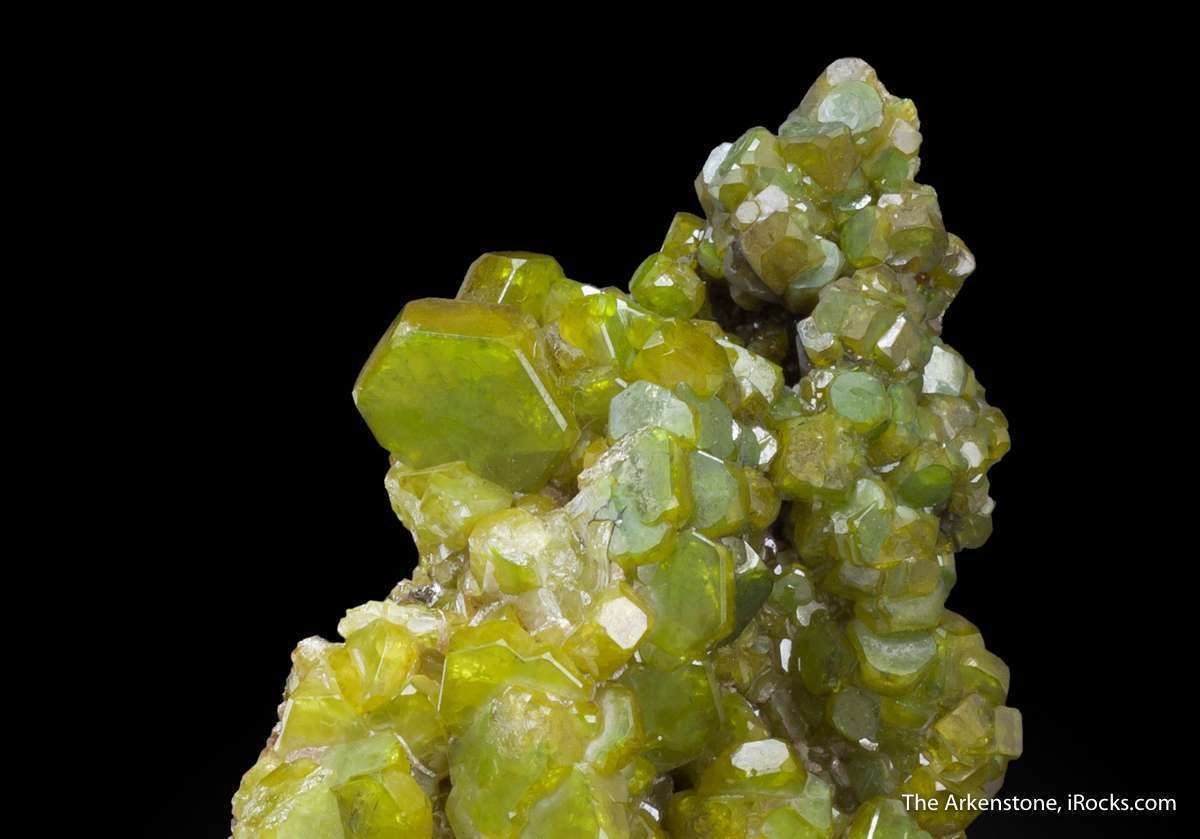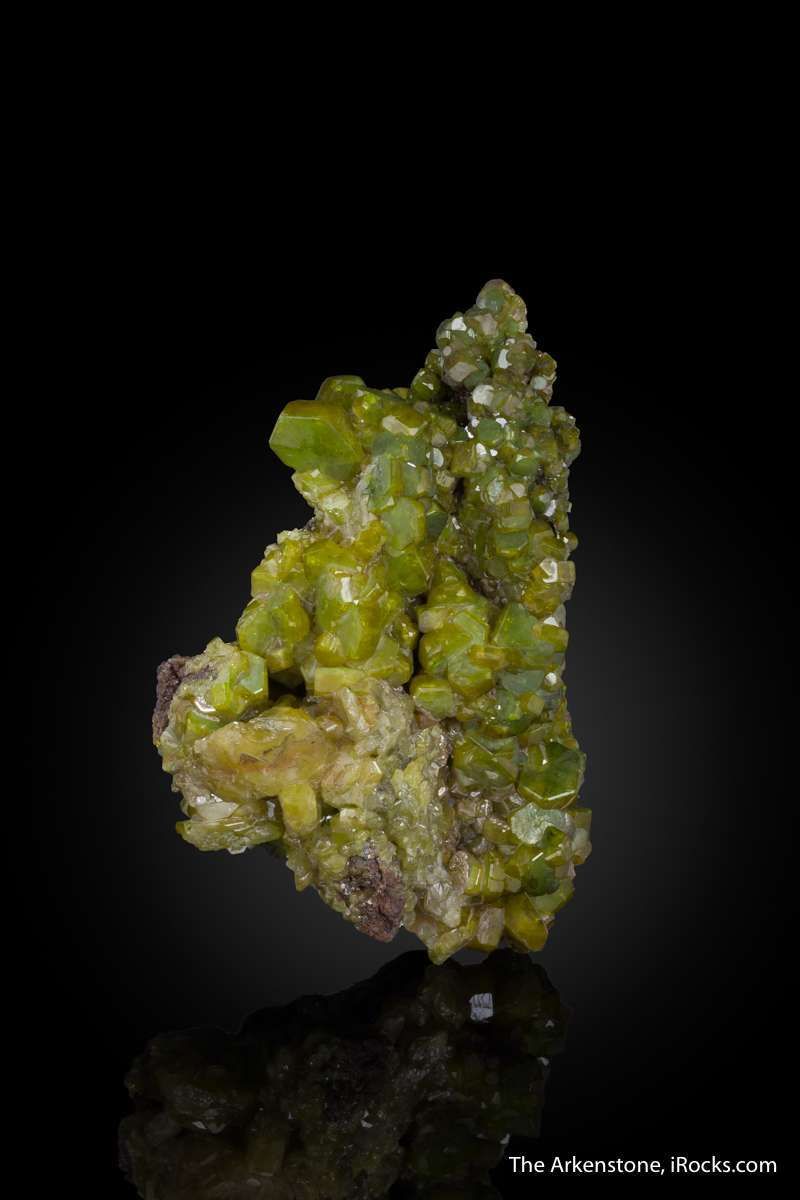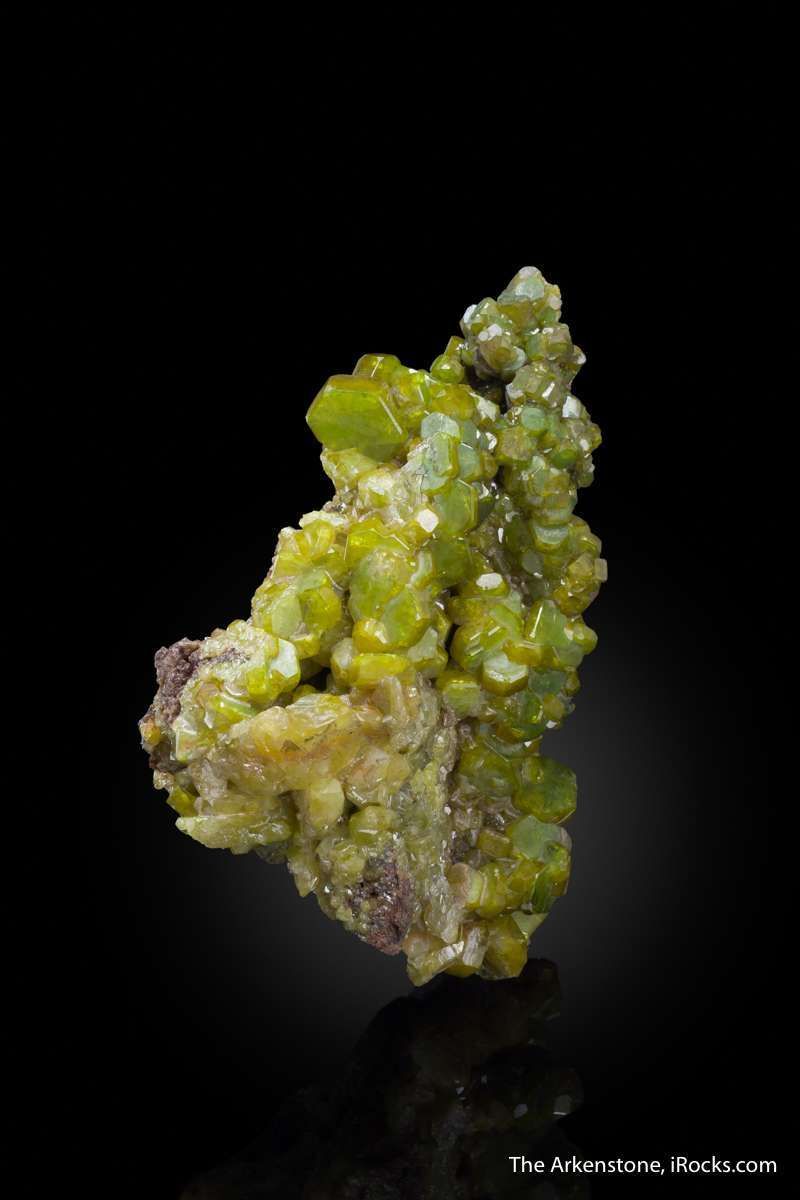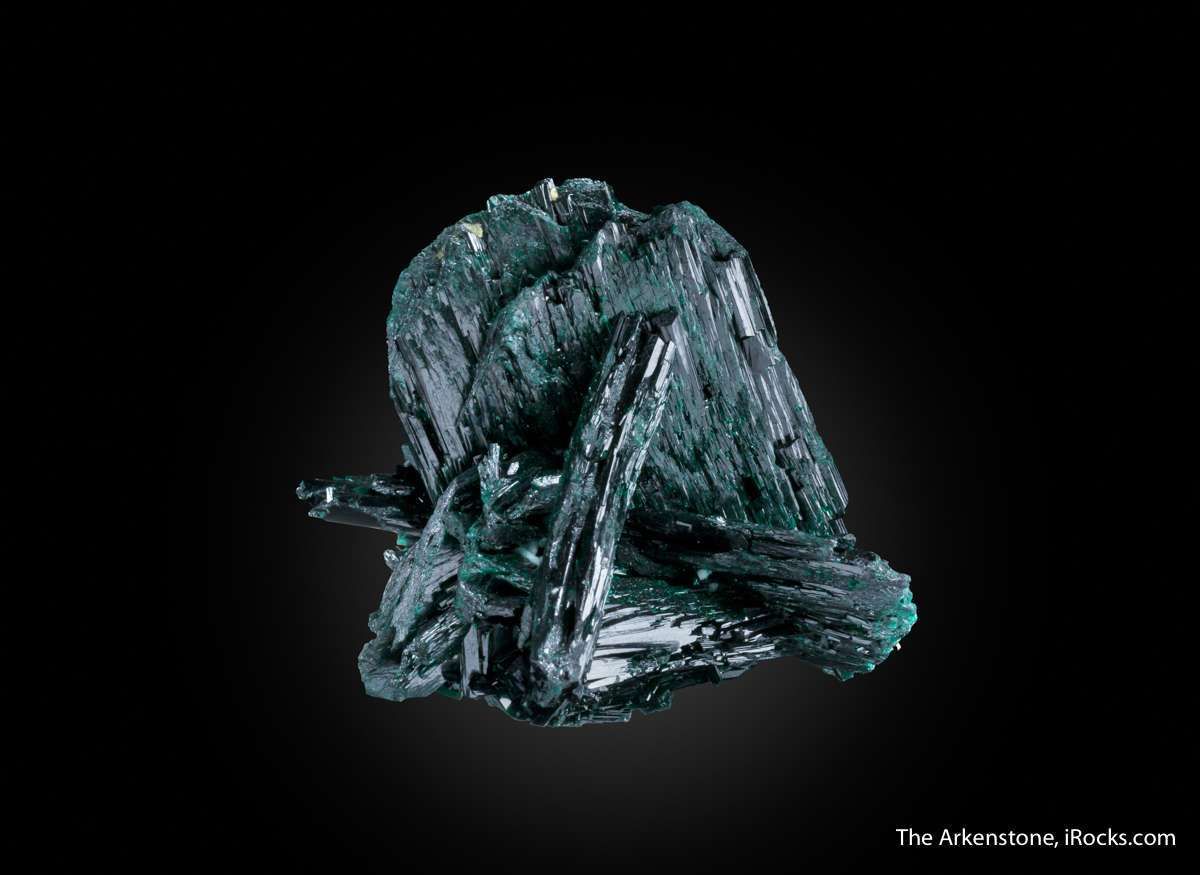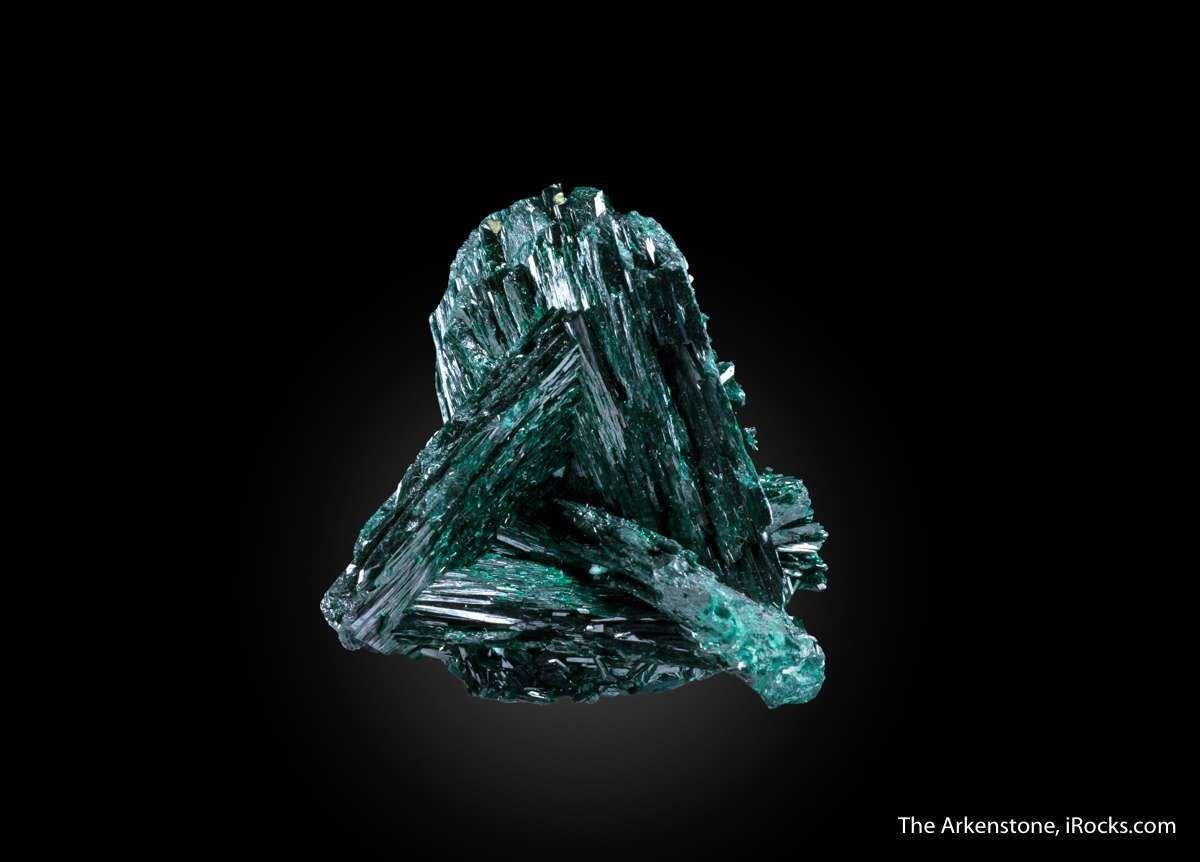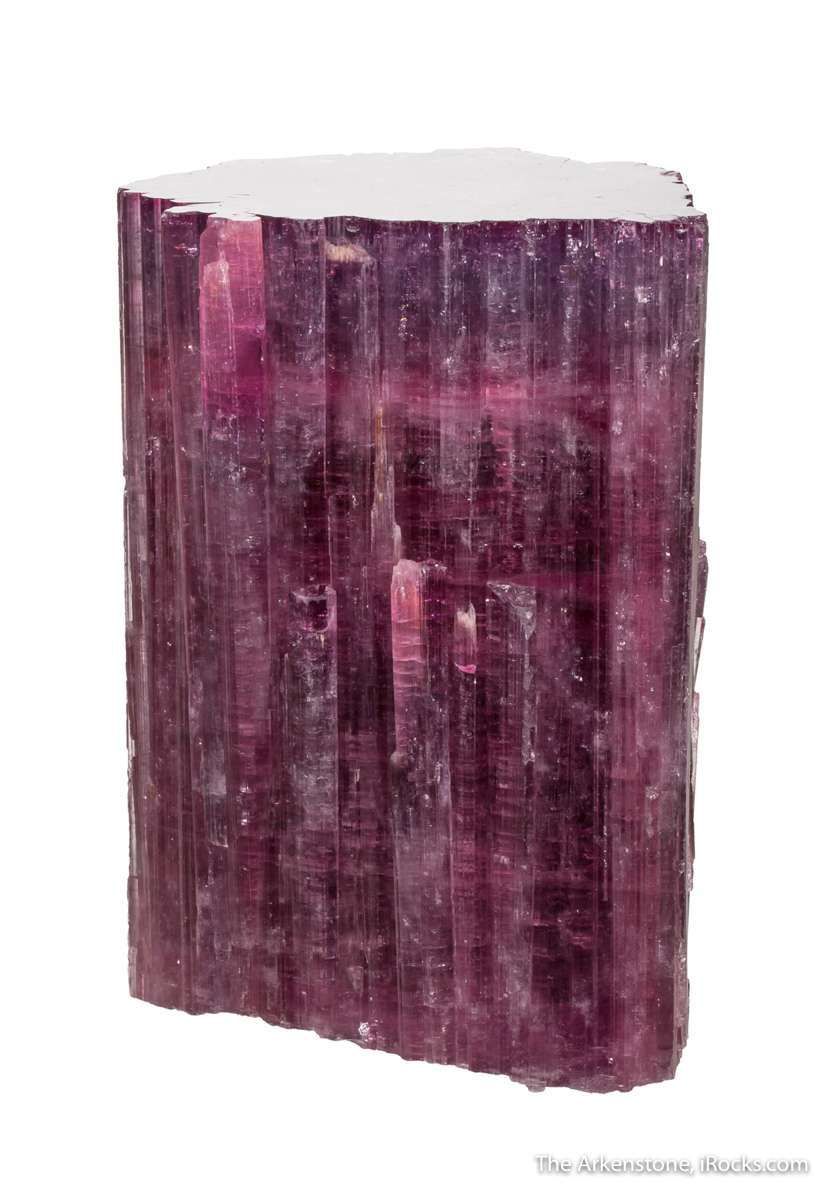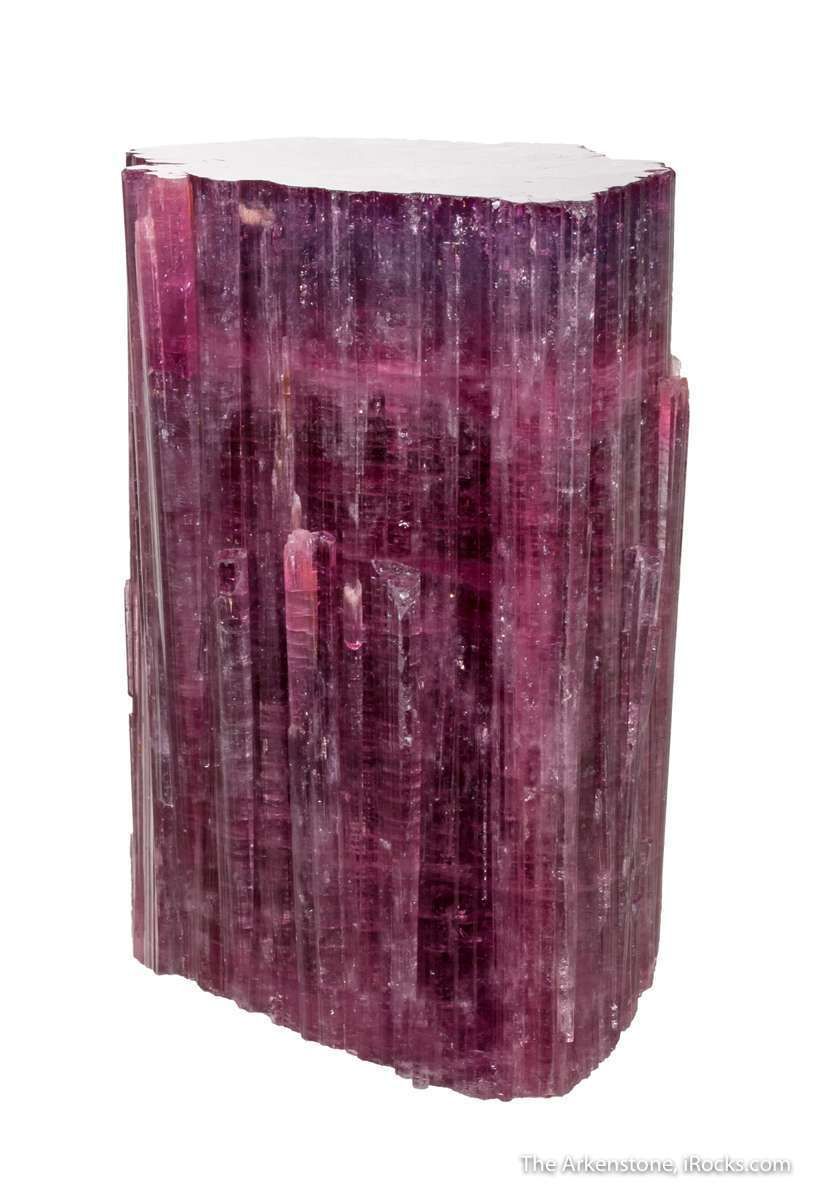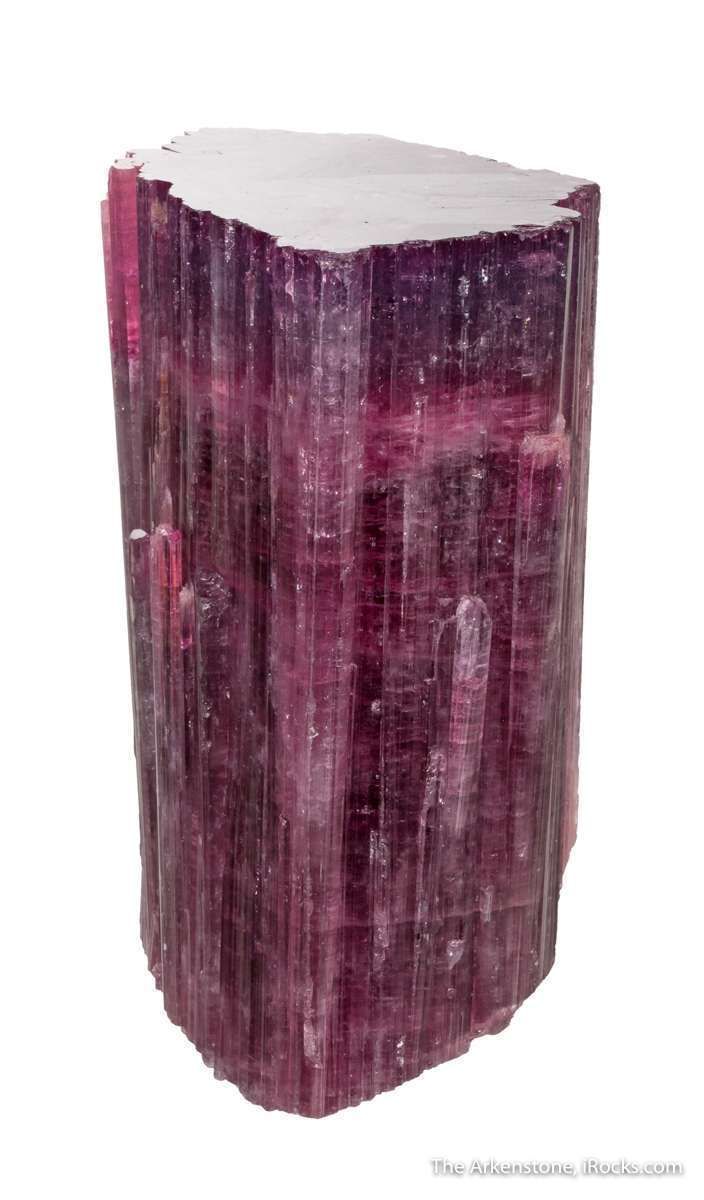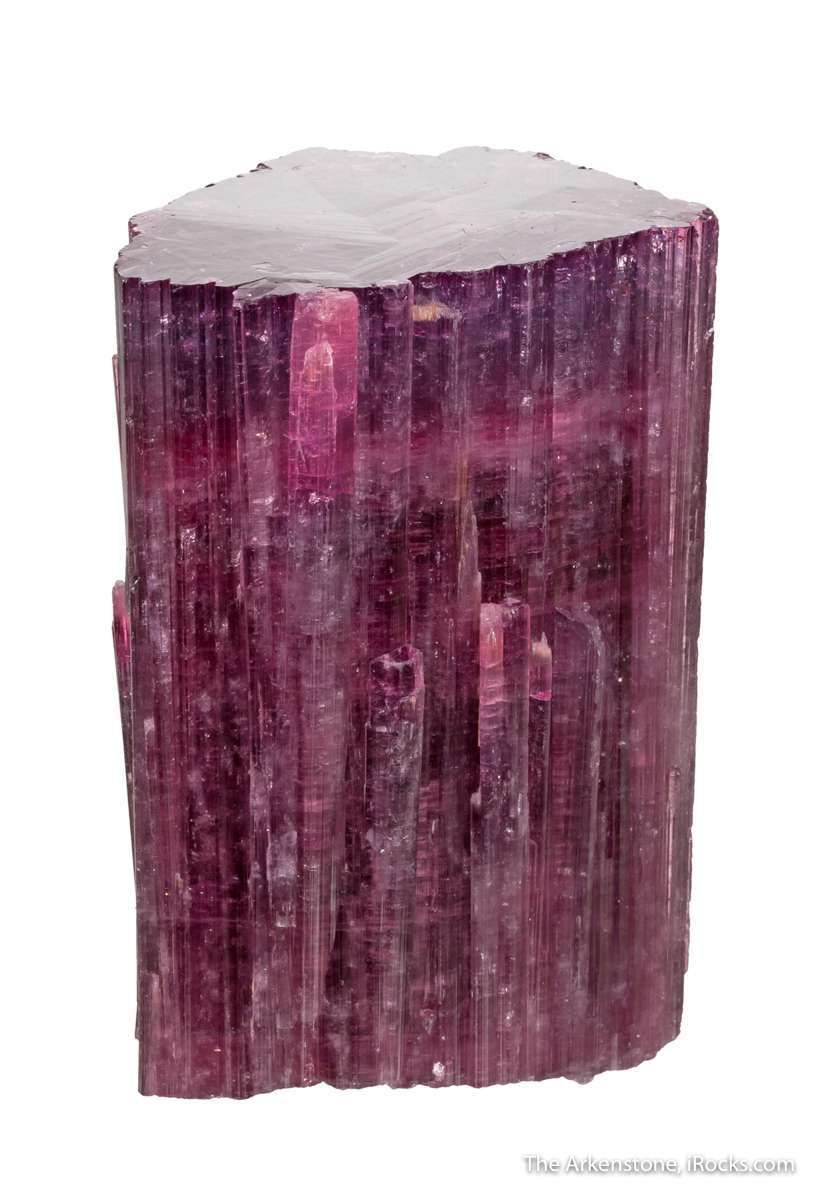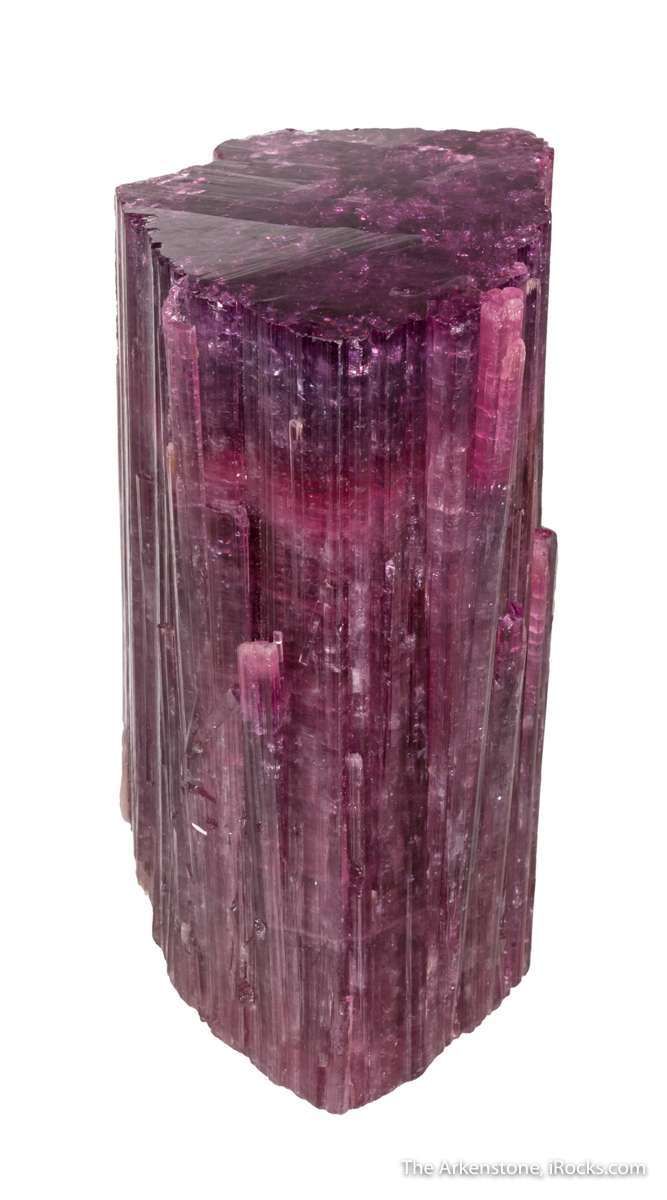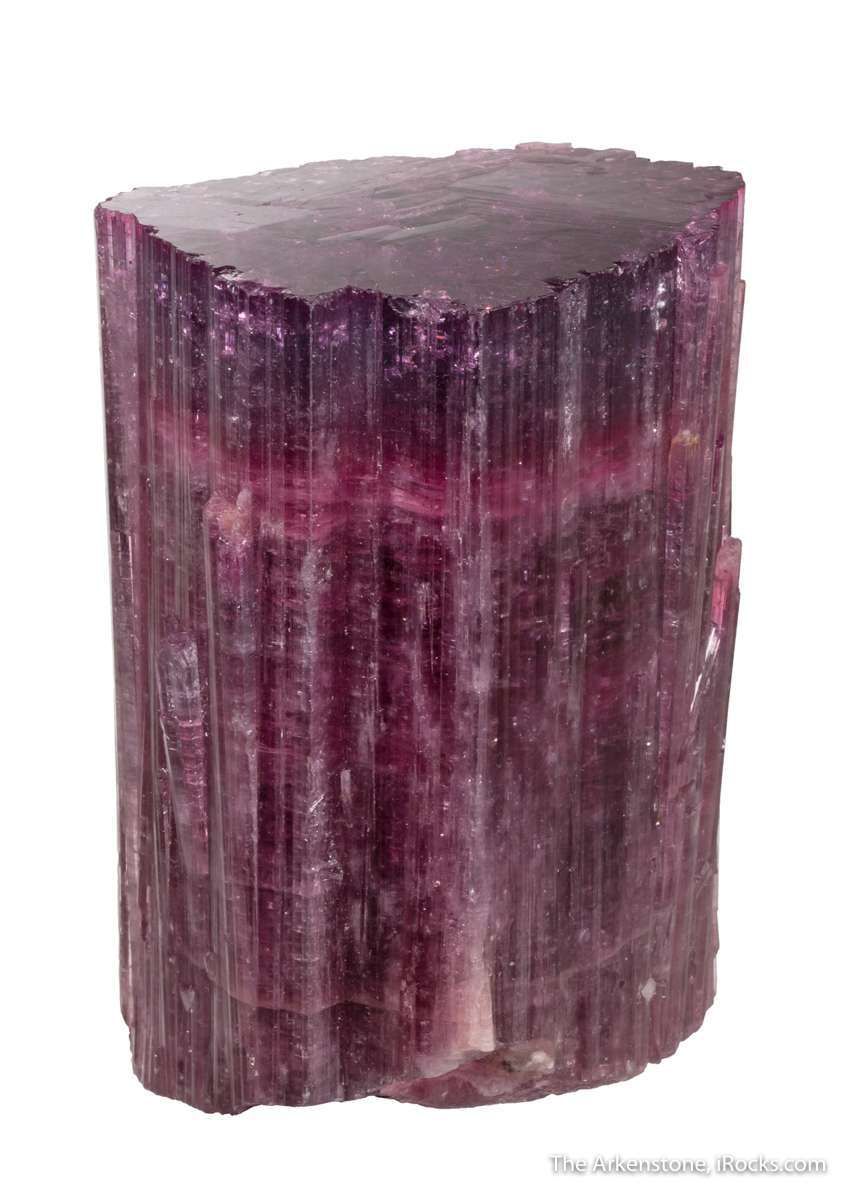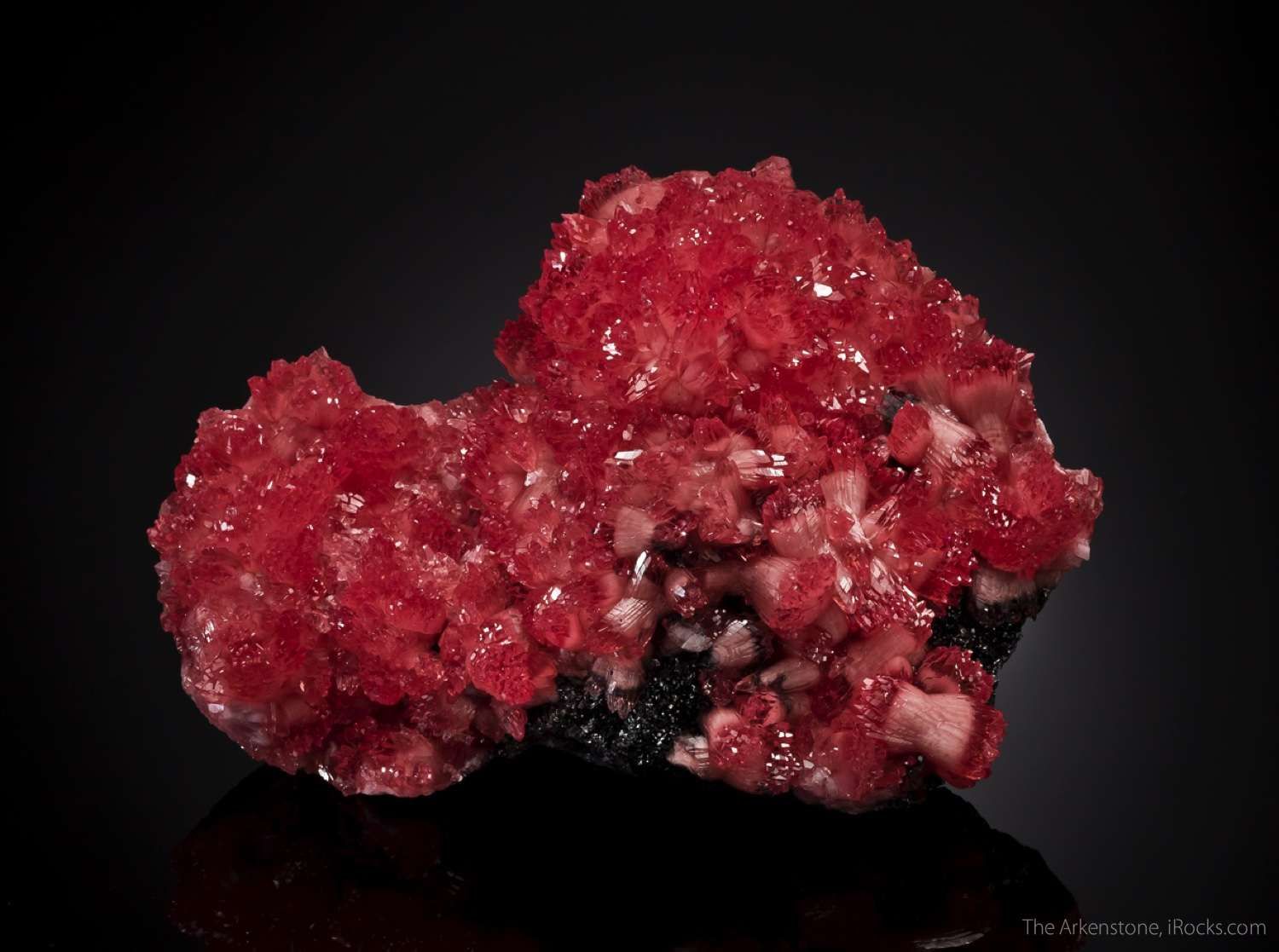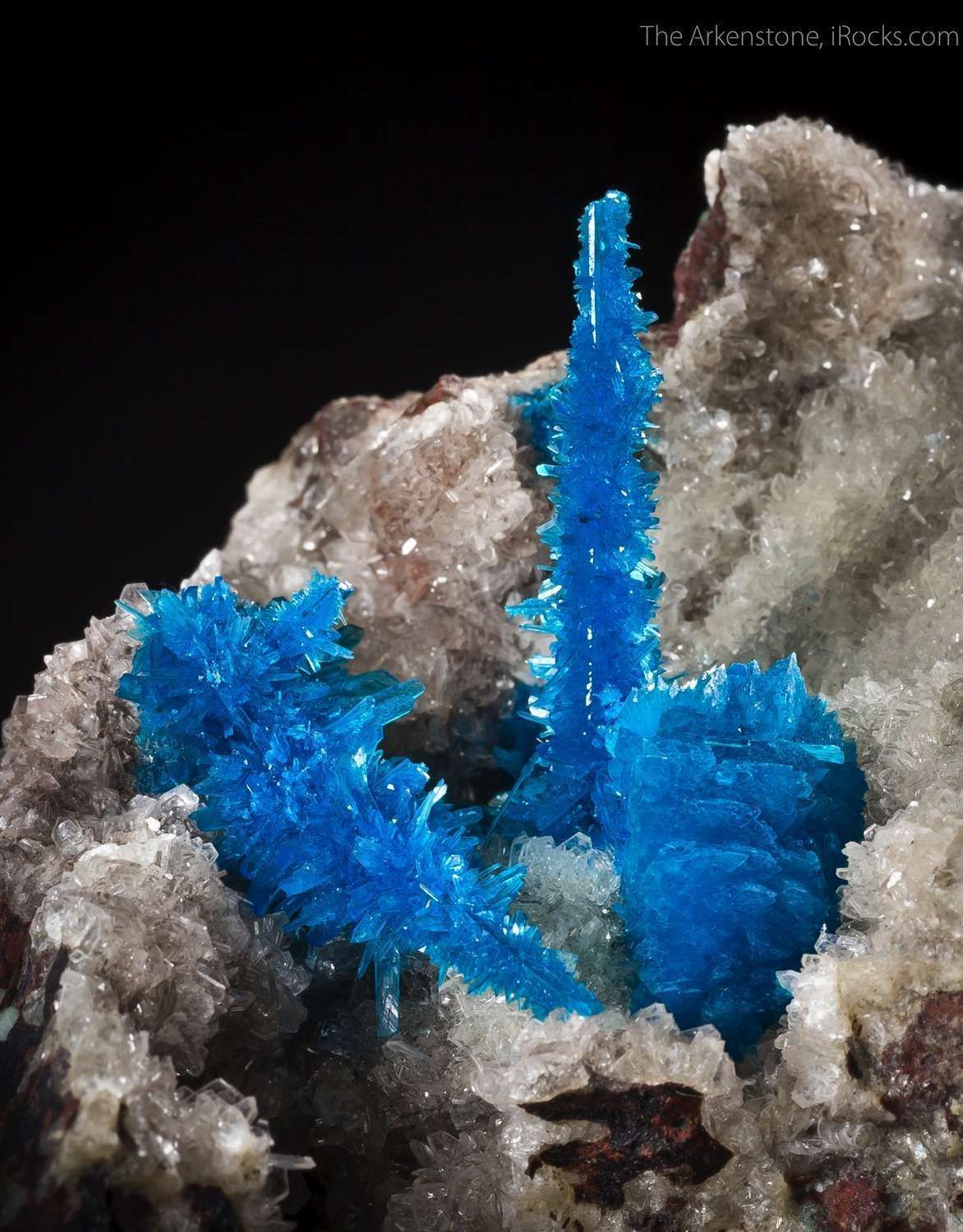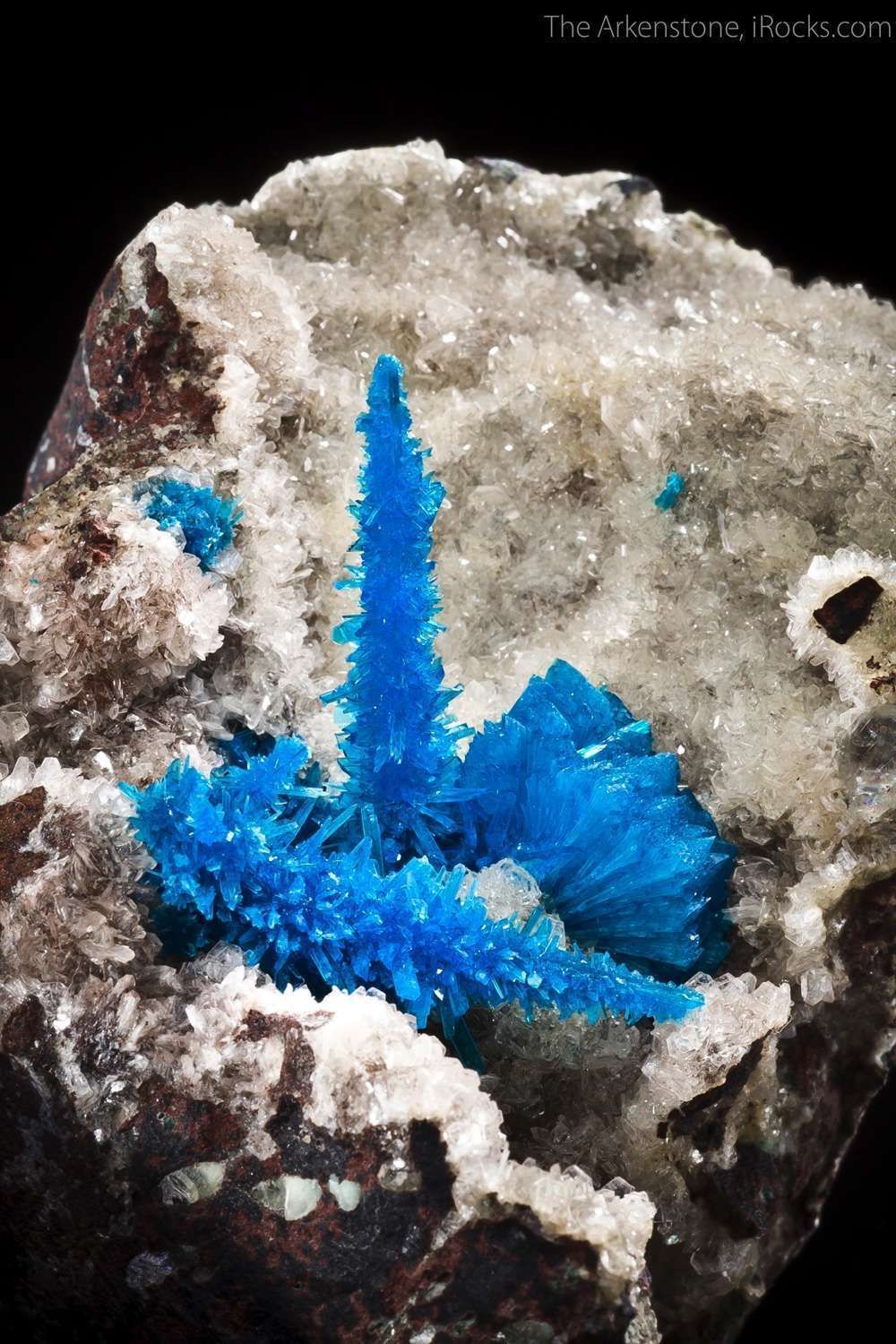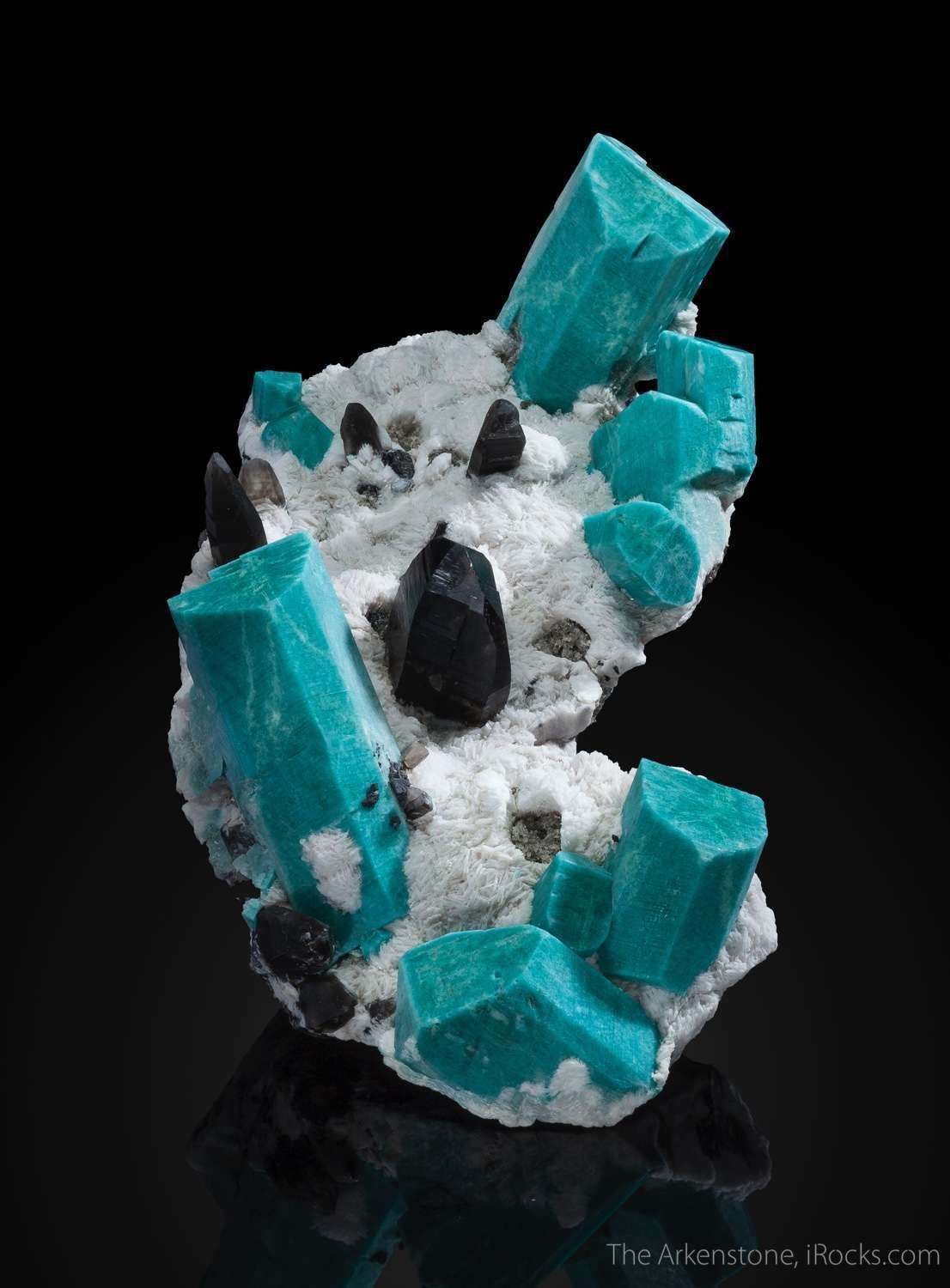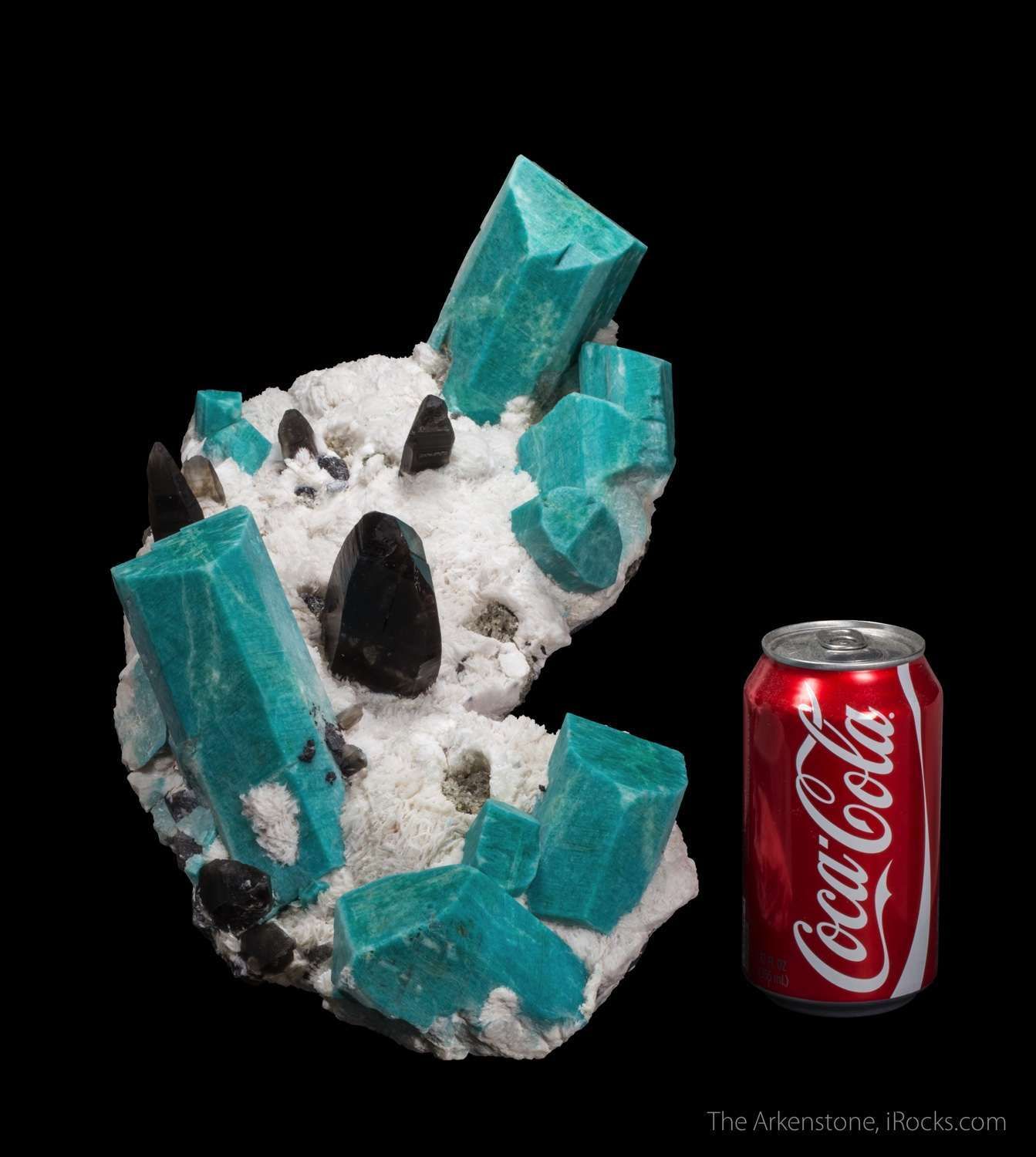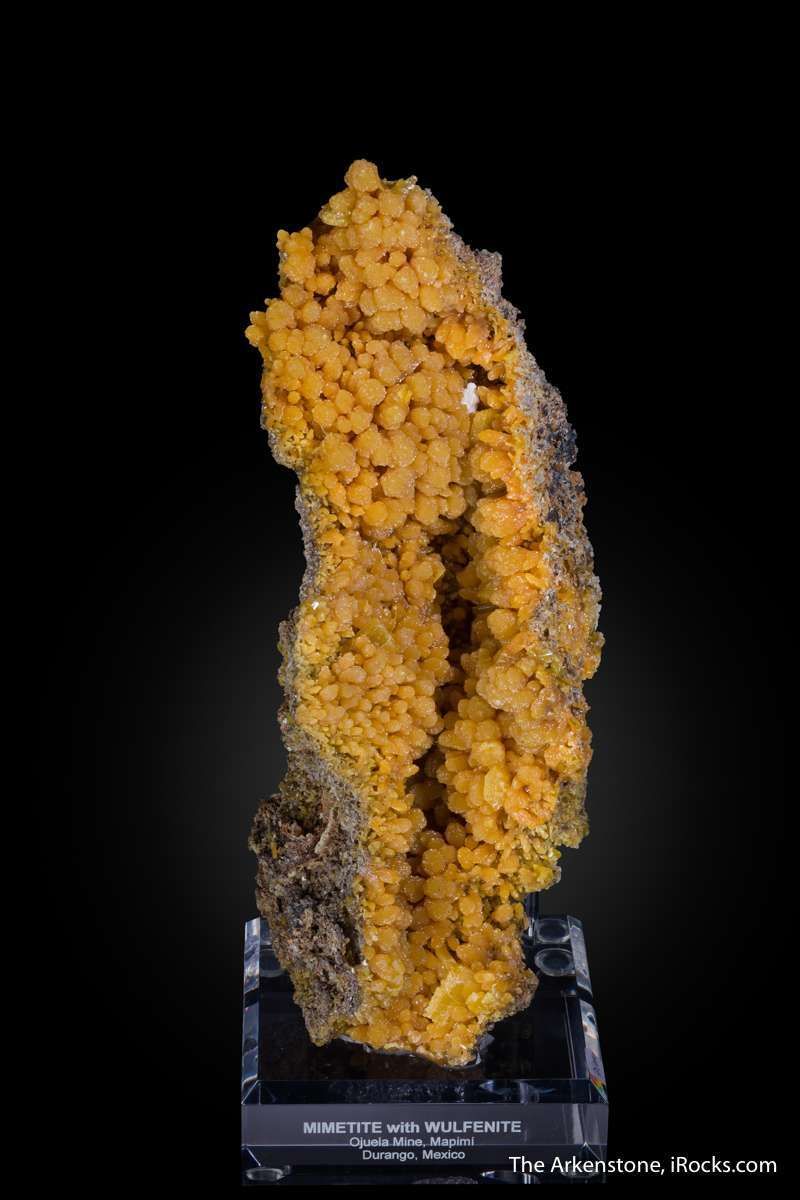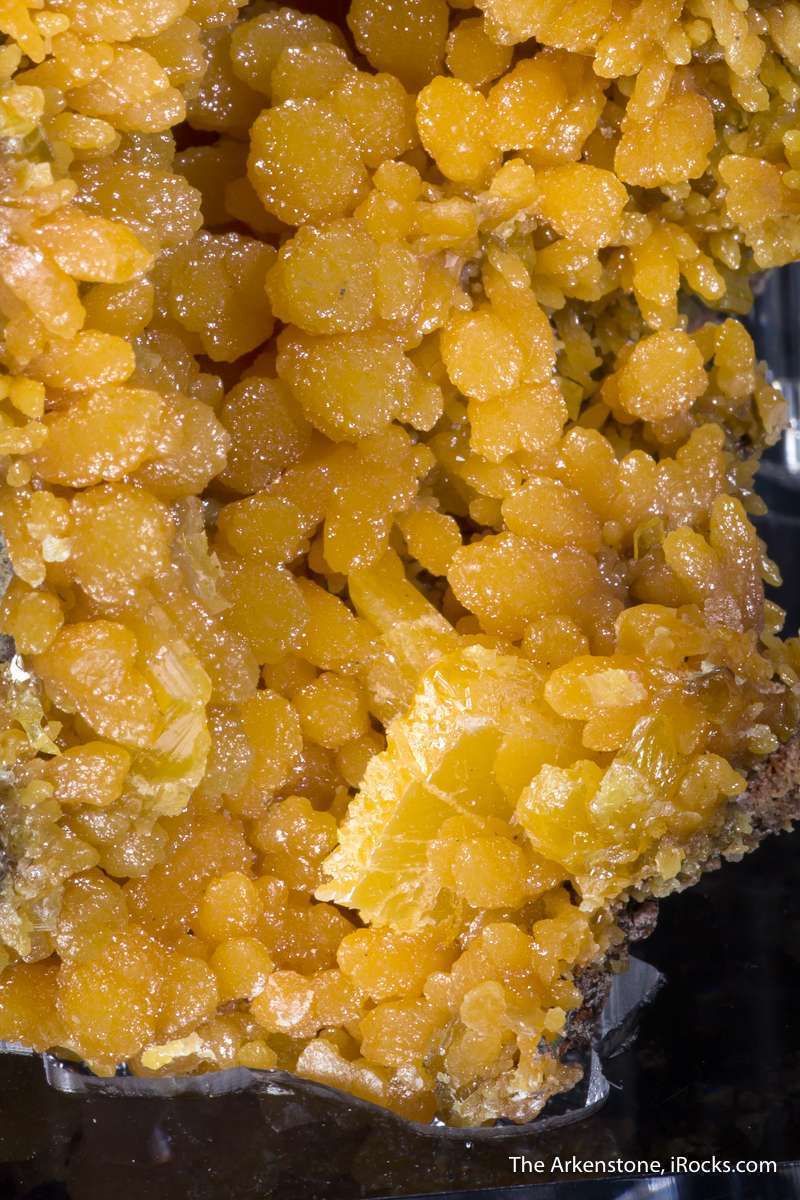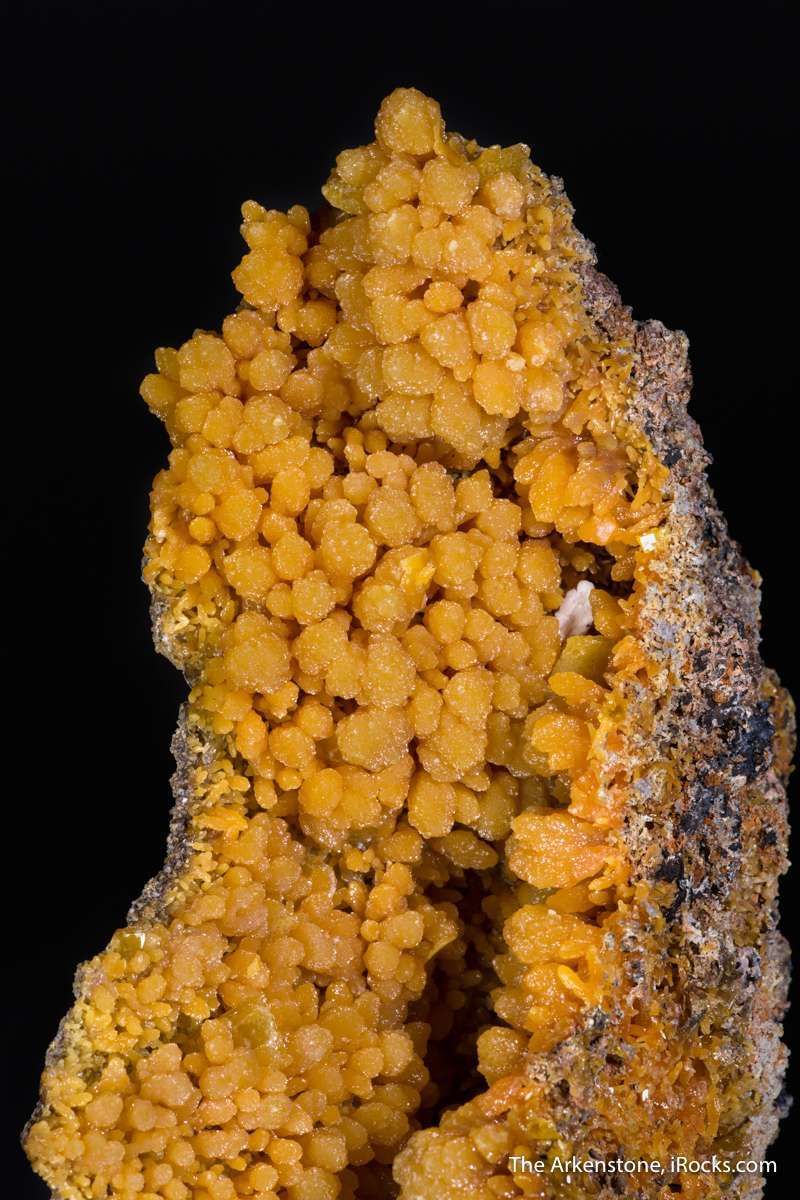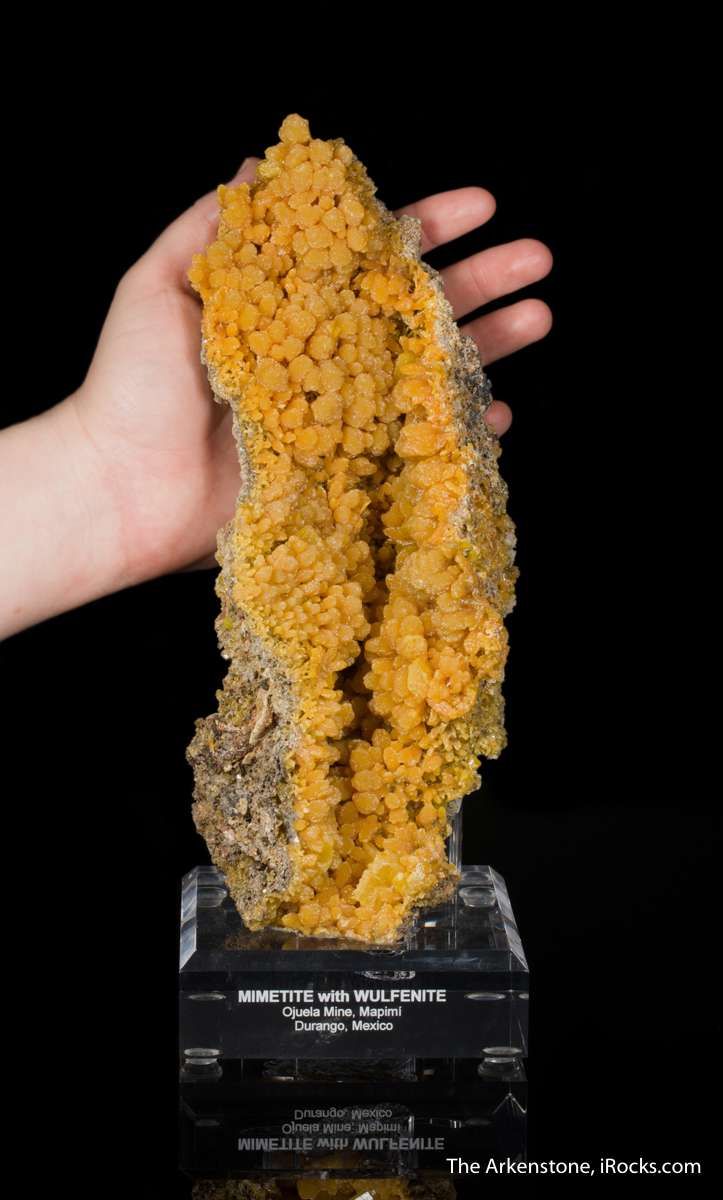- TUC115-301
- Tourmaline
- Himalaya Mine, Mesa Grande District, San Diego Co., California, USA
- Cabinet, 15.0 x 3.2 x 2.6 cm
Himalaya tourmalines are known for being broken in situ, and repaired. It just goes with the territory, as the pegmatite was severely disrupted and shocked over the tens of millions of years since it formed. There are few large tourmalines from this mine and district which do not contain repairs. However, this is one of the best we have seen, as it has intense red-pink color and beautiful tapering form, with both terminations. Also, the particular style of the larger tourmalines tends to show zoning, usually with a pale green or pale pink zone mixed in. This crystal is a solid, saturated color throughout.
- DEN13-1028
- Fluorite
- Minerva #1 Mine, Cave-in-Rock, Hardin Co., Illinois, USA
- Cabinet, 13.5 x 12.0 x 8.5 cm
I think the photos speak for themselves, although this is even better in person. It is an intensely colorful specimen with hot yellow cubes as sharp as you could dream of, and highlighted by purple phantoms around their edges. It looks like cubic mushrooms shooting up - it is very 3-dimensional. The piece is large, as well; a full cabinet size and then some. It is complete all around, and has no repairs. It is nearly undamaged as well, though I made the choice to have a few small dings restored for clean edges, with color-matched restorative epoxy.
- DEN13-960A
- Tourmaline Var. Liddicoatite
- Camp Robin, Fianarantsoa, Madagascar
- Large Cabinet, 21.0 x 7.0 x 7.0 cm
Liddicoatites from this locality represent the classic style for complexly patterned slices, showing the amazingly subtle gradations of color banding that occurs in these chemically-rich tourmalines as one moves up and down their length. This particular crystal is said to be the largest crystal of such quality that has been cut from the modern finds (since mining began again here in the 1990s), according to the man who mined it and in whose collection it resided for about a decade (Dr. Federico Pezzotta). It is expertly cut, with each piece polished superbly to a perfect polish and luster. The patterns and colors of the interior change even from slice to slice, in a graded pattern that could never be guessed at from outside! This piece was found in 2001 and long remained in the personal collection of Madagascan government's geological exploration consultant and collector, Dr.
- MUN13-1145
- Rhodochrosite With Manganite
- N'Chwaning I Mine, Kuruman, Northern Cape Province, South Africa
- Miniature, 4.9 x 4.3 x 3.4 cm
These treasured red jewels from the late 1970s and early 1980s finds here only turn up in old collections. This is a very balanced, 3-dimensional miniature with superb aesthetics and the best rich, cherry-red color. Unlike most of them which are rather damaged (due to the time they were collected, generally in haste), this has only one small tip missing. Small hematite crystals provide accent. It is, to those who know what they are looking at, just a very sophisticated example of one of the pre-eminent pockets of minerals in modern times. Joe Budd photos.
- TUC14-1207
- Beryl Var. Aquamarine
- Marambaia, Carai, Jequitinhonha Valley, Minas Gerais, Brazil
- Large Cabinet, 21.0 x 10.8 x 8.7 cm
An incredible large specimen weighing about 9 pounds with intense sea foam BLUE color. This is the classic color of really old Brazilian aquas, recovered in the 1920s-1950s primarily. Many of them were cut for gems and lapidary carving. Much of the best work was done in Idar-Oberstein. It is a miracle that this huge crystal, with lots of gem rough and carving value, survived! It was locked in a storage box by two previous owners, each for 20 years or more.
- SM20-445
- Pezzottaite (type locality)
- Sakavalana Mine, Mandrosonoro, Ambatofinandrahana, Madagascar
- Miniature, 5.1 x 3.6 x 0.7 cm
A large, and significant crystal for this very rare gemstone species, a neon pink-red Pezzottaite from the type locality in Madagascar. This is a superb, complete, tabular hexagonal Pezzottaite crystal with well-developed, broad, flat terminations modified around the edges by complex modifications (pyramidal faces). It has robust, raspberry-red color and is gemmy throughout. The broad faces have a satin luster. One side displays stepped growth with progressively smaller hexagonal growth forms - mesmerizing detail! It is pristine save for a few tiny contact notches at the bottom where it grew from matrix (most of the pocket of 2003 was found, collapsed, and few matrix pieces exist; the majority being floaters such as this).
- DEN14-1407
- Wulfenite
- San Francisco Mine, Sonora, Mexico
- Small Cabinet, 7.0 x 7.0 x 4.5 cm
Wulfenites from this mine are still common on the market, but NOT in quality. This piece is complete all around, with superb, sharp crystals of the highest luster and color. They are large, as well, to 4 cm. From the mid-1970s finds, this is a stunning small cabinet piece that was formerly in the collections of Ed Swoboda and then Eric Asselborn (for some 20-plus years). It was collected by Wayne Thompson and crew, in the mid 1970s. The luster and gemminess of these crystals, in person, is hard to convey in photos.
- AAU21-01
- Gold
- Kalgoorlie-Boulder Shire, Western Australia, Australia
- Small Cabinet, 8.4 x 5.7 x 2.6 cm
Arguably, of all of the areas of the globe that have gold deposits, Kalgoorlie is one of the top. Australian nuggets are known for high-purity gold, and this hefty piece reaches a significant 459.5g (14.7oz). This nugget somehow is weighty and delicate at the same time, with several crevices and holes, along with what looks like a sort of thick sheet that folded over on top of the main platey mass, in the front top left of the beginning of the video shown here.
- V22-1469
- Tanzanite
- Merelani Mines Block D, Arusha, Tanzania
- Miniature, 4.4 x 2.8 x 2.7 cm
This is a special tanzanite crystal, even among others we have seen, for its unique quality and style from an early 2000s pocket that is now legendary. We think this pocket came in 2003-4 and the style remains distinct to this day for color, clarity and gemminess within, and the sleep, modern, architecture of the crystals themselves without undue distracting striations, rounding, or defects. The gemminess and clarity is special, and in fact this is prime cutting rough material. They are now only found in top collections such as the MIM Museum. Tanzanite is one of those gemstones termed a "generational stone" because the supply and the mine is limited by access and location, and will eventually run out (probably in our lifetimes). They are already digging below 1 kilometer in depth.
- SM22-166
- Tanzanite with Calcite
- Merelani Hills, Lelatema Mtns., Simanjiro Dist., Manyara Region, Tanzania
- Small Cabinet, 9.3 x 5.9 x 3.7 cm
We often see tanzanite crystals but since they are so rare we almost never see them except in books, we seldom step back and ask, but what about matrix pieces?...I want a matrix piece, when possible. This is a rare example because of several qualities: It is big and unrepaired; on matrix not just of the typical massive rock but of crystalline calcite in particular - which gives color contrast as a bonus; it has natural color (untreated by heat); and happens to be free of damage and very, very aesthetic. The video hopefully helps convey how dramatic this imposing small cabinet sized specimen is, and it is even better in person. Size is large - at 179 grams, it is hefty. We had the good fortune to be there at just the right time when a Tanzanian gem dealer arrived to Munich show a few years ago, and purchased this dirty and uncleaned from the mine. It is, really, a true rarity.
- SM22-86
- Beryl var. Aquamarine with Schorl on Albite
- Shigar Valley, Shigar Dist., Gilgit-Baltistan, Pakistan
- Large Cabinet, 17.0 x 15.5 x 11.0 cm
This is quite simply a gorgeous and impressive large cabinet combination specimen of Aquamarine with Albite and Schorl. The imposing, five inch Aquamarine crystal is water-clear in its upper half, somewhat turbid in its lower half, and has a super glassy luster with good color and a perfect termination, some of the best attributes for a gemstone crystal. It is nested in just the right amount of matrix, and that matrix has large and well-formed, snow-white Albite crystals to 4 cm, and jet-black Schorl Tourmaline crystals to 3 cm for the ultimate polarity in color between them, and fantastic contrast with the stately pale blue Aquamarine that commands attention in the center. There is no damage to the Aqua and only one clean (lock-fit) repair near the base. Taken together, you can see the impact makes this a fantastic piece for the discriminating collector as one of the finer examples in its size and price range. From a remarkable 2020 find.
- DEN14-1453
- Azurite
- Milpillas, Cuitaca, Sonora, Mexico
- Small Cabinet, 9.3 x 5.6 x 3.1 cm
Milpillas produced a flood of azurites in the recent heyday there, mostly 2009-2013. However, the flood has tapered, and the styles have changed over the years. This piece is of what I would call a "classic style" from the midrange of production, with large, robust crystals of the brightest azure blue color. This piece has extra luster and extra color beyond the norm. As well, the size of the crystals and the dominant aesthetics make it stand out: The large central crystal is 4.2 cm across. In person, this piece DOMINATES over most Milpillas azurites of any similar crystal habit.
- HALP-01
- Gold
- Eagles Nest Mine, Placer Co, California, USA
- Miniature, 4.9 x 3.6 x 0.5 cm
An exquisite gold of classic form from Eagle's Nest, but on second look you will see that it has a much more robust crystallization than usual, and the absolutely top luster possible from here. The crystals are thick and show space between the branches, whereas this material is often much more densely packed and netted in appearance. Only maybe 1 in 1000 of the prolific Eagles Nest golds has such luster. It spreads nicely, balanced in the middle, and I always thought of this as an "Eagle" in shape, a nice coincidence with the locality name! Complete on both sides. Although the mine produces several different styles of crystallized gold, and has given us some giant and amazing large pieces, I do not think we could get a finer Eagle's Nest in the full miniature size, of this particular style.
- JB16-1715
- Beryl var. Emerald
- Rist Mine, Hiddenite, Alexander Co., North Carolina, USA
- Large Cabinet, 16.0 x 4.5 x 3 cm
The North Carolina emerald mines are an important part of US gem lore, having been visited and worked by the great Tiffany's gemologist Kunz in the early 1900s. Intermittent production continued for 100 years, but pockets of good crystals have been an EXTREME rarity. At 281 grams and with no repairs, this complete-all-around crystal is one of the largest ever found at the location. We believe it to be, in fact, the second largest to the one in the Houston Museum, that was ever recovered (and that one is repaired several times while this is not). This specimen consists of one large, slightly etched, double-terminated crystal, perched on a crosswise smaller crystal at its base. The etching is due to solution effects in the pocket over geologic time, and is common for the locality.
- JB17-1743
- Copper
- Central Mine, Central, Keweenaw Co., Michigan, USA
- Large Cabinet, 38.0 x 23.0 x 9.0 cm
This important copper specimen is one of the single most significant coppers to come to market in my life and is from the mid-1800s heyday of mining in the Upper Peninsula. It has been preserved without damage or cleaning (which would ruin the ancient and natural patina) for over 100 years, probably closer to 150 years. For much of its life, it was in the basement of the Harvard Museum. Exchanged out to a private collector in the early 2000s because it was too big to display there, it certainly is a museum piece for other collections. Most such specimens were melted down at the time, as they were hard for miners to keep, and only the mine captains and managers had access to retrieve such large specimens as this at depth and bring them to the surface for museums or for sale (as a nice side business at the time). The Seaman Museum in the area hosts a large collection and has several large specimens of this magnitude.
- JB17-1740
- Euclase
- La Marina Mine, Mun. de Pauna, Boyaca Department, Colombia
- Miniature, 5.0 x 2.5 x 1.6 cm
A stunning full miniature from the amazing late 2015 finds here, that will become known as one of the finest pockets ever for the species from anywhere in the world. There was a lot of mystery and games going on with the dispersal of this find, done quietly and through multiple dealers. Now that it is all done, I can safely say that this is clearly one of the finest miniatures recovered, and among the finest of the species. It has phenomenal luster and color, and is a complete, doubly-terminated bowtie of crystals. The pics say it all. Joe Budd photos.
- JB17-1803
- Mimetite (Gem Pocket, 1971)
- Tsumeb Mine, Otjikoto Region, Namibia
- Thumbnail, 2.4 x 1.9 x 1.2 cm
From the famous 1971 Gem Pocket, these crystals are the finest mimetites in existence in terms of sheer quality and there are only a handful that will ever come to market. The find has never been repeated or equaled and they remain iconic specimens in any collection. This is the most significant thumbnail specimen I have handled from the pocket, in decades of watching for them and only seeing a half dozen for sale of any caliber (less fat and gemmy than this, generally). The crystal is fat, balanced, and stunning in its gemminess. The luster is glassy, naturally. The main crystal is mostly translucent and has a sharp, lustrous and full termination.
- JB17-1801
- Mimetite (Green Pocket)
- Elura Mine, Cobar, New South Wales, Australia
- Small Cabinet, 9.0 x 6.0 x 3.0 cm
Mimetite from Australia is usually not considered among the world's great specimens for the species, and tends to be dull and drably colored but one particular pocket from the late 1980s has stood out and still stands the test of time. This remarkable pocket of green to yellow mimetite crystals came from an active silver mine, itself already unusual. Only a few specimens survived, and were of quality to go to collectors. I remember when they premiered at Tucson to huge excitement, and top collectors chased specimens down as they got dispersed. This is a very aesthetic small cabinet piece from that single rare find called the "green mimetite pocket," long in the collection of Martin Zinn and then another private collector, and so not on the market in several decades. It has rich, saturated color and a silky, unique luster that makes these readily identifiable from any other mimetite anywhere in all the world.
- JB17-1821
- Atacamite
- Lily Mine, Ica Department, Peru
- Miniature, 5.0 x 4.5 x 4.0 cm
Atacamite is a rare copper species, and the previous "world's best" were found in Australia prior to 1900, at two locales. This small, remote copper and gem silica mine in the dry mountains of southern Peru, though, has matched and surpassed what we all thought for 100 years to be unbeatable status of the Aussie atacamites in our major museums. Also, the Peruvian crystals have better luster! The very best of the Peruvian atacamites are therefore worthy of consideration by any collector, for beauty and importance, though the pockets vary widely by quality and size. I have pursued these for the last 5 years as the trickle has come out. I held this piece back 2 years, waiting to see what else may come out, but it seems to have fizzled into irrelevance now in terms of more great specimens of this style.
- D16B-65
- Elbaite Tourmaline
- Paprok, Nuristan, Laghman Prov., Afghanistan
- Cabinet, 11.0 x 7.5 x 5.5 cm
This is a very large, impressively beautiful, glassy and translucent, tourmaline with "freaky color" that is simply different than any other I have seen from these regions. It has deep raspberry colored zones, with hints of maroon and purple, saturated like no other piece we have seen. This is a major elbaite (multicolored tourmaline) crystal from the famous Paprok pegmatites. The top 2 cm of the crystal is actually quite translucent/gemmy and the color is much more uniform and richer than we can convey easily in natural light photos. It is certainly more impressive, and leaps out, more than most such robust single elbaite crystals from Paprok. ex.
- JB16-1658
- Rhodochrosite
- N'chwaning I Mine, Northern Cape Province, South Africa
- Small Cabinet, 12.0 x 8.0 x 4.0 cm
This specimen exemplifies the best qualities of the pocket, nicknamed the "wheatsheaves pocket," and was found circa 1980. The luster is fantastic, and the color is a rich cherry red. It just "sparkles" like few other minerals ever do. The piece is complete all around the periphery and without damage to the display face, though it is contacted on back. The bit of manganese ore showing through, really adds a welcome contrast to the solid plate of sparkling red. Specimens like this only come about once a decade, as old collections recycle to market.
- JB16-1665
- Pentagonite with Cavansite
- Wagholi Quarries, Wagholi, Pune District, Maharashtra, India
- Small Cabinet, 7.5 x 5.7 x 4.5 cm
Pentagonite is the rare (very much so) dimorph of Cavansite. This means that they are the same chemistry but are actually different crystal forms, and tus different species. As rare as pentagonite is (the first Indian specimens were only found many years after the first cavansites), it is even more incredibly rare to find the two species in close association as on this piece. The specimen hosts a magnificent large pentagonite "tree" 3 cm tall, nestled into a protective pocket of stilbite and basalt matrix. There are two pentagonite crystals of this size, and between them are several clusters of cavansite crystals to 1 cm. All is sparkly and beautiful!
- JB16-1712
- Amazonite on Albite with Smoky Quartz
- Icon Pocket, Smoky Hawk claim, Crystal Peak area, Teller Co., Colorado, USA
- Large Cabinet, 34.5 x 20.0 x 16.0 cm
This dramatic, large cabinet piece is to my mind a future "icon" of American minerals. Most people are familiar with the exceptional contemporary combinations of smoky quartz and amazonite being found yearly by the hard-working Dorris family as shown on the Weather Channel TV show, Prospectors. Some of their finds exceed all previous examples of the classic smoky & amazonite combination, such as one that sold recently for near seven figures to the Denver Museum. Nevertheless, these combination pieces are available in one flavor or another, and more have been found yearly. The aptly named "Icon Pocket," shown being collected on TV in the 2015 season of the show, is something else entirely, with unique pieces of large blue amazonite of the ideal color perched dramatically on expanses of white cleavelandite (albite) matrix instead of on the usual nest of rocky matrix of quartz. This particular specimen was the biggest piece of the pocket, and I was stunned when I saw it, about to be presented for sale at the 2016 Tucson show.
- JB17-1746
- Mimetite and Wulfenite
- Ojuela Mine, Mapimi, Durango, Mexico
- Large Cabinet, 25.0 x 10.0 x 9.0 cm
Mimetite from the Ojuela Mine was always relegated to second class status compared to other locales, for decades. It just wasn't "sparkly" enough to compete with the specimens form a single 1969 pocket in Chihuahua state, and the clusters from here were not as crystalline as Tsumeb or other mimetites from around the world. However, in 2012, a single large pocket was hit which redefined the species from this locality and has given us a really different style entirely for the species, in quantity. Only a few Tsumeb specimens ever looked like this, in terms of shape (think, cauliflower), and they did not have such saturated color and luster. This specimen, like others from the pocket, has sparkle, intense color saturation, and a rare association with Wulfenite seen from only a few localities in the world. Taken together, we suddenly have superb mimetites of world class level from a mine which had only produced few before.
49-72 of 99 Items
